
THE HOTEL GOLD RUSH
With $413 million projected for 2024 and billion-dollar IPOs underway, investment is flooding into India's hotels. Can the sector ensure sustainable growth?







With $413 million projected for 2024 and billion-dollar IPOs underway, investment is flooding into India's hotels. Can the sector ensure sustainable growth?





Business is more than profit—it’s about purpose.
That has been my guiding principle and the very reason I embarked on my entrepreneurial journey: to create a company that does good and does well, hand in hand. A business that can uplift families, nurture communities, and inspire well-being. It doesn’t matter whether it touches three families or three hundred— what matters is that a business embraces humanity. My inspiration in this has always been the Tata Group—the salt-to-steel conglomerate that has shown us that in a world where businesses are often driven by bottom lines and margins, values like empathy, integrity, and humanity are what truly endure.
Walk into any Taj hotel, and you’ll find people who take real pride and joy in their work. Their warmth comes from a deeper happiness with where they work. Some have spent 15, 18, 20 years with the company.
I experienced this firsthand during my year-and-a-half stay at Taj Land’s End. Everyone—from the housekeeping manager to the doorman—genuinely asked how you were doing. The executive chef would check if you’d eaten that day, and if you hadn’t, they’d want to know why. At times, they’d send something ‘special’, encouraging you to eat, and even if you didn’t feel like it, the love behind the gesture would gently coax you—just like family. Every evening when I walked into that lobby, it felt like being
welcomed by the warm embrace of a grandparent.
This is why every Taj feels like home to me. Making a transient place like a hotel feel like home is no small feat. It’s the genuine care from people that goes beyond service standards.
So, what’s the secret recipe behind this hotel brand that fosters such loyalty and ethos? I’m not sure, but I would love to decode it one day.
The magic clearly comes from the top. The great men who founded this company laid a strong foundation, and Ratan Tata, the visionary who carried that legacy forward, deepened its values and spirit. The current leadership, while following the ‘people-first' path, has also propelled the hospitality company into the Rs 1 trillion market cap club—a feat no other brand in this sector has yet achieved in India. That’s another one for us to decode!
Ratan Tata wasn’t just a businessman— he was a business sage. Not just a leader in the conventional sense, but someone who redefined what business could be. I hope his legacy and principles transcend his physical presence and continue to inspire countless enterprises—established and aspiring— to conduct their businesses with acts of kindness, choices of integrity, and dreams built for communities. These are the true building blocks of a great nation. After all, as Tata wisely said, “If you want to walk far, walk together."

GURMEET KAUR SACHDEV gurmeetsachdev@soulinkkworldwidemedia.com
ED'S LETTER
Edition 4 of SOH marks a shift from our previous covers featuring industry stalwarts, focusing instead on the dynamic wave of investments driving the Indian hospitality industry's transformation. Technology, sustainability, and unique experiences are at the forefront, with smart hotels, ecoconscious accommodations, and immersive travel attracting significant funding. The upcoming IPO of The Leela Group and others are fuelling this development surge. Our cover story delves into this exciting new era of hospitality investment.
In the design section, we highlight two standout properties setting new benchmarks. Moxy Mumbai, Marriott’s playful and youthful brand, offers a cinematic experience, while Fairfield by Marriott Mumbai International Airport, from the Balwa Group, redefines mid-market business hotels with its design-forward approach. Additionally, discover the global rise of urban vertical resorts—a groundbreaking concept gaining traction.
I also recommend that you browse through the indepth and incisive interviews with beverage directors and managers of five of India’s leading hotels in the Dialogue section. The art of cocktail-making is evolving, blending tradition with bold innovation, and sustainability, with local ingredients playing a pivotal role.
Many of my vintage will remember how chef Sanjeev Kapoor created a television revolution by bringing India’s first cookery show to our television channels, teaching a generation of Indians to cook. He continues to inspire with his work. In an exclusive interview, he discusses his latest initiative to unite wedding planners, hotels, and restaurants to bring culturally rich Indian cuisine back to lavish wedding banquets.
Enjoy the read! Wishing you a happy Diwali and a prosperous New Year!
Warm regards,
DEEPALI NANDWANI, EDITOR, SOH
Founder and Publisher
Gurmeet Sachdev
Editorial
Editor Deepali Nandwani
Managing Editor Rupali Sebastian
Contributing
Editor Suman Tarafdar
Contributing Writers
Alex Mascarenhas
Columnists
Mary Gostelow
Manav Thadani
Aatreyi Dhar
Creative
Creative Director Tanvi Shah
Team Songjukta Banerjee, Shiv Soni
Contributing Artist Govinda Sao
Sales Manager
Deepa Rao
Office Manager
Deepak Rao
Accounts Head
Amey Acharekar
For queries:
editorial@soulinkkworldwidemedia.com sales@soulinkkworldwidemedia.com info@soulinkkworldwidemedia.com
Printed and Published by Gurmeet Sachdev on behalf of Soulinkk World-Wide Media LLP. Registered office: 1/2, Old Anand Nagar, Nehru Road, Santacruz East, Mumbai, Maharashtra - 400055. Printed at Silverpoint Press Pvt. Ltd., A-403, TTC Industrial Area, Near Anthony Motors, Mahape, Navi Mumbai – 400709. Editor: Deepali Nandwani. All rights reserved worldwide. Reproducing in any manner without prior written permission prohibited. SOH takes no responsibility for unsolicited photographs or material all photographs, unless otherwise indicated, are used for illustrative purposes only. Unsolicited manuscripts will not be returned unless accompanied by a postage pre-paid envelope. All disputes are subject to the exclusive jurisdiction of competent courts and forums in Mumbai only. Copyright Soulinkk World-Wide Media LLP.


36
Over $413 million is projected to flow into India's hospitality sector by FY’28, fueling investment in city hotels and midmarket developments across various regions.


70
Luxury = Sustainability
CEO Vikram Cotah elaborates on GRT Hotels’ green and inclusivity efforts.

138 Cocktail Conversations Beverage managers discuss innovation and localisation in drinks.

152
An Economic Force
Diverse wedding sizes significantly boost growth across business sectors.

94
Lighting as Hospitality Essential Understanding the impact of this design tool on aesthetics and emotions.
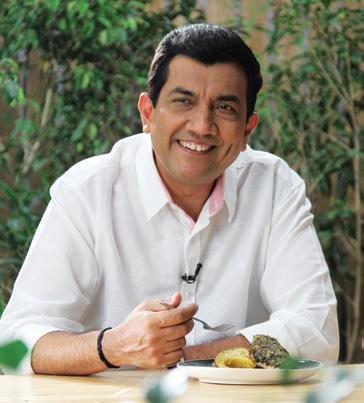
30
Sanjeev Kapoor’s Culinary Crusade The celebrity chef advocates regional cuisine at weddings.

80 From Pitch to Paradise Cricketer Virat Kohli discovers peace and enrichment through family trips and adventures.

116
Oasis at Mumbai Airport Fairfield by Marriott Mumbai International Airport redefines midmarket hospitality.

64
Realness in Modern Hospitality
Pierre Jochem draws attention to authenticity in guest experiences.


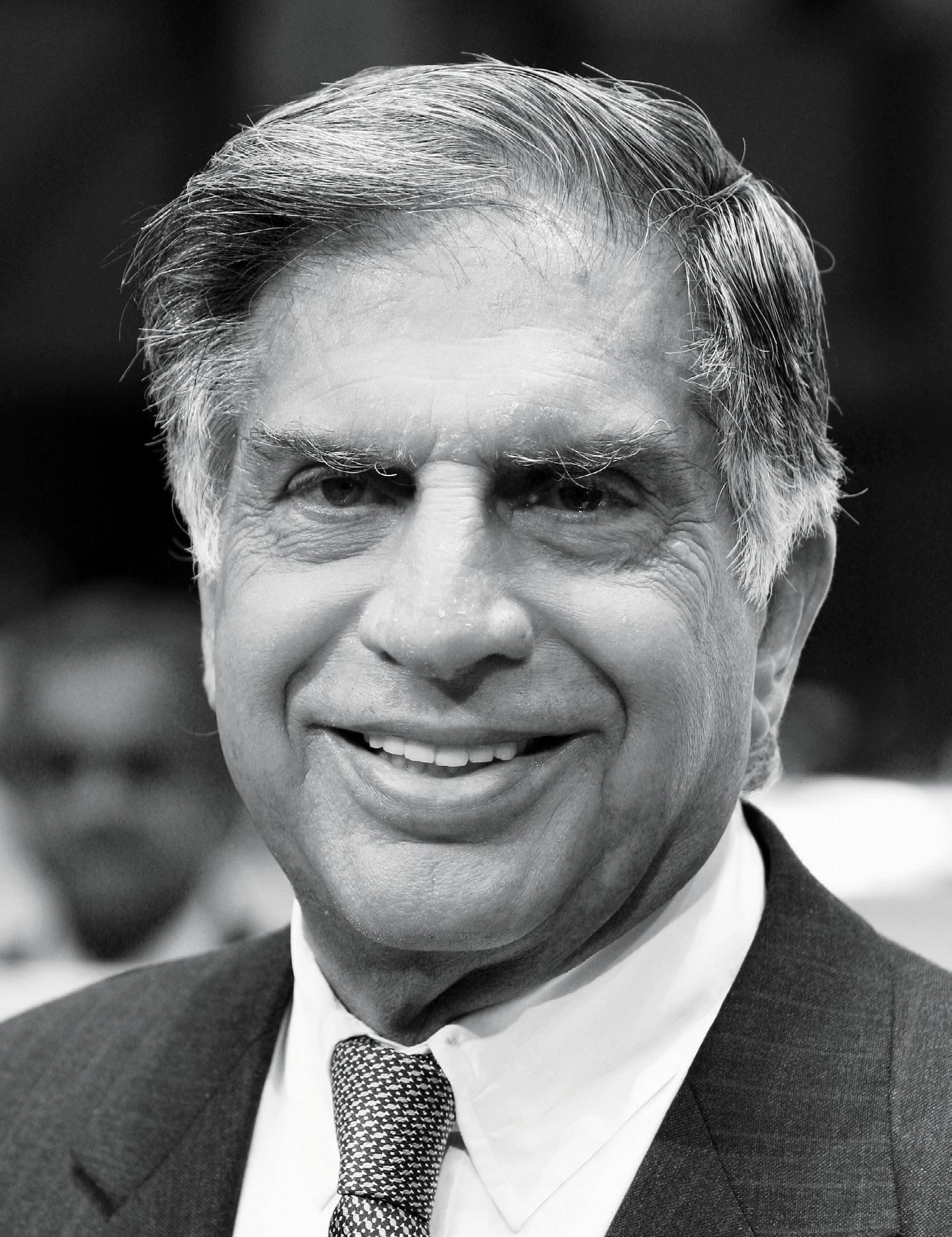
DECEMBER 1937 - OCTOBER 2024
RATAN TATA was the last of the great Indians of modern India, an industrialist whose legacy transcends business. He prioritised people and values, shaping the nation's economic landscape and inspiring generations of leaders.
My most enduring memory of the late Ratan Tata, industrialist, philanthropist and the man who led the Tata Group, is of him holding vigil at the Colaba end of The Taj Mahal Palace, Mumbai for three days, while security forces were engaged in operations against the terrorists on that fateful evening of 26/11. Worried, anxious, tensed and yet determined to see his team and hotel guests who were trapped inside, through.
Amid the attack, Tata, who was then 70, showed tremendous resolve. Among the 166 people killed in the attack were 33 who died in the 60-hour siege at the Tata Group's hotel; these included a few Taj employees.
After the attack, Tata pledged to "rebuild every inch" of the iconic hotel which has played host to maharajas, heads of state, chief executives, movie stars and entertainers alike. Twenty-one months later, The Taj Mahal Palace, Mumbai fully reopened, with its heritage wing receiving guests and scores of people thronging its newly renovated lobbies and restaurants.
He also pledged to take care of the families of those killed or injured in the attack. According to the BBC, Tata paid the relatives of those killed the salaries they would have earned for the rest of their lives. Within months, the Tata Group also formed The Taj Public Service Welfare Trust (TPSWT) to provide humanitarian support during disasters. According to some accounts, Tata himself visited the homes of victims and ensured that they were being taken care of.
The incident was reflective of both, Tata’s humane side, as well as his leadership style—leading from the front, standing by his team and his country.
The Taj Mahal Palace Hotel wasn't just a business asset in his sprawling empire; it held a deep personal resonance. Tata often shared cherished childhood memories of the hotel, weaving a tapestry of nostalgia that underscored his profound connection to this iconic
landmark. For years, the Taj chefs tried to figure out what his favourite cuisine was, but all they knew was that he ‘doesn’t enjoy spicy food.’
He led the Tata Group—known as a salt-to-software conglomerate of more than 100 companies, employing nearly 6,60,000 people—for more than three decades. Tata transformed the company from a primarily domestic conglomerate into a global powerhouse. He spearheaded bold acquisitions like Tetley, Corus, and Jaguar Land Rover. He diversified the Tata Group into new sectors like telecom, automobiles, and information technology, reducing its reliance on traditional industries and ensuring its future growth.
While he was a soft-spoken gentleman, in business he was known to be far more aggressive and a risk-taker. "The biggest risk is not taking any risk. In a world that is changing quickly, the only strategy guaranteed to fail is not taking risks,” he once said.
However, more than what he achieved as an industrialist, India remembers him for his unwavering commitment to corporate governance and social responsibility, and his philanthropy work. Tata Trusts, the philanthropic arm of the Tata Group, is one of the largest charitable organisations in India. It supports various social causes like education, healthcare, and rural development. Its recent project is the Tata Small Animal Hospital in Mumbai, which reflects his passion for all animals, particularly dogs.
Despite his immense success, Tata remained humble and approachable. “If you want to walk fast, walk alone. But if you want to walk far, walk together," he once said, emphasising the power of teamwork and collaboration.
Ratan Tata was a rare exception in an age where CEOs often prioritise outward displays of affluence. His contributions have helped shape the country's economic landscape and inspire future generations of business leaders.
As space becomes a luxury, the hospitality sector might need to stop spreading out and start thinking up. The solution? Go vertical, shrink the footprint, and give guests a sky-high resort experience without sprawling real estate.

RUPALI SEBASTIAN
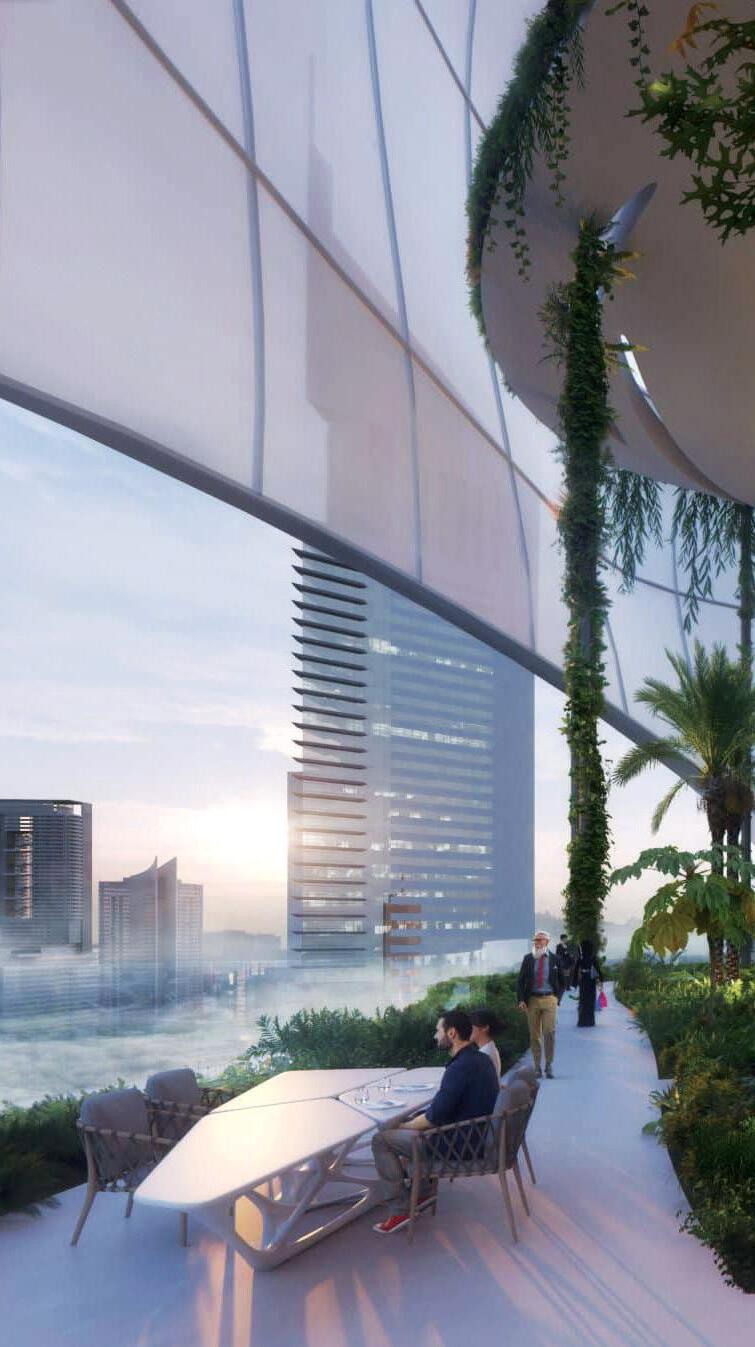


an award-winning concept that offers something for every family member—“just like a typical resort at an exotic destination”. The organic, porous-mantled form “seeks to open up spaces within the structural grid of traditional hotel spaces to interconnect spaces—the city, interiors, exteriors—and, in doing so, form experiences that are unique”. Aera is designed to offer a variety of moods, "with separate active zones and quiet spaces, complete with effective noise isolation or curated sound landscapes”. Within its lush green-studded interiors will be recreational fun for all ages, lavish spa offerings and a multitude of culinary experiences. Folks at OBMI call Aera “an exotic vacation within driving distance of your home, and yet—a world away”.
As cities across the world continue to grow denser, the demand for innovative urban accommodation solutions is skyrocketing. Enter the concept of vertical urban resorts—a new hospitality typology designed to deliver a resort-like experience within the heart of a bustling metropolis. Several factors make the case for vertical urban resorts. One of the most significant is the increasing scarcity of land in major cities, which makes it difficult to develop sprawling resort properties. Vertical architecture allows developers to maximise limited urban space by stacking amenities across
different floors, thus reducing the land footprint while offering a comprehensive resort experience.
Another driving force is the desire to meet the demands of modern travellers who seek convenience, connectivity, and a unique urban experience. For guests, these resorts offer easy access to cultural attractions, dining, and shopping, all within the vibrant setting of a major city. What’s more, vertical resorts will also reflect broader hospitality trends that favour sustainability, as they are in a position to integrate green technology and eco-friendly practices such as energy-efficient systems, rainwater harvesting, and green rooftops.
Architects and designers are certainly thinking about the concept. Global architecture firm OBMI’s Aera Vertical Resort is
That sense of escape is what makes vertical resorts so appealing. The unique experience these resorts offer will be a key attraction. Imagine waking up to panoramic views of a bustling skyline, then stepping out to enjoy a rooftop pool or a world-class restaurant—all without ever leaving your high-rise sanctuary. The interplay between urban energy and resort tranquillity creates an unforgettable stay. It’s an experience already available at One&Only One Za’abeel, Dubai’s first vertical resort.
Designed by Japanese architect Nikken Sekkei, the hotel features two asymmetrical towers connected by The Link, a cantilevered podium housing Dubai’s longest infinity pool, celebrity-chef restaurants, and more. The towers' minimalist, sharp design eliminates peripheral
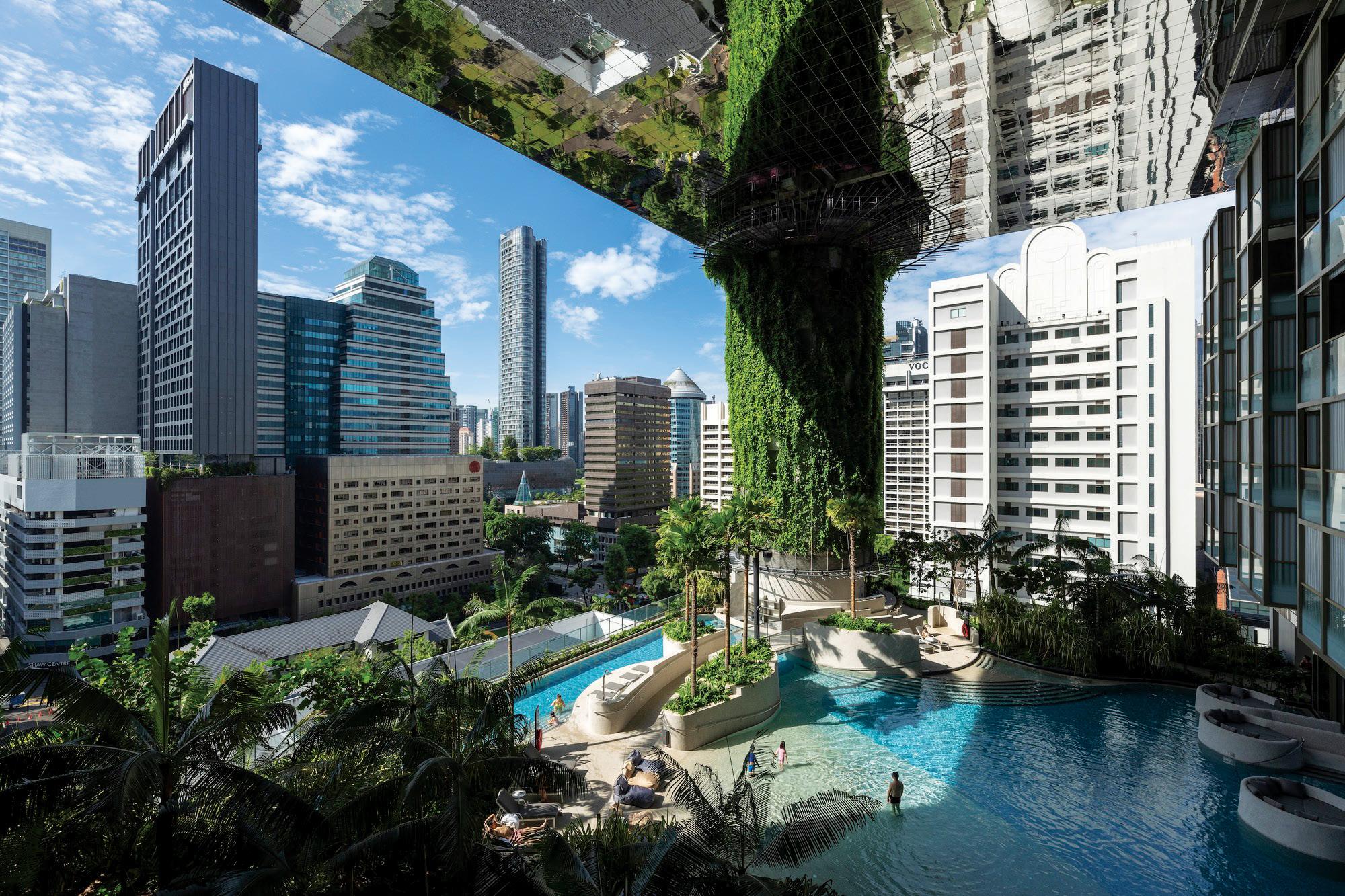

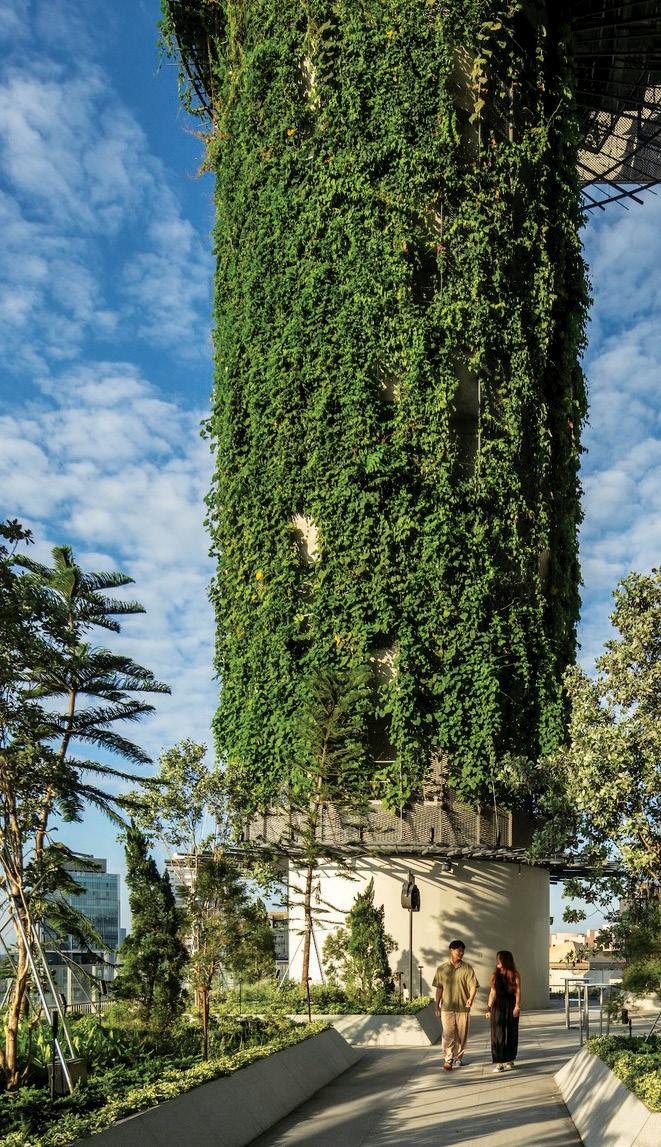



columns, leaving uninterrupted panoramic views. The interiors— designed by Jean Michele Gathy, the creative force behind Aman New York—evoke the flowing of the wind, the dunes, and the sand. The spaces have been left as open volumes to amplify the sense of vastness and to open up to the city beyond.


On the other side of peninsular India, in Singapore, the WOHAdesigned Pan Pacific Orchard hotel has recently been recognised by the Council on Tall Buildings and Urban Habitat (CTBUH) as the world’s best new tall building. The 23-storey, 347-key hotel features open-air tropical architecture and lush greenery spread across its four distinct strata, which house a mix of guest rooms, social spaces, and garden terraces. These terraces, from the ground up, are named the Forest Terrace, Beach Terrace, Garden Terrace, and Cloud Terrace.
The Forest Terrace, at ground level, features a water plaza framed by forest trees, creating a striking, publicly accessible urban link between Singapore's bustling roads. Above, the Beach Terrace is a tropical escape with a lagoon, sandy beachfront, and palm groves floating above the city. The Garden Terrace, next to the hotel’s bar and lounge, offers manicured gardens, reflection pools, and serene views of the Claymore residential estate. At the summit, the Cloud Terrace boasts a landscaped event plaza, a 400-seat ballroom, and reflection pools beneath a photovoltaic canopy. The
interiors reflect the character of each stratum, offering a boutiquescale experience at every level. Designed for Singapore’s equatorial climate—with its warm, humid air, low wind speeds, and unpredictable heavy rainfall— these open-air, cross-ventilated yet sheltered spaces address the challenges of hosting fully outdoor events.
Creeper-clad columns visually connect the four terraces, each with its own unique greenery, replacing 200% of the site area with verdant biodiversity, effectively bringing nature back into the urban environment. Pan Pacific Orchard has incorporated three times the legal minimum greenery required by Singapore’s building regulations.
Described by CTBUH as a “hotel in nature,” the Pan Pacific Orchard transforms the traditional high-rise into a vertical green space, achieving a green plot ratio of over 300%. It has earned Singapore’s Green Mark Platinum rating—the highest environmental certification in the country—thanks to its use of both active systems and passive design strategies that minimise energy and water consumption. Set to become a distinctive garden hotel, it is poised to be a green icon on Singapore’s famed Orchard Road.
As more cities face space constraints and sustainability becomes paramount, vertical resorts are poised to rise—both literally and figuratively—as the future of urban hospitality.


Gen Z's mindful approach to alcohol, with global trends favouring reduced consumption and nonalcoholic alternatives, is now emerging in India. Health-conscious youth are driving the ‘Sober Curious’ movement, spurring the rise of nonalcoholic beverages and low-alcohol innovations.
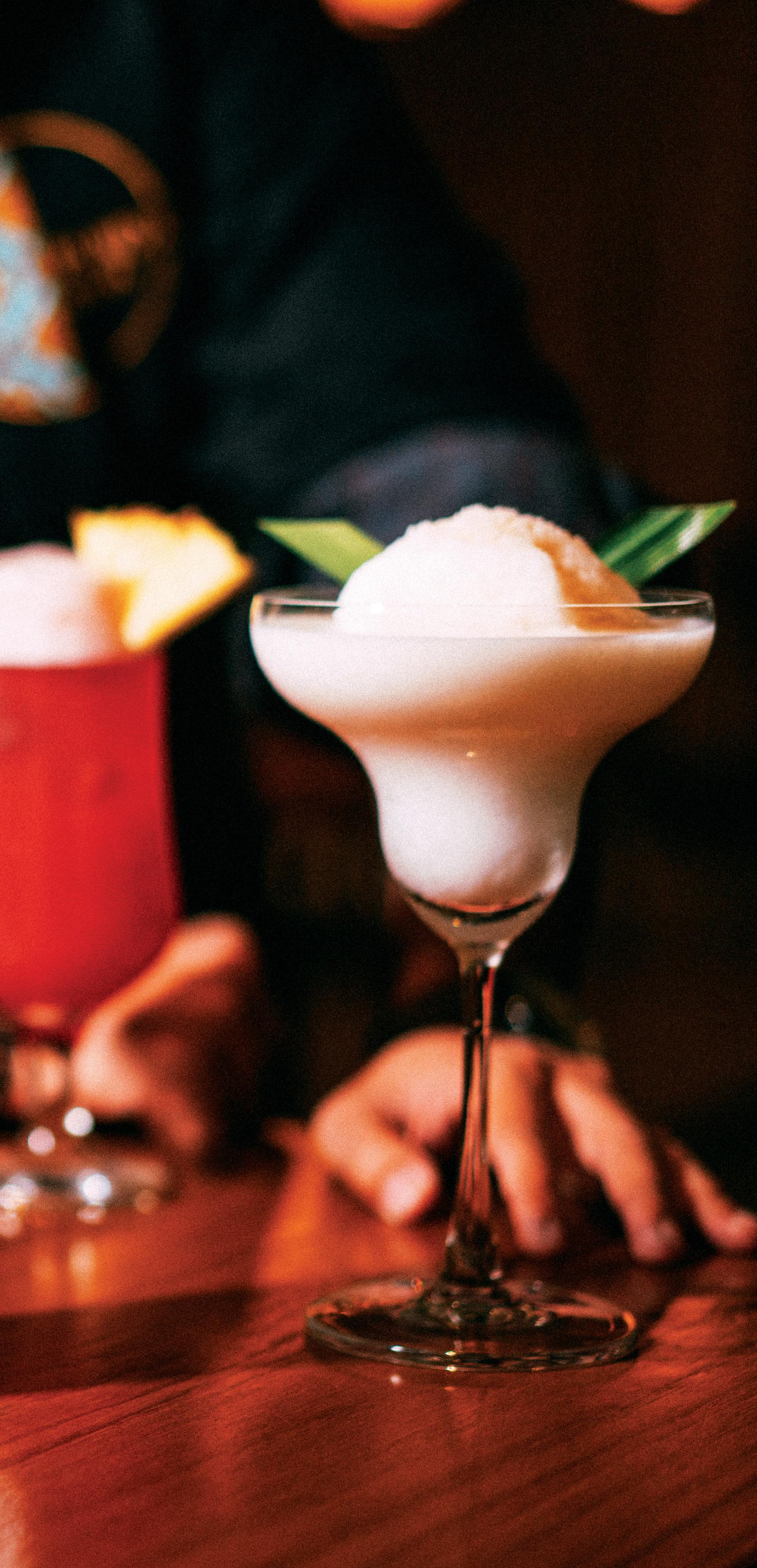
In recent years, global drinking trends have undergone a significant shift, with Generation Z at the forefront of a movement towards moderation, or even abstinence, from alcohol. Often labelled the ‘Sober Curious’ generation, they have significantly reduced alcohol consumption compared to older cohorts. Data from around the world underscores this trend, as Gen Z redefines the traditional relationship with alcohol.
In India, this movement towards mindful drinking is beginning to take hold, particularly among younger generations. While alcohol consumption in the country has historically been lower than in the West, a noticeable change is emerging. Young Indians, especially Gen Z, are making more informed lifestyle choices, with many opting to reduce or eliminate alcohol intake.
The Indian Beverage Association’s 2024 report highlights the growing popularity of nonalcoholic, health-focused beverages among younger consumers, reflecting a broader cultural shift towards wellness and moderation. This is supported by a 2022 survey from the National Institute of Mental Health and Neurosciences (NIMHANS), which noted a decline in alcohol consumption among Indian youth, driven by rising health awareness and the social stigma around excessive drinking.
The COVID-19 pandemic and the influence of social media platforms such as Instagram have played a major role in this shift. Research from the Digital Marketing Institute (2023) found that 70% of Gen Z in India follow health and wellness influencers, further encouraging a move towards healthier consumption patterns.


“The challenge lies in crafting beverages that are not only alcoholfree but also support a balanced lifestyle.”
It’s important to distinguish between being ‘sober curious’ and full sobriety. While alcohol still plays a role in celebrations, Gen Z is increasingly selective about when and how much they drink—a stark contrast to older generations, for whom heavy drinking often symbolised status. This shift is more about intention and mindfulness. “Although socialising has increased multifold, the trend is driven by an increasing focus on wellness and mindful consumption,” says Manoj Padmanaban, Co-Founder of Pandan Club, which won Best Non-Alcoholic Craft Drink at the 30BestBars awards earlier this year. He adds, “This demographic isn’t just avoiding alcohol—they’re also wary of high sugar content, which can undermine their health goals. The challenge lies in crafting beverages that are not only alcoholfree but also support a balanced lifestyle, offering rich flavours without relying on excessive sweetness.”
Building on this, the sobercurious movement in India has taken on a unique flair. “For Gen Z, the focus isn’t solely on abstaining from alcohol; instead, they’re drawn to drinks that are
visually captivating and come with an interesting story or concept,” explains Srishti Sethia, Food & Beverage Manager at Taj Palace, New Delhi. Their preference for Instagrammable experiences and straightforward, innovative ingredients drives the exploration of low-alcohol and non-alcoholic options with as much creativity as traditional cocktails.
Noel Mendes, Food & Beverage Manager - HOD, Four Seasons Hotel Mumbai, highlights how the shift is being embraced across the hospitality industry: “We’ve introduced a dedicated sobercurious menu featuring nonalcoholic cocktails made with house-made syrups and local fruits, catering to this growing demand. However, it’s not just about going alcohol-free—there’s also a rising appreciation for premium spirits like tequila, enjoyed neat for its refined taste and health-conscious benefits, like lower sugar content. This reflects a broader shift towards mindful drinking, where moderation meets quality.”
The brand revolution
Recognising this trend, several brands are responding with innovative, health-conscious lowalcohol and no-alcohol (zero-roof) offerings. Bira 91, known for its craft beer, has introduced Bira 91 Light, a low-calorie beer that caters to this growing demand for healthier options. Similarly, brands like Sepoy & Co. and Svami produce tonic waters and mixers for consumers seeking premium, alcohol-free experiences. Bengaluru-based Mossant Fermentary has taken it further, crafting nonalcoholic fermented beverages, including low-sugar kombuchas in inventive flavours like salted lime, coffee, hops, and cola, and tonic water in versions such as jalapeño and rosemary (which can be enjoyed on


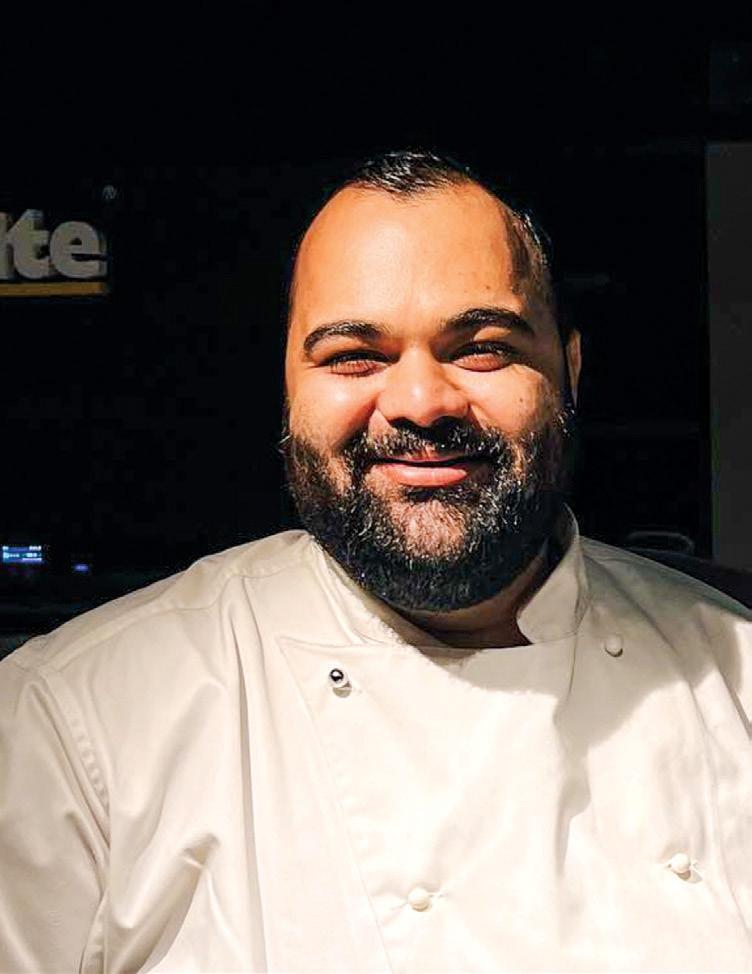
ADITHYA KIDAMBI CEO, MOSSANT FERMENTARY
“Gen Z is more likely to view sobriety or moderate drinking as acceptable, even desirable, and prioritise personal choice over fitting in with the crowd.”
their own), reflecting a broader trend towards healthier, flavourrich alternatives.
Adithya Kidambi, who co-helms Mossant with Shishir Sathyan, attributes this trend to younger people no longer feeling the need to drink to socialise. “They are more likely to view sobriety or moderate drinking as acceptable, even desirable, and prioritise personal choice over fitting in with the crowd. There’s no fear of missing out on the good things anymore.”
Looks like the future of socialising may very well be sober—and stylish.


SOH TRAVEL | DESTINATION

Once a quiet coastal getaway from Vietnam’s largest city, Hồ Tràm quickly emerges as a mega resort destination.
SUMAN TARAFDAR


Yes, taking that unusual movement was the advice I got at The Bluffs, Hồ Tràm. Implementing it made me realise just why it came so recommended.
A glance to the west brought views of a nature reserve, comprising low-rise sandy bluffs overgrown with dense vegetation. Look north, and indeed all around, and you see a stunning golf course, which, when it opened about a decade ago, was termed ‘the most ambitious golf course ever built in Vietnam’. Glances to the east and south, however, are perhaps the most beguiling— pristine beaches with an azure sea beyond, beckoning all to visit this mesmerising corner of the planet.
Indeed, Hồ Tràm, which was till recently a fishing and agricultural community, is conveniently about two hours from Ho Chi Minh City
(HCMC, earlier known as Saigon), the commercial and industrial hub of a rapidly growing economy. Indeed, it is perhaps this new-found wealth that is leading to the transformation of this bucolic village into one of Asia’s leading entertainment destinations, positioned as ‘Saigon’s Beach Paradise’.
With significant infrastructural developments, it is on the way to becoming a resort destination that could well in the near future rival Asia’s integrated entertainment hotspots such as Genting Highlands, Cotai Strip and Marina Bay Sands.
Hồ Tràm is located in Vietnam’s Bà Rịa–Vũng Tàu province, southeast of HCMC. Vũng Tàu, known as a seaside sanatorium for the better part of a century, is regarded as the earliest tourism centre of Vietnam. Hồ Tràm
Attractions in and around Hồ Tràm include (CLOCKWISE FROM TOP LEFT) Minera Hot Springs, Sheep Hill, the Bluffs Greg Norman designed golf course and several temples and museums.
South Vietnam’s reply to integrated resorts in the region is The Grand Ho Tram, known as ‘Vietnam’s entertainment capital’. The complex features three resort towers: The InterContinental, the Holiday Inn Resort and Ixora Ho Tram by Fusion. Together, they provide over 1,200 rooms, including up to 1,100 rooms and suites, 164 residences, and 46 villas. The complex, next to The Bluffs, has 17 F&B outlets, three spas and nine swimming pools.
Known for regularly hosting a range of events, the resort has been owned since 2019 by Warburg Pincus LLC, a private equity firm headquartered in New York City, and is slated to significantly add to its offerings.



Hồ Tràm has one of the most pristine beaches in the country. A small beach community in Vietnam’s Ba Ria-Vung Tau (Bà Rịa-Vũng Tàu) Province, it is frequently described as a pristine beachfront with limited development.
The Hampton’s Pier and Beach offers a number of water-based activities, including, surfing, kite surfing, windsurfing, sailboat, kayak, jet ski rental, banana boat, parasailing, and more.
GOLF
The area already has several golf courses, with the Greg Norman-designed golf course at The Bluffs ranked amongst the top 100 golf courses outside the US by Golf Digest.






The area is surrounded by a rainforest reserve of more than 11,000 hectares, with many a trail to explore.
The local river, Ray, is regarded as one of the most unspoilt rivers in Vietnam. The 55km river is flanked by lush mangrove forests, with colourful fishing boats and spectacular sunset views adding to the charm.
The neighbourhood is dotted with local markets, where you can explore everything from the fresh catch of the day brought in by the Vietnamese version of coracles, round hand-steered boats, to textiles, which the country is famous for. There are several temples, largely catering to local versions of Buddhism. Of course, dining, including seafood options and the increasingly popular Vietnamese coffee, is all around.
is effectively a northeastern extension, but one dominated by a modern builder mindset— mega beachfront resorts, casinos, beaches, golf courses, and, of course, the sea itself, the South China Sea to be precise. Rice fields, lakes and forests create a combination whose rustic charm mingles effortlessly with the lure of five-star comfort.
The upcoming Long Thanh International Airport is scheduled to open in 2026. Designed to reduce the driving time to 40 minutes from the new airport to Hồ Tràm, it is positioned to become an international travel hub. While Hồ Tràm is popular with the Vietnamese, the destination already draws significant numbers of Korean, Japanese, Chinese and Taiwanese guests, attracted by a heady combination of golf and casino amid balmy seaside weather.





ITC’s widely-feted progressive peninsular Indian cuisine restaurant, Avartana, has finally opened its latest edition in the north of India.
SUMAN TARAFDAR


The accolades for Avartana are pouring in— once again to resounding elation as the brand puts its flag in yet another city. The latest outlet of ITC’s trendiest restaurant success now is present in the north of India, as it just opened in Delhi’s ITC Maurya. It has already made its considerable presence felt in all the cardinal directions—the south (ITC Grand Chola, from where it began its journey in 2017), east (ITC Royal Bengal) and west (ITC Maratha), besides ITC Ratnadipa in Colombo.
Before Avartana, reinvented southern Indian cuisine was a figment of imagination. Avartana changed the rules of the game, not only bringing the cuisines of peninsular India under one platform but presenting them in entirely new forms even while retaining the flavours that the cuisines are known for.
At the Maurya, Avartana occupies the space where Tian once was. The 54-cover restaurant (with a private dining room accommodating 10 guests) references the ambience and décor of the earlier iterations. The interiors are dominated by a colour palette of mellow gold, pastel tones, and light-coloured wood, while silver-hued upholstery
LEFT: Avartana not just brought the cuisines of peninsular India under one platform but presented them in entirely new forms.

NIKHIL NAGPAL, EXECUTIVE CHEF, ITC HOTELS
“The food is inspired by the southern peninsula. The ingredients are from the region. The presentation and techniques are very international and modern.”
accentuates the effect, with objets d’art in copper and amber complimenting the soft-edged contemporary décor.
Elegant hemisphere lamps resemble the beloved coconut while light installations reflect the banana flower.
Even the tableware is thoughtfully chosen— rustic earthenware, ornate steel cutlery and contemporary glassware complement immersive indulgence in the magical flavours. All through, the banana leaf stays perched with gold brass accents in geometric patterns.
Nikhil Nagpal, Executive Chef, ITC Hotels, the person credited with conjuring up a storm in Indian gastronomy and who is helming operations in Delhi for the moment, says the word avartana has multiple iterations of meaning, mentioning mysticism and magical rhythm as his preferred choices. Indeed, as a succession of dishes appeared,


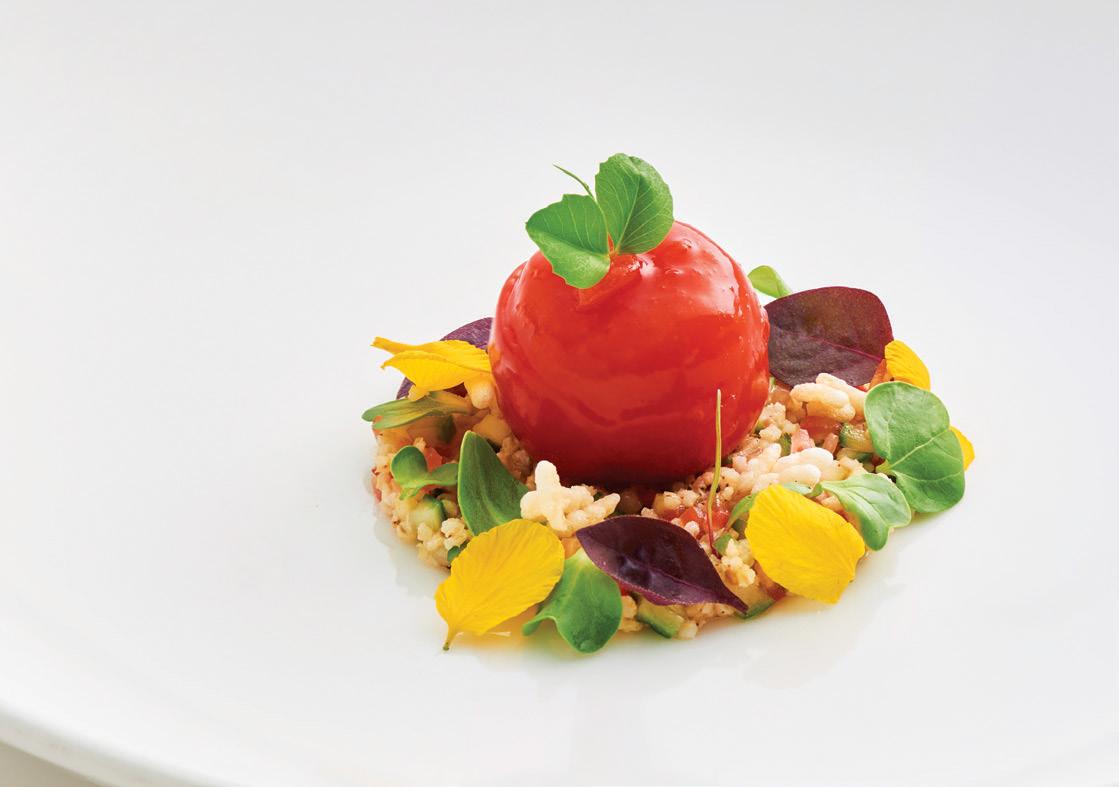
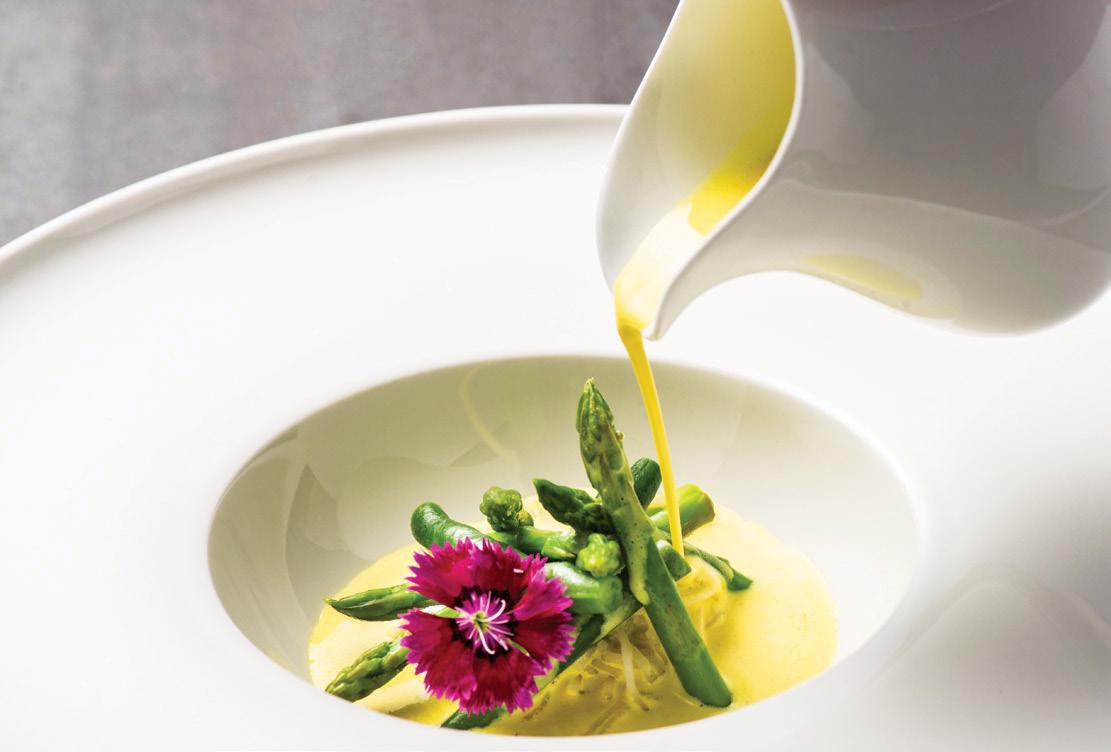
his words only resounded. We were privileged to be invited to experience the restaurant and the menu right after the launch.
With his rather deadpan expression, the chef seems a master of the understatement. “The food is inspired by the southern peninsula. The ingredients are from the region. The presentation and techniques are very international and modern.” None of this prepares us for the stream of seemingly implausibly conjured-up dishes that follow in the next hour or so.
Looking back, the chef says the idea initially for the concept was to create something unique. “It had to be flavours from the region, but it had to be very progressive, very modern. The target (audience) had to be universal. Someone from the region should be able to relate the dishes to the food they usually eat at home. At the same time, someone not from the region should also be able to enjoy it, and not find it too robust. Sometimes, food from the region can be a
little spicy. We elevated those flavours and made it very universal.”
Word to the uninitiated in the world of Avartana— this is a space where you let the chefs do the deciding. The menus are set—five options of set meals, ranging from seven courses to 13 courses, with options for nine and 11-course meals too. Named Maya, Bela, Jiaa, Anika and Tara, they come in vegetarian and nonvegetarian options.
The prices of the menu in Delhi range from ₹3,000 to ₹5,500 for a 13-course menu meal. While the recommended time for a meal is at least 90 minutes, be prepared to budget much longer. For you will be intrigued, will have queries for the server, who, depending on the level of the query, might chivvy the chefs (chef Manish Kakkar is the right person, once chef Nagpal is back in his favourite southern India)— about the ingredients, the techniques, the distillation of the, well, rasam. That is a guaranteed question.

Ditch the sushi, and bring back biryani, Nargisi kofta and Pandi curry to Indian weddings! Chef Sanjeev Kapoor is on a mission.



Chef Sanjeev Kapoor is the pioneer who brought modern Indian cookery shows to our television sets, inspiring generations of home cooks— both men and women. He is also somewhat of an OG celebrity chef, whose immense success paved the way for many other culinary stars.
So when he talks, everyone tunes in.
And right now his pet peeve is the lack of imaginative regional Indian food in lavish wedding spreads.
Indian weddings are a grand spectacle, influencing everything from fashion to music, an integral part of India’s social and cultural fabric.
Yet, despite this deep-rooted cultural presence, the shift in wedding cuisine seems to tell a different story. In an interview with SOH, chef Kapoor says, “Traditionally, weddings in India were showcases of local customs, with everything from attire to food displaying regional heritage. However, a noticeable shift has emerged, particularly in the culinary experience of Indian wedding dinners. These grand feasts are increasingly an international smorgasbord of cuisines. As Indian weddings continue to set cultural trends, particularly for the next generation, the question arises: has the shift towards international cuisines stripped these events of their original character? Should Indian cuisine reclaim its place at the heart of wedding celebrations?”
He acknowledges the profound influence Indian weddings have on society. "Weddings in India are becoming big influencers of
LEFT: India’s diverse culinary traditions should be at the forefront of wedding feasts.
TOP RIGHT: Innovation is key to gaining the attention of the next generation.

what we consume. From fashion choices to music preferences, weddings shape contemporary aesthetics. However, when it comes to food, I see the disconnect. Even today, people are tempted to serve global food, food from Italy and Peru, from different parts of the world." This trend, he believes, undermines the richness and diversity of Indian cuisine.
There is an inherent irony in this trend. India, with its diverse culinary traditions spanning every state and region, should be at the forefront of wedding feasts. If Indian food is to make a global impact, the revival has to begin at home. As chef Kapoor says, “If we are to promote Indian cuisine on a global scale, we must begin by celebrating it at our weddings.”
The shift towards international cuisine at Indian weddings is a missed opportunity to showcase the country's culinary diversity.
India’s culinary diversity is vast, yet many regional cuisines remain underrepresented, especially at high-profile weddings. “The regional cuisines of India are so diverse and underrated. Take the ingredients, for instance. The quality is exceptional, and the local cuisines have evolved beautifully around them. But have we ever really given them the attention they deserve?”
Some areas, such as the northeastern states of India, are virtually unknown on the national food scene, even though they offer unique and flavorful dishes. “The northeastern part of India offers pristine, untouched cuisine, unlike anything people have experienced. Weddings, now theatrical showcases, could be the perfect platform to introduce such undiscovered flavours. In many parts of India, like Rajasthan or even several tribal regions, people dig a pit, put meat on hot stones, cover it and then cook it. When have we seen this kind of food theatre at weddings?” he asks. “Imagine the spectacle if there was space for pit cooking in a wedding feast.”
Similarly, regions such as Gujarat are often pigeonholed into specific categories. For example, while the state is renowned for its vegetarian fare, its coastal areas produce some of the finest seafood in India—yet this is rarely represented at weddings. The same holds for states like Telangana and Andhra Pradesh, where vegetarian and non-vegetarian options abound, but are often overlooked in favour of more popular, mainstream meat-based dishes. “Just recently, I was discussing tribal food with our Honorable President Droupadi Murmu. The mushrooms
As weddings become increasingly important sources of revenue for hotels and caterers, there is strong demand for innovation and excellence in the wedding food market. While people often host extravagant weddings at luxury hotels, they outsource the catering. Many hotels stick to tried-and-tested menus, often missing out on the opportunity to create a truly special culinary experience. “The talent in hotels is phenomenal,” says chef Sanjeev Kapoor, “but the hunger for innovation often lies with the independent wedding caterers.”
His call to action is clear: chefs and hoteliers must step out of their comfort zones and embrace the challenge of creating innovative and authentic Indian wedding menus. "Don't be complacent. The world outside the hotel is changing very fast. The wedding industry is evolving quickly, and there’s a need to push boundaries and bring fresh ideas to the fore. Collaboration between hotel chefs and independent caterers could be the key to unlocking new culinary experiences for wedding guests.”
For example, at his daughter's high-profile wedding, he encouraged the Taj Hotels chefs to innovate. “The result was a stunning display of talent and creativity, showing that hotels can compete with the best independent caterers—if they embrace the challenge.”

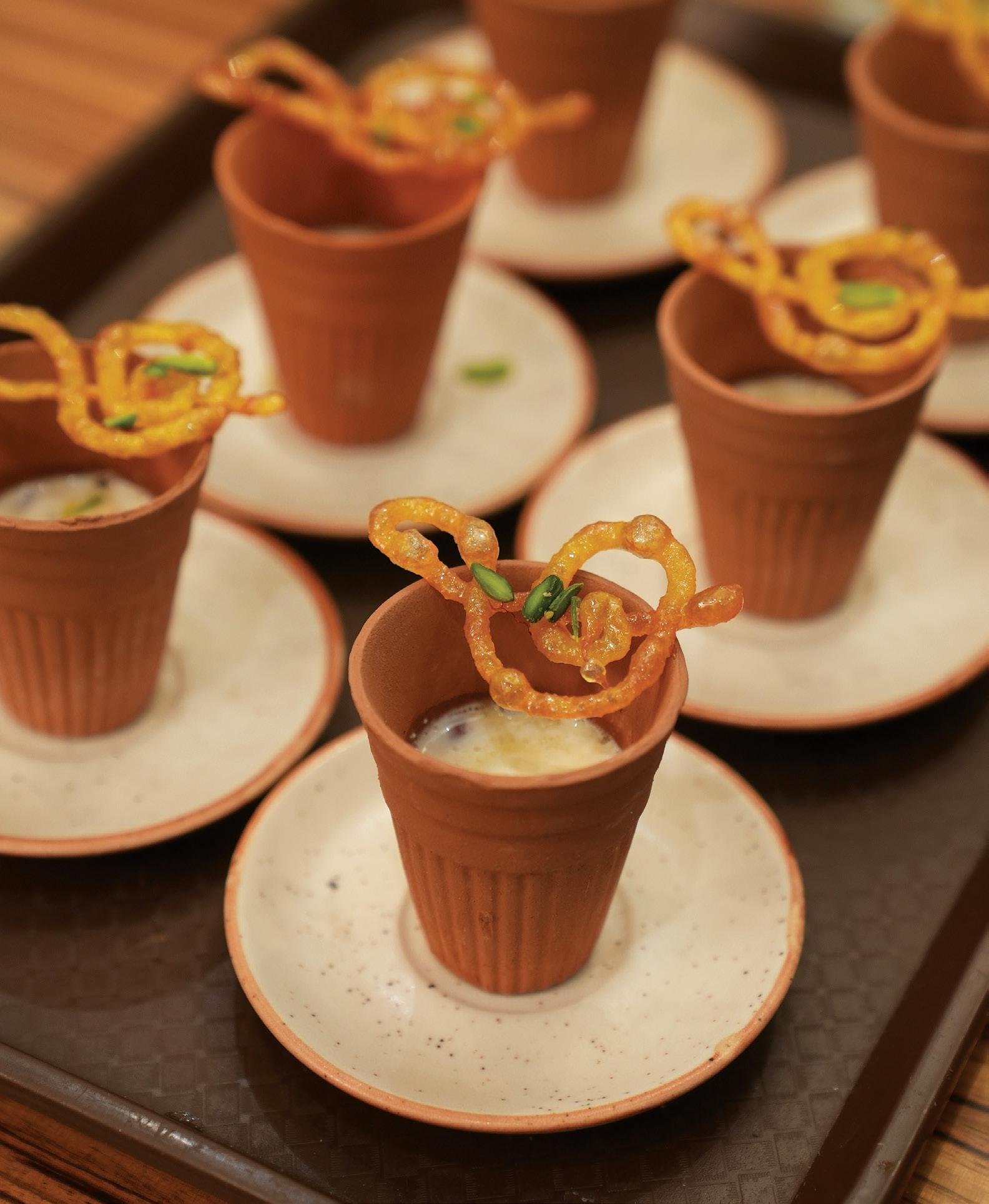
found in forests are truly exotic and valuable. Yet, we limit ourselves to button mushrooms or maybe some Japanese varieties. There's so much more to discover in our indigenous ingredients, and unique cuisines have developed around them.”
By bringing these lesserknown culinary gems to the forefront, Indian weddings can regain their uniqueness and cultural significance.
While tradition is essential, innovation ensures that Indian cuisine will stay relevant. “Food evolves; it is dynamic in nature,” says chef Kapoor. “For chefs, creativity is paramount. What was considered good in the past may no longer be relevant. Relevance comes through innovation.” He underscores the importance of marrying tradition with modern techniques and presentations.


Major events, such as the much-talked-about Ambani wedding, have had a considerable impact. Not only did it showcase the grandeur of Indian design and decor, but it also reaffirmed that Indian culture remains at the forefront of these ceremonies. “The food served had a lot of regional Indian culinary references, which I am sure will reintroduce Indian food to wedding banquets.”
Chef Kapoor's passion for Indian food and influence in the industry make him the perfect man to lead this culinary revolution. To foster culinary thought leadership in weddings, he has launched initiatives such as India Gourmet Lux, which, in its second edition, was hosted in Mumbai.
This gathering brought together top wedding planners, decorators, caterers, hoteliers, and restaurateurs, each with a vested interest in elevating the status of Indian cuisine at weddings. The event served as a networking platform for wedding stakeholders and provided a space for thought leadership. The aim was to create a buzz around Indian food, encouraging chefs and caterers to innovate and integrate regional specialities into wedding menus.
“Wedding feasts offer an opportunity to restaurants, for instance. Yet, even top-end restaurants may not know how to approach Indian feasts since they do not exist in the wedding ecosystem and have no experience. Several hotels and corporate catering companies have yet to integrate themselves into the wedding ecosystem. The conclave hopes to introduce them to the entire ecosystem, so they can develop systems that will allow them to cater to weddings.”
India needs to create luxury experiences around Indian food, he contends. “We must make it aspirational—just like how designers such as Sabyasachi have made traditional Indian attire trendy again.”
“India needs to create luxury experiences around Indian food. We must make it aspirational—just like how designers such as Sabyasachi have made traditional Indian attire trendy again.”
Chefs and caterers are already experimenting with Indian ingredients, marrying them with contemporary cooking styles to create fusion dishes that resonate with younger generations. This balance between tradition and innovation is key to keeping Indian cuisine fresh and exciting, especially in an industry as fastpaced as weddings.
By celebrating regional flavours and fostering innovation, Indian wedding feasts can showcase the country’s culinary heritage. Whether through forgotten regional dishes or modern interpretations of classic recipes, Indian food deserves to reclaim its rightful place at the centre of wedding celebrations.
Chef Kapoor's vision for Indian wedding food is one of celebration, innovation, and cultural pride. He maps out a future where weddings become a platform to showcase the diversity and richness of Indian cuisine, influencing not just the wedding industry but what we eat at home. “Out-of-home, food influences in-house consumption, too. By reintroducing Indian food to Indian weddings, we can not only revitalise our culinary traditions but also create a ripple effect that influences how we eat and celebrate at home.”


Billion-dollar IPOs are just the tip of the iceberg. Over $413 million total investment is projected to flow into India's hospitality sector by FY’28. From sleek city hotels to midmarket developments in Tier II, III and IV cities and resort destinations, investors are betting big on the country's travel and hotel boom.
The Indian hospitality industry is abuzz with activity, marked by a wave of billion-dollar IPOs and fierce competition to dominate the luxury segment, as well as build mid-market hotels across Tier II, III and IV markets.
The Leela Group's parent company, Schloss Bangalore, is driving this trend with a planned ₹5,000 crore IPO (approx. $599 million), set to be the largest in the sector’s history. Structured as a fresh equity issue and an offer for sale by a Brookfield Asset Management-associated shareholder, the funds will be used to reduce debt, support corporate initiatives, and fuel expansion. A consortium of 11 merchant bankers, including JM Financial, Morgan Stanley, JP Morgan, and Kotak Mahindra Capital, is managing this landmark IPO.
Ventive Hospitality, a joint venture between Panchshil Realty and Blackstone, is launching a ₹2,000 crore IPO. As the largest hospitality platform promoted by a real estate developer in India, Ventive owns 17 assets under brands like JW Marriott, Ritz-Carlton, and Anantara. The IPO will solidify the group's position as the third-largest in the sector by EBITDA after IHCL and The Oberoi Group.
StayVista, a luxury villa rental company, plans a ₹600 crore IPO by 2028, aiming to double its villa network from 1,000 to 2,500 within two and a half years. Co-founder Amit Damani projects revenue of ₹196 crore and a profit of ₹4 crore. StayVista is tapping into the growing demand for short trips and weekend getaways, with plans to expand into Uttarakhand, Himachal, Kashmir, Varanasi, and Ranthambore, targeting weddings and corporate events. This aligns with the homestay boom and the expansion of hotel chains into Tier II, III, and IV cities.
Improving market sentiment is paving the way for resurgence in large hotel IPOs.
While Brookfield and Panchshil are entering the space, companies like Chalet and SAMHI have already witnessed success, says Jaideep Dang, Managing Director – Hotels & Hospitality Group, JLL. Anuj Puri, Founder and Chairman of ANAROCK, notes that Chalet Hotels and Lemon Tree Hotels went public successfully before the pandemic, while SAMHI Hotels, Apeejay Surrendra Park Hotels, and Juniper Hotels have recently followed. “With The Leela Hotels announcing the largest IPO in India’s hotel sector, this trend is expected to gain more momentum,” he says. Past
successful IPOs include K Raheja Corp’s Chalet Hotels, Apeejay Surrendra Park Hotels, and SAMHI Hotels (see box).
The rise of hospitality IPOs is a positive trend. “It frees up capital, allowing companies to reinvest in assets or pay down debt, creating opportunities for further growth,” says Vijay Thacker, Managing Director, Howarth HTL India.
Nikhil Shah, Senior Director - Capital Markets & Investment Services at Colliers, adds that IPOs provide crucial equity and patient capital, enabling efficient capital structures and long-term development. “Unlike private equity funds with shorter investment horizons, IPOs offer a more stable financial foundation for capital-intensive industries such as hospitality. This keeps investor interest high and benchmarks valuations,” he explains.
IPOs help hospitality companies achieve the scale needed to compete in a rapidly evolving market. As Puri notes, “Funds raised can be used for new hotel developments, property renovations, and acquisitions, fuelling expansion into untapped markets. They also deleverage balance sheets, creating financial stability and offering exit strategies for early investors.”
The capital infusion also allows companies to renovate properties and adopt cutting-edge technology to enhance the guest experience. Shah adds, “The influx of funds enables infrastructure investment, improving operational capabilities, facilitating market penetration, and the de-leveraging of balance sheets, paving the way for further expansion.”
Beyond access to funds, IPOs reduce debt reliance, fostering financial sustainability. With

stronger financials, hospitality companies are not just surviving— they’re thriving. Puri notes, “Hotel companies with significant property ownership or high CaPex requirements can use IPO proceeds for expansion and renovation without incurring additional debt, providing financial muscle and enhancing sustainability.” Shah explains, “Many operators have used IPOs to lower debt, leading to healthier financial structures and enhanced long-term growth.” By alleviating the need for debt, IPOs shorten the lengthy gestation periods typical of hotel investments, creating financial flexibility and healthier balance sheets.
*This value does not include the Rajesh Lifespaces deal, which was dismissed by NCLT earlier this vear
IPOs also attract domestic and international investors, fostering competition and innovation. From an investor’s perspective, IPOs create opportunities for shareholder exits. “Given the high CaPex requirements and valuations in the hospitality sector, IPOs offer an essential avenue for investor exits, which can be challenging to achieve through private equity alone,” says Puri.
Moreover, IPOs instill market confidence, signaling growth potential. This can boost share prices, improve financial outlooks, and offer flexibility for new opportunities. The scrutiny of being publicly traded also forces higher operational efficiency and governance. Shah adds, “This increased scrutiny often leads to improved governance and operational accountability, fostering trust among investors and promoting a more structured approach to business management.”
However, companies need to be prepared for this level of transparency. Thacker suggests, "Those uncomfortable with public scrutiny might prefer staying private—not necessarily for lack of transparency, but to maintain greater control and avoid the pressure of meeting quarterly expectations."
Successful IPOs underscore the growth of India’s hospitality sector, attracting investors with the promise of high returns. Dang cautions, though, “While IPOs bring liquidity, capital, and market maturity, stock price sustainability remains uncertain. Some companies with mediocre asset quality have seen stock market success, indicating a potential lack of investor understanding of the hospitality asset class, which is physical, not software or service.”
The Indian hospitality sector is booming. The Indian Hotels Company Limited (IHCL) joined the trillion rupee club on 13th September, 2024, becoming the eighth Tata Group company to achieve a market capitalization of ₹1 lakh crore. IHCL is India's largest hospitality company, with a portfolio of 326 hotels across 13 countries and four continents.
Other Indian hospitality groups, from The Oberoi Group to SAMHI, Radisson and Marriott are on an expansion spree through strategic investments.
“2024 is expected to witness the highest trading activity yet in the hotel investment sector. Trading numbers are already up by 30% compared to last year, which itself saw a significant increase compared to the previous
Vijay Thacker
MANAGING DIRECTOR, HOWARTH HTL INDIA
90,000 rooms will be built over the next four years with an estimated investment of ₹70,000 to ₹90,000 crores. Even with 60% debt financing, an equity investment of ₹30,000 to ₹36,000 crores is needed—excluding land costs.

IN QUARTER 1 (Q1), 2024, INVESTMENT IN INDIA'S HOSPITALITY SECTOR: $93 MILLION.
19,440 KEYS SIGNED IN THE FIRST HALF OF 2024.
44% INVESTMENT IN THE UPSCALE SEGMENT, FOCUSING ON OPERATIONAL ASSETS IN TIER I CITIES AND LEISURE MARKETS.
44% TRANSACTIONS IN THE UPPER UPSCALE SEGMENT, 31% IN MID-SCALE, 23% IN LUXURY, AND 3% IN ECONOMY.
LISTED HOTEL COMPANIES DOMINATED, ACCOUNTING FOR 44% OF THE TOTAL TRANSACTIONS VOLUME, FOLLOWED BY OWNER-OPERATORS (30%), AND HNIs, FAMILY OFFICES AND PRIVATE HOTEL OWNERS (26%)
Source: Hotel Investment TrendsIndia H1 2024 report, JLL
26% OF TRANSACTIONS ARE MADE BY HIGH NETWORTH INDIVIDUALS (HNIs), FAMILY OFFICES, AND PRIVATE HOTEL OWNERS.
22% INCREASE IN INVESTMENT FROM 2023 IN TIER II AND III CITIES. 83% OF TOTAL SIGNINGS ARE IN THESE CITIES.
30% OF TRANSACTIONS BY EXISTING HOTEL OWNERS.
$413 MILLION PROJECTED TOTAL INVESTMENT VOLUME FOR THE HOSPITALITY SECTOR IN 2024.
NEARLY 83% OF THE BRANDED HOTEL SIGNINGS IN TERMS OF KEY COUNT ARE CONCENTRATED IN TIER II AND III CITIES.
TIER I MARKETS REMAIN A STRONGHOLD FOR TRANSACTION ACTIVITY, ACCOUNTING FOR 78% OF THE EXPECTED TRANSACTION VOLUME FOR THE REST OF THE YEAR, FOLLOWED BY TIER II AND III CITIES ACCOUNTING FOR 22% OF THE TRANSACTION VOLUME.
72% WERE RELATED TO OPERATIONAL HOTELS, 23% WERE UNDERCONSTRUCTION HOTELS, AND THE REMAINING INVOLVED LAND LEASES.
AS OF JUNE 2024, BRANDED HOTEL SIGNINGS STAND AT 19,442 KEYS, ACCOUNTING FOR 77% OF THE TOTAL NUMBER OF KEYS SIGNED IN 2023.
two decades. This industry-wide trading volume, often referred to as the ‘industry trading volume,’ has grown substantially,” says Dang. “JLL is leading the pack, capturing over 60% of the market thanks to its dedicated hotel capital markets expertise.”
Competitors such as CBRE and Cushman & Wakefield lack a specialised hotel capital markets business, which limits their participation to other asset classes like shopping malls and offices. Smaller competitors focus on management and operator contracts but do not engage in investment sales.
India's hospitality investment landscape has shifted significantly in recent years, driven by growing demand for quality accommodations and the sector’s improving performance. “Investments vary across segments, influenced by services, amenities, and the overall quality of interiors," says Puri. "HVS
ANAROCK estimates over ₹55,000 crores will be invested in upcoming supply (more than 59,000 keys) by FY’28.”
Investment activity remains robust, with $93 million flowing into the sector in the first half of 2024, and a projected total of $413 million for the full year—a 22% increase from 2023, according to JLL’s Hotel Investment Trends – India H1 2024. (See box for more details). ICRA’s latest report paints a positive outlook for India's hotel industry. FY’24 is expected to close with 14-16% revenue growth, with FY’25 forecasted to grow at a moderated pace of 7-9%. Growth is driven by domestic leisure travel, a strong MICE sector, business travel recovery, and emerging trends like spiritual tourism and Tier II city development.
Thacker says projections indicate an additional 90,000 rooms will be built over the next four years, representing a 40-45% expansion, with an estimated investment of ₹70,000 to ₹90,000 crores (say around $10 billion). “Even with 60% debt financing, a significant equity investment of ₹30,000 to ₹36,000 crores is needed—excluding land costs.” The numbers slightly vary depending on who you speak to, but the projection couldn’t have been more similar.
The near-zero cash flow environment of 2020 severely impacted hotel investments, but recovery began in 2021, with investment activity reaching $133 million. Consolidation became a key theme, driven by strategic investments and partnerships aimed at achieving scale and portfolio diversification—a trend that continues through 2024.
Occupancy rates for premium hotels are predicted to reach decadal highs of 70-72% in FY’24 and FY’25, while Average Room Rates (ARRs) are projected at ₹7,800-8,000 in FY’25. Though some areas have surpassed pre-
HNI/FAMILY OFFICES/PRIVATE HOTEL OWNERS 26%
OWNER OPERATOR 30%
LISTED HOTEL COMPANIES 44%
Source: Hotel Investment Trends - India H1 2024 in review, JLL
2008 peak rates, overall Revenue Per Available Room (RevPAR) is expected to recover to those levels by FY’25. On the supply side, a 4.55% compound annual growth rate (CAGR) is expected in the medium term. However, demand continues to outpace supply, driving new project announcements and the revival of previously stalled developments.
India’s hospitality sector is closely tied to the country's economic health and the strength of its tourism and real estate sector.
Domestic travel demand continues to surge, driven by infrastructure growth in both business cities and leisure destinations. Domestic tourist visits are expected to double by 2030, reaching 5.2 billion, according to HVS ANAROCK research. This surge is driven by rising disposable incomes, the
Anuj Puri
FOUNDER AND CHAIRMAN OF ANAROCK
growing number of HNIs, and improved last-mile connectivity through advancements in air, road, and rail infrastructure. The development of new tourist destinations is also contributing to this growth.
On the inbound tourism front, India is increasingly attractive, thanks to its cultural heritage, improving infrastructure, and government initiatives like tourism circuits and visa reforms. “Foreign Tourist Arrivals (FTAs) show strong post-COVID recovery, with 2024 projections nearing 10 million. Leisure travel accounts for much of this growth, with 46% of FTAs in 2023 driven by holidays and recreation,” says Shah.
The surge in activity isn't happening in a vacuum. “The healthy travel indicators have led to stable occupancy levels and significant increases in room rates. Although room rates are expected to plateau depending on market conditions, gross operating profits (GOPs) remain robust, maintaining a high yield on investments. Hotels are enjoying high occupancy rates and are able to command top dollar for their rooms. This translates to robust profitability, making hotels a hot commodity for investors seeking lucrative returns,” says Dang.
This profitability drives the demand for high-yielding operating assets, but as hotel prices increase, yields may start to compress. Investors will need to adjust to this reality, as higher prices could impact the number of trades. While fewer assets may be traded, the volume and value of transactions will remain high as quality assets continue to attract investment interest.
“Despite this momentum, India currently has around 225,000
“
Given the high CaPex requirements and valuations in the hospitality sector, IPOs offer an essential avenue for investor exits, which can be challenging to achieve through private equity alone.”

StayVista is planning to list on stock exchanges by 2028 when it expects to reach a revenue of ₹600 crore, as the luxury villa rental company seeks to expand its network in the country.
rooms (compared to 125,000 rooms in Bangkok and 110,000 in New York), says Dang. “There is ample room for growth. The booming air travel sector further supports this, as increasing demand for accommodations will keep the market buoyant even during slower economic cycles.”
The first half of 2024 has set the stage for a dynamic hotel transactions landscape, and the momentum is expected to continue.
India's hotel investment sector, fuelled by 80% year-on-year growth in Q1, is poised for a strong 2024. Transactions are expected across diverse segments, from prime city locations to emerging markets and airport districts.
“The luxury segment continues to attract significant investment, representing just 13% of upcoming keys but accounting for 24% of total investment, or ₹13,200 crores. The upper upscale segment, making up 20% of the pipeline, will capture 26% of total investment amounting to ₹14,500 crores,” says Puri. “The upscale segment follows with ₹11,800 crores, while midscale and economy segments, despite comprising 45% of the supply, will attract ₹15,500 crores in investment due to lower CapEx per key. Notably, large-scale ‘big box’ developments like Fairmont Mumbai (646 keys), Marriott Marquis Delhi (590 keys), and Vivanta Bengaluru (450 keys) highlight the focus on highcapacity, premium hotels.”
Shah notes that luxury is seeing the highest influx of investments, driven by the absence of rate caps and its resilience during

industry upcycles. “Investors are particularly interested in boutique experiential hotels and resorts, although premium and budget accommodations also attract investments.”
Hotelivate’s 2024 Indian Hospitality: Trends & Opportunities report identifies Bengaluru as the largest hotel market in India by inventory. “The city’s rebound was aided by numerous events during India's presidency of the G20 summit. The inauguration of the new terminal at Kempegowda International Airport in late 2022-early 2023, positioned the airport as the third largest in India, with a capacity of 52 million passengers per annum which further aided the market’s overall recovery. Traditionally one of the strongest corporate markets in the country, 2023/24 saw hotels focus on M.I.C.E. demand in order to diversify segments and reduce reliance on contracted business.”
Among the other metros the report mentions is Hyderabad because of its “growing role in the IT sector, biotechnology, medical tourism, and as a centre for multinational corporations” which is fuelling substantial demand for commercial space, hotels, and leisure resorts. “The lack of supply in Hyderabad's hospitality and commercial real estate market is a growing concern,” the report states, “but it also presents major opportunities.”
Jaipur's hotel market is driven by leisure and M.I.C.E. demand. “Despite a shallow corporate base and low per diems, the demand for hotel business remains healthy. This has led to a predominance of budget to upper midmarket positioned hotels within this area, even among proposed projects. However, palaces and resorts catering to the high-yielding leisure and M.I.C.E. business, especially social M.I.C.E., have boomed in recent years. These resorts have seen a sharp increase in average rates. This has generated significant developer interest in developing M.I.C.E.-focused resorts in the Kukas and Sitapura belts and (on the) outskirts of the city.
Beyond metros, Tier II, III, and IV cities are emerging as attractive markets for new supply, catering to domestic tourism and business travel. Cities like Indore and Coimbatore are seeing rising demand,
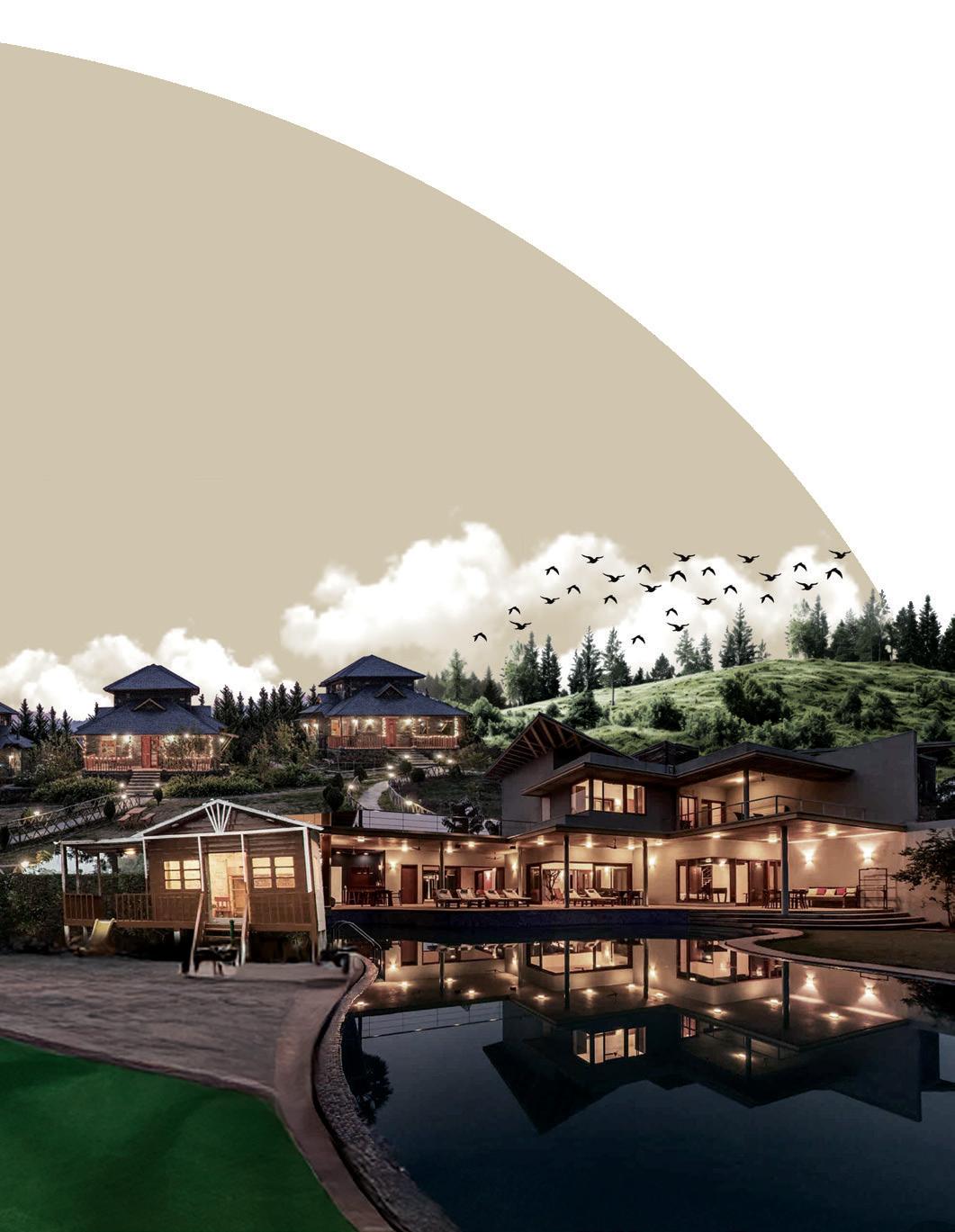
offering first-mover advantages and capitalising on government initiatives promoting sustainable tourism and easing land acquisition.
Thacker says, “Over 60% of the new supply is planned for Tier II and Tier III cities, in smaller towns and pilgrim centres, ensuring a healthy distribution of growth across the country. This strategic spread will help alleviate potential oversupply issues in major markets while promoting tourism and business travel in emerging destinations.
“By catering to a wider range of destinations and focusing on mid-scale hotels in emerging locations, the sector maintains a balance between supply and demand.” There are several niche tourism segments that are offering new opportunities to developers and investors.
“Development in Tier II and III cities is being driven by niche tourism segments like wildlife, adventure, and religious tourism, as well as corporate travel fuelled by India’s growth as a global manufacturing hub and the growth of SMEs,” says Puri.
375,000
THE PIPELINE FOR THE NEXT FOUR YEARS ESTIMATES AROUND 375,000 QUALITY HOTEL KEYS ACROSS VARIOUS SEGMENTS, WITH APPROXIMATELY 170,000 OF THESE KEYS AFFILIATED WITH BRANDS OR CHAIN HOTELS.
59,000
₹55,000 CRORE IS EXPECTED TO BE INVESTED IN MORE THAN 59,000 KEYS BY FY’28, OF WHICH 13% OF KEYS WILL BE IN THE LUXURY SEGMENT AND 20% IN THE UPPER UPSCALE SEGMENT.
14,500
24% OF THE EXPECTED INVESTMENT, AMOUNTING TO OVER ₹13,200 CRORE, IN THE LUXURY SEGMENT, AND 26% OR OVER ₹14,500 CRORE IN THE UPPER UPSCALE SEGMENT.
11,800
21% INVESTMENT IN THE UPSCALE SEGMENT, VALUED AT OVER ₹11,800 CRORE.
15,500
28% OF THE INVESTMENT AMOUNTING TO ₹15,500 CRORE IN 45% OF THE PIPELINE SUPPLY COMPRISING MIDSCALE AND ECONOMY SEGMENTS.
Source: Anuj Puri, ANAROCK
Shah contends that development in metro areas has become saturated due to high land prices, making it economically challenging. Government initiatives promoting sustainable tourism and simplifying land acquisition further incentivise greenfield development. “In contrast, Tier II and Tier III regions often lack branded inventory, and these markets present significant opportunities, particularly for MICE and weddings, which can serve as strong revenue drivers.” This diversified investment approach reflects the industry's adaptability to the evolving demands of travellers.
Hotelivate’s report talks about the possibilities offered by the Indore market, “primarily driven by commercial demand from the automobile, manufacturing, and financial sectors. This has led to significant resident and non-resident demand for meetings, conferences, as well as wedding ceremonies. Additionally, Indore's proximity to Hindu pilgrimage sites such as Ujjain and Omkareshwar contribute to leisure demand in the market. While the city hosts several international hotel brands catering to various market segments, the number of accommodated room nights is expected to more than double over the next five years.”
In a market as vibrant as this, there is always a risk of bad investment decisions unfortunately. “Fast-moving markets often lead to mistakes, particularly when investors lack deep knowledge of the cyclical nature of the industry,” says Dang. “JLL advises clients carefully, emphasising the importance of making informed decisions based on long-term assumptions to avoid painful losses.”
The big-ticket investments
There have been several big-ticket transactions recently. JLL itself has
MANAGING DIRECTOR – HOTELS & HOSPITALITY GROUP, JLL
“ 2024 is expected to witness the highest trading activity yet in the hotel investment sector. Trading numbers are already up by 30% compared to last year. This industry-wide trading volume has grown substantially.”
been riding the wave, recently closing a series of deals worth over ₹800 crores (over $100 million). This includes the landmark sale of the Holiday Inn in Mumbai for a staggering 450 crores—the largest single hotel asset sale in India's history. “Beyond trading, JLL is also facilitating greenfield investments, such as the Goa GMR Mopa Airport monetisation project, where we have successfully brokered deals for four out of five available plots, including Ginger and Emcalm Lounge.”
It’s important to distinguish between greenfield investments and trades. Greenfield investments involve building hotels from scratch, whereas trades refer to the sale of existing hotels. “In this sector, JLL leads in facilitating the transfer of ownership between sellers and buyers, with the National Company Law Tribunal (NCLT) acting as an alternative in cases of financial distress,” says

Source: Hotel Investment Trends - India H1 2024 in review, JLL
Dang. According to the JLL report, investor preferences reveal that operating assets appear more attractive than greenfield projects.
Dang says that the market is witnessing a surge in liquidity from other avenues. “Banks, buoyed by the sector's strong performance, are opening their coffers to hotel investors.
Meanwhile, several Indian hotel companies have taken the IPO route, signaling growing maturity and attracting even more capital into the market.” JLL expects the rest of 2024 to benefit from favourable land trends. Going by the listed hotel companiesled transactions in the first half of 2024, the upscale segment has claimed the highest share of the total transaction volume (44%), followed by mid-scale (31%), luxury (23%), and economy (3%).
Shah emphasises the significant investments flowing into various segments, including greenfield, brownfield, and operational hotels. Notable transactions include Oyo's $525 million acquisition of Motel 6 and Chalet Hotels' purchase of the Courtyard by Marriott Aravali. “Additionally, significant projects include an upscale Marriott
hotel at Bengaluru Airport and a midscale hotel with over 200 rooms in Mumbai.” He estimates the total investment in the sector to be around ₹350 billion, with approximately 70,000 rooms in the pipeline over the next four years.
Despite the increase in supply, demand continues to outpace availability, particularly in key markets like Mumbai, Delhi, and popular leisure destinations. These areas are experiencing high occupancy rates, putting pressure on existing inventory and creating compelling opportunities for further development. The rapid rebound in travel demand post-pandemic, especially in the leisure and business sectors, underscores the need for ongoing investment in new and existing hotel projects.
This trend is spurring further development in both greenfield and brownfield projects. Greenfield hotel developments in India are surging, reaching pre-pandemic levels, with 48% of new hotel projects in 2023 and 53% in the first half of 2024. This shift indicates a movement away from brownfield projects, which involve redeveloping existing properties, towards constructing new hotels on undeveloped land. Experts highlight the flexibility of greenfield projects, which do not limit developers to existing structures, making them ideal for expansion into emerging markets with limited hotel infrastructure.
However, challenges persist. Developing a greenfield hotel in India can take 36-60 months due to regulatory hurdles and land acquisition issues, while macroeconomic factors like inflation and rising construction costs also pose challenges. Despite these obstacles, the greenfield boom caters to both leisure and corporate travel, particularly in the upscale segment in Tier II cities, which offer affordable land, rising disposable incomes, and less competition, creating lucrative opportunities for high-margin hotel developments.
Dang estimates that trading activity will remain robust, driven by strong economic fundamentals and sustained investor interest. “While the number of assets traded may decline, the focus will likely shift towards higher-quality establishments. As the market matures and scales up, private equity firms are expected to play a more prominent role. In essence, the Indian hotel investment market is evolving, and JLL is at the
forefront, shaping its future.”
While the branded hotel segment remains a major focus, the non-branded sector also plays a significant role in the Indian hospitality landscape. For hotels with fewer than 100 keys, non-branded hotels account for as much as 50% of investments, estimates Shah.
Traditionally, this segment comprised independent hotels ranging from budget to luxury. “However, investment in these independent hotels has slowed down, with many converting to chain affiliations due to performance issues, succession planning, and the challenges of independent operation,” says Thacker.
Interestingly, a new trend is emerging within the non-branded segment, where small groups are creating unique brands and concepts in the mid-scale to upscale range, allowing them to operate independently and avoid the costs associated with established brands. “Over time, these groups may even evolve into chains, adding a new dimension to the supply space.”
The interest in India's hotel market is surging, attracting a diverse range of investors across various segments. JLL's report reveals a dynamic landscape: listed companies lead the charge with 44% of investments, followed by owner-operators (30%), and highnet-worth individuals (26%). This reflects widespread confidence in the sector's potential.
High-net-worth individuals are another driving force. “By 2023, India ranked third globally in billionaires, with 326,400 millionaires—an 85% increase from 2013," says Puri, emphasising the impact of this affluent segment on luxury travel and high-end hospitality. “Henley and Partners'
1
90,000 NEW KEYS TO BE BUILT IN THE NEXT 5 YEARS—AN ADDITION OF 4045% TO THE SUPPLY.
3
JLL RECENTLY CLOSED A SERIES OF DEALS WORTH OVER ₹800 CRORES (OVER $100 MILLION), INCLUDING THE LANDMARK SALE OF THE HOLIDAY INN IN MUMBAI FOR A STAGGERING 450 CRORES—THE LARGEST SINGLE HOTEL ASSET SALE IN INDIA'S HISTORY.
4
2
SAMHI HOTELS’ ACQUISITION OF 100% OF INNMAR TOURISM AND HOTELS PRIVATE LIMITED FOR AN ENTERPRISE VALUE OF APPROXIMATELY ₹205 CRORE, A DEAL CLOSED BY JLL, INCLUDES AN OPERATING 142-ROOM HOTEL IN WHITEFIELD, BANGALORE, ALONG WITH SURPLUS LAND FOR POTENTIAL DEVELOPMENT OF ADDITIONAL 200-220 ROOMS IN THE UPPERUPSCALE SEGMENT.
CHALET HOTELS, PART OF THE K RAHEJA CORP GROUP, HAS ACQUIRED COURTYARD BY MARRIOTT ARAVALI RESORT FOR ₹315 CRORE.
5
THE OBEROI GROUP PLANS TO OPEN 50 NEW HOTELS BY 2030, VIKRAM OBEROI, UNDER BOTH THE OBEROI AND TRIDENT BRANDS, CEO & MD OF EIH LIMITED HAS SAID.
6
MARRIOTT INTERNATIONAL PLANS TO INVEST $350 MILLION TO DEVELOP 10 NEW PROPERTIES UNDER VARIOUS BRANDS IN DESTINATIONS SUCH AS GOA, MUMBAI, AND BENGALURU.
7
8
ITC HOTELS IS EYEING AROUND A 50% JUMP IN ROOM INVENTORY IN THE NEXT FIVE YEARS. LAST YEAR, THE COMPANY AT ITS INSTITUTIONAL INVESTORS & FINANCIAL ANALYSTS DAY, DECLARED THAT IT WAS TARGETING TO REACH 200 HOTELS WITH 18,000 KEYS OVER FIVE YEARS.
HYATT PLANS TO INJECT $400 MILLION INTO THE DEVELOPMENT OF 40 NEW HOTELS BY 2025, WITH A FOCUS ON HIGH-DEMAND LEISURE DESTINATIONS SUCH AS GOA, KERALA, AND RAJASTHAN.
10
IHCL HAS SIGNED 53 NEW DEALS. THE GROUP WILL INVEST ₹3,500 CRORE OVER THE NEXT FIVE YEARS TOWARDS KEY ASSETS UPGRADATION, BUILDING DIGITAL CAPABILITIES AND SELECTING NEW PROJECTS. IT HAS RELAUNCHED THE REIMAGINED GATEWAY BRAND WITH FOUR HOTELS, AND ANOTHER ELEVEN WILL OPEN OVER THE NEXT FEW YEARS.
11 IN FEBRUARY 2024, THE RADISSON HOTEL GROUP ANNOUNCED SECURING AGREEMENTS FOR 21 HOTELS ACROSS NINE DISTINCT BRANDS.
9
LEMON TREE HOTELS INTENDS TO LAUNCH 30 NEW PROPERTIES ACROSS THE COUNTRY THIS YEAR, POTENTIALLY INCREASING ITS ROOM CAPACITY BY OVER 2,000 ROOMS.
12
THERE HAS BEEN A SHIFT TOWARD LARGE-SCALE ‘BIG BOX’ DEVELOPMENTS, WITH PROMINENT UPCOMING PROJECTS LIKE FAIRMONT MUMBAI (646 KEYS), MARRIOTT MARQUIS DELHI (590 KEYS), AND VIVANTA BENGALURU (450 KEYS) REFLECTING THE GROWING INTEREST IN LARGE HOSPITALITY ASSETS.
Source: Hotel Investment Trends - India H1 2024 in review, JLL
BRICS Country Wealth Report pegs the number of millionaires in India at 326,400 in 2023—an 85% increase from 2013. This growing HNI segment is driving demand for luxury travel and premium hospitality services, favouring high-end resorts and bespoke experiences.”
“Adding to the frenzy are cashed-up Indian corporations and real estate developers eager to park their liquidity gained from the booming residential market into these high-yielding assets,” says Dang, highlighting the key players driving demand. While Indian corporates such as Chalet Hotels, SAMHI, and IHCL are prominent buyers, Puri also points to the growing influence of institutional real estate players like Prestige Group and Panchshil Realty.
“Owner-operators like The Leela and IHCL also play a significant
Ventive Hospitality has submitted its draft red herring prospectus to the market regulator SEBI, seeking to raise funds through an IPO, which includes a fresh equity issuance of up to ₹2,000 crore, with a face value of ₹1.
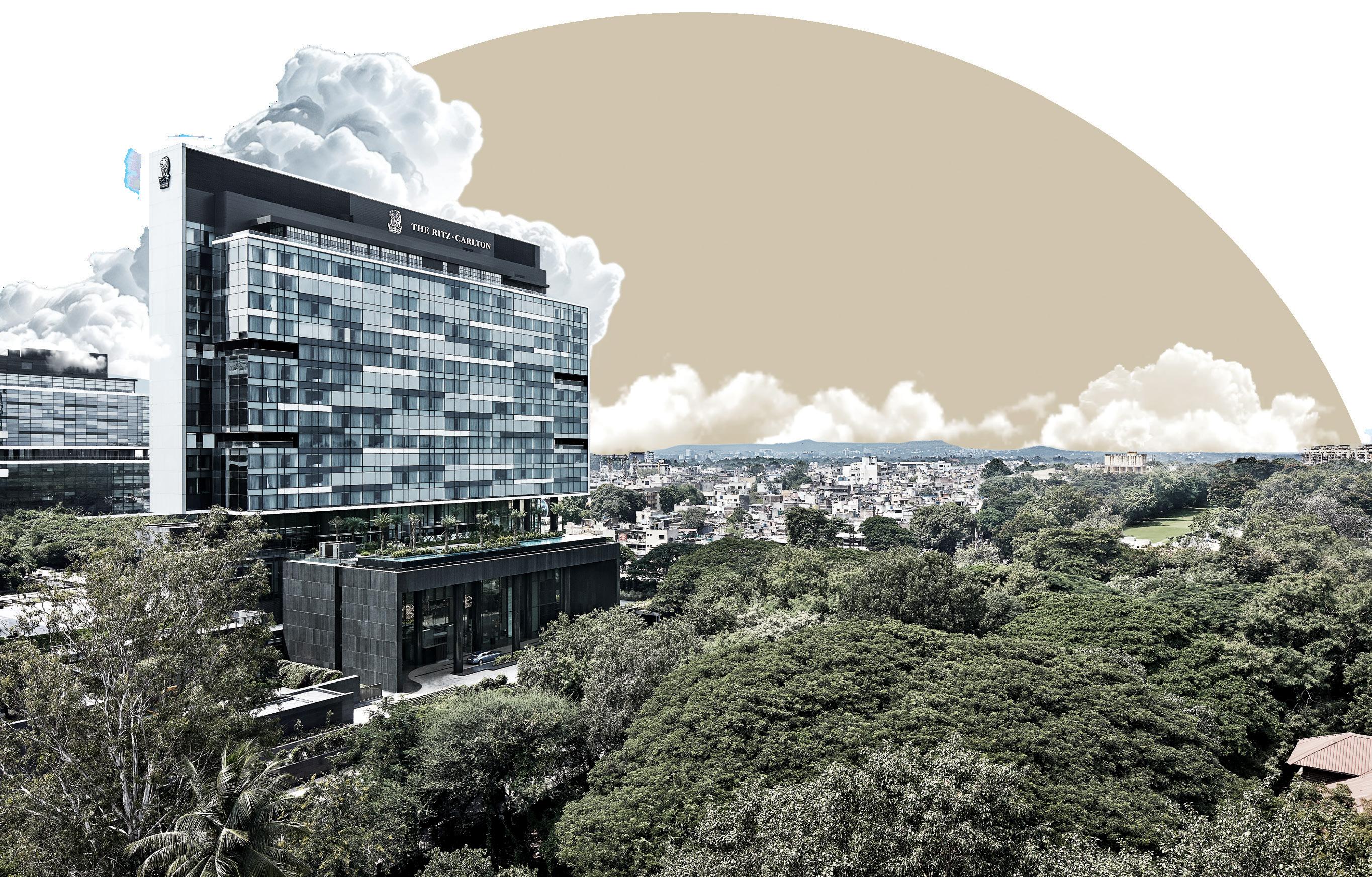
Nikhil Shah
SENIOR DIRECTOR - CAPITAL MARKETS & INVESTMENT SERVICES AT COLLIERS
“
The luxury segment is seeing the highest influx of investments, driven by the absence of rate caps and its resilience during industry upcycles. Investors are particularly interested in boutique experiential hotels and resorts.”
role," he adds, “while global giants like Blackstone and Brookfield are increasingly partnering with local players.”
However, private equity investment remains relatively subdued due to the limited availability of large portfolio acquisitions. “Investors prefer to acquire larger portfolios, which are still scarce,” says Dang. Thacker echoes this sentiment, adding that private equity's preference for larger projects and five to seven years invested timelines is a constraint for private equity to contribute materially to development financing in the Indian market.
Despite these limitations, increased private equity and institutional investment is crucial for the industry's long-term growth. Thacker believes that attracting investors requires large platforms, which are currently being established through IPOs.

“IPOs also attract institutional and private equity investment,” he notes, “freeing up capital for further expansion in the sector.”
Dang informs that it is a matter of time before the Indian hospitality sector builds scale, which will attract private equity interest. “While large portfolio acquisitions may not happen in the immediate future, this trend is expected to evolve in the coming years, similar to more mature hospitality markets like Singapore, Dubai, and Europe.”
Foreign institutional investors (FIIs) are also showing growing interest. Shah highlights Brookfield's acquisition of The Leela Group and Blackstone's partnership with Panchshil as prime examples. "Approximately one-third of all investors in the listed sector are FIIs," he reveals, underscoring their growing influence on the Indian hospitality landscape.
The influx of capital could prove to be a double-edged sword, pushing up asset prices and putting pressure on yields, warns Dang. "Savvy investors will need to adjust their expectations and brace themselves for a potential squeeze on returns," he cautions.
Beneath the vibrant world of India's hospitality industry, characterised by significant investments, IPOs, and a surge of hotels, lays a complex narrative of challenges shaping investment decisions.
Puri argues that despite a positive outlook, the sector faces numerous challenges, including shifting government policies and rising operational costs. “A primary obstacle is the slow and complex regulatory and approval process, where securing permits, environmental clearances, and zoning approvals can be time-consuming. This leads to delays that



extend project timelines and increase development costs, compounded by the rising cost of construction.”
While sector expansion is promising, it has potential downsides. Thacker points out concerns about the prevalence of small hotels (30-45 rooms) signed up by chains, which raises issues of the ability to achieve consistent management standards and brand integrity amidst rising operational costs. “This could damage brand reputation in the long term,


though brand consciousness in India may not be as pronounced as in other markets. Additionally, the wide range of new owners coming in these small hotels poses risks, as many new owners lack the experience to navigate the challenges of the hotel industry, particularly during downturns, potentially leading to market instability.”
Despite these concerns, growth momentum persists, with chains eager to expand their portfolios. However, sustainable growth focused on long-term viability and responsible owners and operators—especially for smaller hotels—is essential. It's also crucial to temper expectations regarding projected growth; while over 80,000 rooms are expected to be added in the next four years, it's unlikely all projects will meet their timelines, as delays are common in the industry.
hospitality industry in India struggles with the perception of hotels as long-term investments. “Not all companies can go public, and lenders often provide capital with tenures of seven to ten years, complicating debt servicing even with a 50% debt-to-equity ratio. Granting hotel infrastructure status could help alleviate some challenges and encourage greater investment.”
Regulatory maze: Hospitality groups encounter regulations that vary by state, creating hurdles in obtaining approvals and adding compliance costs. This regulatory labyrinth can deter both domestic and international investors, exacerbated by inadequate infrastructure, such as poor roads and limited connectivity, which impact accessibility and the guest experience.
Infrastructure challenges: In emerging destinations, access to essential utilities like power and water may be limited. Puri notes that hotel developers often need to invest heavily in basic infrastructure, increasing project costs and delaying completion. Land acquisition is also problematic in areas with unclear titles or strong local resistance to development.
Need for government support: Puri emphasises the need for the central government to grant the hospitality sector both industry and infrastructure lending status, irrespective of project cost. “This critical move would significantly boost investment and incentivise hotel development, especially in underserved leisure destinations and Tier II and III cities.”
Shortage of skilled personnel: The Indian hospitality experience relies on a highly trained workforce, but a shortage of skilled personnel raises operational inefficiencies and labour costs, and impacts service quality.
Macroeconomic factors: Puri adds that the industry's dependence on leisure tourism and corporate travel makes it sensitive to economic performance. A “downturn in discretionary spending or business travel can immediately impact occupancy rates and revenue, undermining investor confidence. Rising inflation, fluctuating interest rates, increasing construction costs, extended development timelines, and limited financing options for non-institutional investors complicate project execution, especially for greenfield development, can dampen investor enthusiasm and slow the flow of capital into the sector.”
The Indian hospitality market is brimming with opportunities, particularly in the growing segments of villas and branded residences. “These are experiencing double the growth rate of traditional hotels and resorts, fuelled by rising demand for unique and personalised experiences. This trend is attracting significant investment, as travellers seek accommodations that offer more than just a place to stay,” says Shah. Shah also highlights strong growth potential in the leisure and pilgrimage tourism sectors. “The opening of new gates in wildlife sanctuaries such as Tadoba, Pench, and Jawai is further boosting niche tourism segments like wildlife safaris. This diversification within the hospitality industry presents exciting avenues for expansion and investment.”
India is emerging as a key hub for manufacturing and business activities, attracting significant foreign investments that fuel corporate travel growth. “With world-class convention centres like Yashobhoomi, Bharat Mandapam, and the Jio World Convention Center now operational, MICE tourism is gaining momentum, further boosting the sector,” says Puri.
The midscale segment is well-positioned for expansion, supported by the growing middle class, increased domestic and niche tourism, and rising business travel from small and medium-sized enterprises (SMEs). This opens up the potential for the economy and budget hotel segments, which, as of 2023, accounted for only about 5% of the total branded supply in India, indicating significant room for growth.
Additionally, India is becoming a major destination for sports tourism, with enthusiasts travelling across the country to witness live events, as seen during the Cricket World Cup. “Beyond sports, entertainment tourism is gaining traction, with large-scale events like the much-anticipated Coldplay concert drawing significant attention. These evolving trends are likely to drive future investments, reflecting a broader shift toward experiential travel and a growing appetite for diverse tourism experiences,” adds Puri.
Currently, there is a strong appetite for investment in the hospitality market, with significant demand from buyers seeking hotel assets. Shah contends, “However, many deals face challenges in meeting specific requirements set by investors. Despite this, developers remain optimistic about the future, driven by the ongoing industry upcycle and potential for continued growth.”

Sustainability is also crucial in shaping the hospitality sector's development. India's commitment to sustainable tourism is growing, driven by its net-zero emissions goal for 2070 and increasing traveller demand for eco-friendly options. “With 69% of travellers actively seeking sustainable travel experiences, according to a WTTC report, ecotourism is on the rise. This shift is vital for preserving India's natural and cultural heritage while spotlighting lesser-known regions, offering fresh perspectives on the country's diverse offerings,” says Puri.
The next step in sustainability for the hospitality sector is the rise of net-zero hotels. “Beyond operational efforts like eliminating singleuse plastics and reducing housekeeping, the industry must adopt green technologies in construction to ensure net-zero energy consumption from the outset, addressing both environmental impact and public perception. For investors, this transition offers a dual advantage: supporting environmental goals while tapping into the growing demand for sustainable, eco-conscious travel experiences,” he adds.
Eco-conscious practices are influencing project designs and operations, leading to long-term benefits for investors, including reduced operational costs and increased appeal to environmentally aware travellers, says Shah. “This focus on sustainability is not just a trend but a fundamental shift in how the industry operates and attracts investment.”
To further bolster investment, Thacker advocates government support to modernise hospitality education, streamline visa processes for international travellers, and improve travel facilitation.
Government policies have supported investments
India’s economy has performed far better than many other big economies, ensuring that investments continue to flow in, in all sectors including hospitality. Hotelivate’s report 2024 Indian Hospitality: Trends & Opportunities states that India witnessed strong economic recovery
with an expansion of 9.1% in 2021/22, followed by 6.9% growth in 2022/23. “Growing private consumption and government spending has supported this momentum for further growth of 8.1% in 2023/24. Despite global economic uncertainties, India's diverse economy, demographic advantage, and structural reforms are positioning it as one of the fastest-growing major economies in the world. Strong domestic demand, fuelled by rising consumer spending and a rebound in investment, is a key contributor to the economy. The Indian government’s ongoing efforts to liberalise Foreign Direct Investment (FDI) regulations in key sectors like manufacturing, technology, and renewable energy are expected to boost investor confidence.”
India's focus on infrastructure development has fueled hospitality investments.
“Government initiatives like UDAN, Swadesh Darshan, Adarsh Station Scheme, and Bharatmala Pariyojna have significantly enhanced connectivity and accessibility, fueling tourism growth,” says Puri. Shah adds that state-level initiatives are also contributing. "Assam's new bill to promote tourism, with incentives like a ₹5 crore capital subsidy and 10-year GST rebate, and Maharashtra's 2024 Tourism Policy, offering benefits like 9% SGST reimbursement for 15 years and exemptions on stamp duty, are driving investment," he explains.
Despite this progress, India's current supply of approximately 375,000 quality hotel keys, with only 170,000 affiliated with brands, may struggle to meet rising demand. This indicates strong potential for further investment in the sector, as upcoming inventory is likely to be absorbed quickly.



IHCL is repositioning one of its hotel brands, and this strategic move could lead to long-term market dominance.
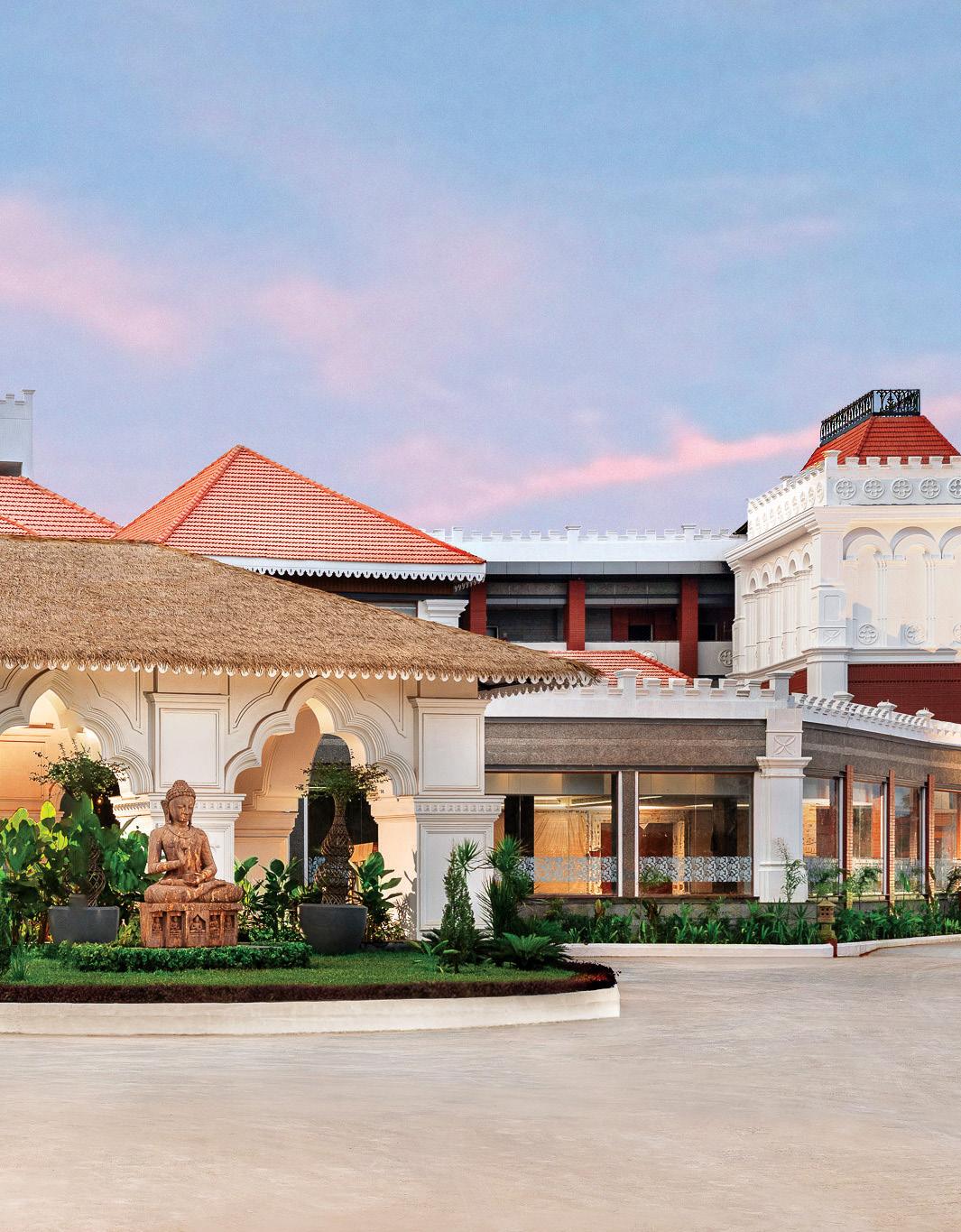
Some of you might recollect Gateway as a brand that Taj Hotels had planned—and rolled out—as a ‘gateway’ to a destination in the upscale segment. And then the Taj conceived of a newer fancier brand—in the same upscale space. Starting in 2010, Vivanta, chic and sophisticated, its very name a derivative of bon vivant, had a fairly rapid rollout.
Somewhere IHCL has come to the realisation that it needed a more traditional version of upscale
hospitality to cater to the parts of India that are perhaps as much as in tune with ‘SoBo’ and ‘SoDe’. For guests who were arguably the first generation of their families and communities to have access to topend luxury hospitality— and were looking for features such as extensive F&B offerings, poolside relaxation, more restaurant options...
The move to revive Gateway by IHCL has brought back a more traditional version of upscale
The re-imagined Gateway features generously sized guestrooms and suites, and a diverse range of culinary offerings including a tea lounge, an all-day diner, a speciality cuisine restaurant, and a bar. With a strong emphasis on large-scale banqueting facilities, the hotels will cater to the expanding wedding and MICE segments in these regions.
They offer a variety of spacious indoor and outdoor meeting and celebration areas along with wellness and recreational amenities such as pools and fitness centres. Additionally, familyfriendly activity zones ensure that guests of all ages have a memorable experience.
What sets Gateway apart is its deep connection with the local culture, expressed through design, cuisine, and curated guest experiences like a unique hi-tea cart in the lobby showcasing local food and beverages. The unique selling proposition lies in its ability to offer modern comforts while immersing guests in local traditions.

hospitality, and follows the recent successful repositioning of the Ginger brand.
Puneet Chhatwal, Managing Director and CEO, IHCL, says, "Expanding IHCL’s brandscape, the re-imagined Gateway introduces a full-service hotel offering in the upscale segment, an ideal fit to capture growth opportunities in micro-markets of metros and Tier II and III cities. Gateway will cater to the increasing domestic demand for quality accommodations with large banqueting facilities in emerging cities.”
The re-imagined Gateway brand is a full-service hotel in the upscale segment, focusing on the evolving needs of today’s travellers, points out Leah Tata, Vice President & Brand Leader, Gateway Hotels & Resorts, IHCL. “The brand is positioned to capture demand in emerging Tier II and Tier III cities, as well as emerging central business districts in metros. It focuses on creating vibrant, culturally inspired spaces that reflect the fresh aspirations of the locale and the rich tapestry of its traditions. Serving as a ‘Gateway to the Destination’, the brand connects
travellers with the local ethos, culture, and traditions of the cities they visit."
Gateway and Vivanta are in the same continuum of upscale segments catering to different travel needs. Gateway is classical in its design with a sense of place, elaborates Tata. “Vivanta is catering more to the business traveller. It lends itself well to meetings and events. As we started foraying into the markets outside of metros to emerging micro markets and Tier I and Tier II cities, the product and service for the upscale segment needed design adaptation. Gateway is led by classical touches, reflecting the destinations’ ethos, culture and traditions. It creates vibrant culturally inspired spaces that echo the aspirations of the locales.”
Since there is no financial viability in these markets for a luxury brand like Taj, and Vivanta’s design ethos and facility mix would not meet the consumer need, the upscale segment offered an opportunity to re-imagine the Gateway brand, Tata adds.
“The re-launch of Gateway aligns with IHCL’s broader strategy of offering the right brand for the

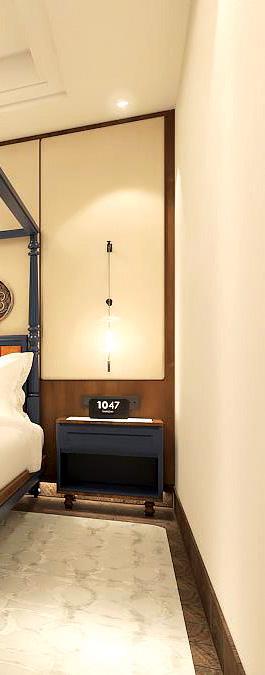

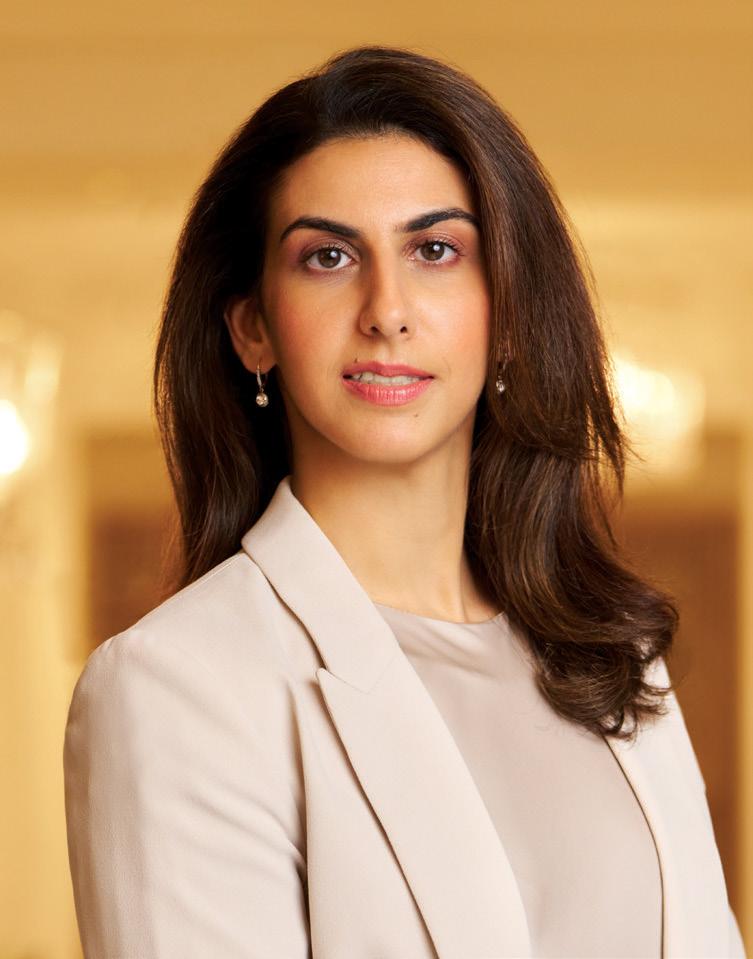
LEAH TATA
VICE PRESIDENT & BRAND LEADER, GATEWAY HOTELS & RESORTS, IHCL
“The re-imagined Gateway focuses on creating vibrant spaces that reflect the fresh aspirations of the locale and the rich tapestry of its traditions.”
right market. It plays a crucial role in markets where luxury offerings like Taj may not be viable yet there is a strong demand for high-quality full-service hotels. With travel becoming an integral part of household spending, we have witnessed a growing demand for high-quality accommodations in Tier II and III cities. This, combined with the rising trend of life-event celebrations, drove the repositioning. The brand's launch responds to the shift in consumer behaviour and aims to deliver personalised, location-specific experiences that resonate with the young India of today.”
Gateway has taken several steps to cater to the more traditional guests. “Gateway has a larger focus on food and beverage for both restaurants and outdoor and indoor banqueting,” says Tata. “Basis the location, the contribution of food and beverage can be in a ratio of one-to-one with room revenue. Gateway hotels have an additional speciality restaurant with bars and expansive buffets that serve classical offerings such as Sunday brunches and recreational activities for family. It
is a hotel that speaks more to a family than an individual business traveller.”
There is an opportunity in every segment with its price point, according to the group. While Vivanta will penetrate deeper into the top 10 cities, the opportunity for Gateway is wider across the multiple state capitals and Tier I and II cities in India. Gateway has a vision of having a 100-hotel portfolio by 2030, well ahead of Vivanta's planned presence.
“The brand roll-out commenced with the opening of Gateway Bekal along with the migration of four operating hotels in Nashik, Coonoor, Madurai and Chikmagalur,” says Chhatwal. The group plans to follow a capital-light model that will ensure the rapid growth of the brand across state capitals, commercial centres, smart cities, and emerging suburbs in metros and leisure destinations.
The current brand portfolio of 17 hotels will scale to 100 hotels by 2030, according to IHCL. Other destinations in the pipeline include Bengaluru, Thane, Jaipur, Sawai Madhopur and Sarnath among others.



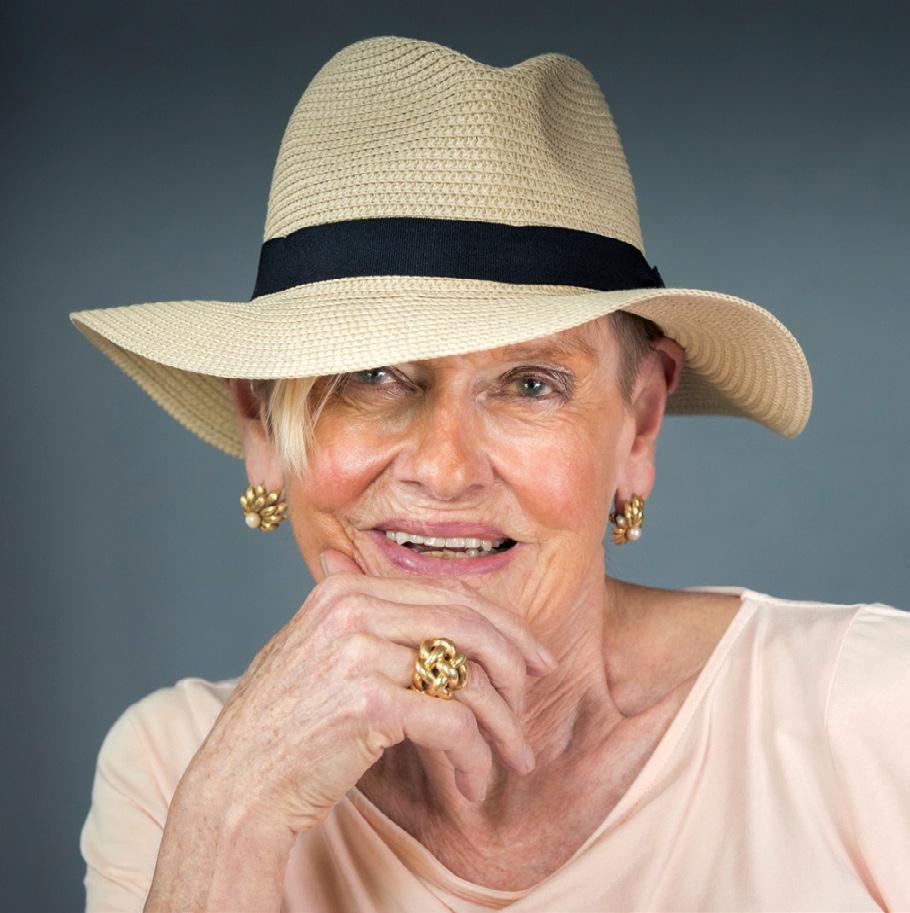
MARY GOSTELOW TRAVELS ABOUT 300 DAYS A YEAR, ASSESSING WHAT IS NEW AND WORTH WATCHING IN LUXURY HOSPITALITY TRENDS.






50 Best Hotels in the World has unveiled an eclectic range of hotels— from intimate, family-run properties to expansive, high-capacity establishments. For the hotels themselves, being featured on this coveted list translates to increased visibility, an acquired sheen, and a surge in bookings.
Last month, UK-based William Reed Business Magazines held their second annual 50 Best Hotels in the World jamboree.
Well over 300 hoteliers, in blacktie or floor-length evening attire, had flown in, at their expense, from all over the world for a couple of days’ networking with colleagues and gossip. They all gathered on Tuesday, 17th September, in London’s historic Guildhall to hear the results. Supposedly 600 ‘judges’, a combination of trade and consumers, all sworn to secrecy, had voted (but how many have ever been to Fiji, for instance? See below for reference).
number one (The Capella Bangkok) is definitely a stand-out. Of the 50 winners, four are Four Seasons, and another four are Rosewood. Aman and Oetker come in with three; Accor, Belmond and Marriott with two, and Hyatt and IHG one each.
continuing this momentum in the months ahead!
“We will ensure we celebrate and thank our associates, clients and our Upper Eastside neighbourhood friends as they all have contributed to our Carlyle community!”
OPPOSITE
CLOCKWISE FROM TOP LEFT: Aman New York; Raffles London at The OWO; Suján Jawai, Udaipur; Capella
Bangkok; Atlantis
The Royal, Dubai; Kokomo Private Island, Yaukuve
Levu Island, Fiji.
When talking about the winners, one judge later said, privately, the growing appreciation for smaller, family-run properties is noticeable. Larger key-count winners, say Kerzner’s 750-key Atlantis Royal in Dubai, still manage to give a bespoke feel, helped by a brigade of extremely well-trained butlers. All 50 winners have extremely impressive GMs (it should be pointed out that voting was done before Atlantis Royal’s boss, Tom Roelens, revealed he is shortly moving to a neighbouring Emirate to be COO of Wynn’s forthcoming ‘integrated’ (read ‘casino’) resort in Ras al Khaimah.
It really makes little difference if a winner is #50 (Fiji’s Kokomo Private Island) or #29 (One&Only Mandarina, in Mexico), though to be
The sole Indian representative is one of Jaisal and Anjali Singhs’ tented camps, the 10-unit Suján Jawai in Rajasthan. What has happened to the country’s usuallycited names? Is marketing missing a beat or, dare one say it, is service, although exemplary, a little too formal and omnipresent for today’s changing luxury travellers? There was, admittedly, at least one other Indian-owned winner, the Hindujas’ Raffles London at The OWO. Its MD, Philippe Leboeuf, maximised the opportunity presented by the event, in effect being hotel host, and many participants stayed there.
What is the overall business result of such an awards poll? Australian Marlene Poynder is the highly-admired and stylish MD of New York’s The Carlyle, A Rosewood Hotel. Speaking exclusively to SOH, she says: “We’re leveraging The World’s 50 Best recognition to create new opportunities for The Carlyle. Our focus is on enhancing guest experiences, strengthening key partnerships, and ensuring our team continues to feel comfortable providing their genuine care and service. We look forward to
Naim Maddad (another Australian, as it happens) is asset manager of Six Senses Zighy Bay in Oman. He believes the award is an endorsement. “It will give wider exposure across new channels, it will help in attracting the best talent globally and further define positioning—there’s now a sense of belonging to an elite level of excellence,” he says, adding that it will set standards and expectations for years to come. The award will help position the (Musandam) region as a destination. “All this leads to higher occupancies at a solid rate, resulting in a fruitful commercial sense.”
The main beneficiary, however, must surely be the organiser, William Reed Business Magazines. The family-owned company, with an annual turnover of over £63 million, is run by Charles Reed, descendant of a Yorkshire sugar magnate who started publishing 166 years ago. Its 50 Best Restaurants, one of over 30 annual awards, has significant sponsors, including Las Vegas Convention & Visitors Authority and S. Pellegrino. 50 Best Hotels will similarly attract mega-money.

Mumbai
Ashford Chambers, Old Citylight Theatre | Lady Jamshedji Road | 400 016 Mahim, Mumbai 022 2446 7750/51/52/54 | mumbai@pluschliving.com
Bangalore No 37, 4th B Cross, 5th Block | Industrial Layout Koramangala | 560 095 Bengaluru 080 2550 4444 | bengaluru@pluschliving.com
Hyderabad
Plot No, 761, Rd Number 39 | CBI Colony, Jubilee Hills | 500 033 Hyderabad +91 82972 25491 | hyderabad@pluschliving com
Delhi
F 3/1, Okhla Industrial Area | Phase 1, Near Crowne Plaza | 110 020 New Delhi 011-41553333/6789 | delhi@pluschliving.com



Drawing from his experience at leading hotels worldwide, Pierre Jochem, General Manager, La Mamounia, reveals how authentic experiences shape modern hospitality.
Pierre Jochem is a seasoned veteran of the luxury hospitality industry, with a career that has seen him working with prestigious brands such as Hyatt, Peninsula, The Oberoi Hotels, Raffles, and Four Seasons, and across diverse cultural landscapes, including stints in London, New York, New Delhi, Tianjin—and now, Morocco, as General Manager of one of the country’s most iconic properties, La Mamounia in Marrakech.
His leadership at the 100-year-old hotel has been marked by significant milestones, including best hotel awards and listings. He spearheaded a major renovation of the iconic property, maintaining its global reputation
for excellence while adapting to modern standards.
SOH met with the renowned hotelier during his recent visit to India to discuss his experiences navigating the nuances of various cultures while upholding exceptional service standards, including his time at The Oberoi and The Imperial, both in Delhi.
With such a diverse career, how do you adjust your leadership style to accommodate different cultural expectations and management practices?
The one thing I’ve learned is that leadership isn’t about imposing a single style on every situation; rather, it is about adapting and learning from the environment you find yourself in.
In Europe, for instance, there’s often a strong emphasis on structure and hierarchy, while in Southeast Asia, relationships and respect for seniority play a crucial role. America tends to focus on results and innovation, whereas, in India, the balance between tradition and modernity is the key. Each of these experiences has taught me that flexibility and openness are essential. No matter where I am, the foundation of my leadership remains the same: leading with humility, showing genuine respect for the people I work with, and listening deeply.
From managing different properties worldwide, what are some of the most valuable leadership lessons you have learned?
First, cultural sensitivity is paramount. Understanding and respecting the diverse cultures of both guests and team members has been crucial in delivering exceptional service and fostering a cohesive work environment.
Then, adaptability is the key. Each location presents its unique challenges and opportunities. Being flexible and open to new ways of thinking has allowed me to navigate different market dynamics successfully. Another important lesson is the power of collaboration. These lessons have shaped my approach and have been instrumental in the successes I have achieved throughout my career.
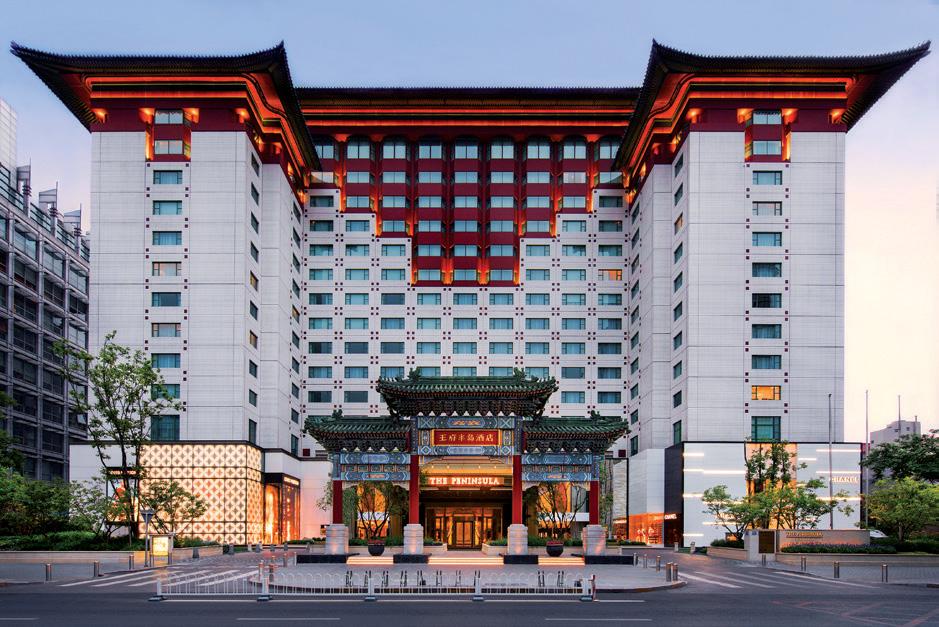

When working in culturally distinct regions, what strategies have you found most in aligning your teams with the global standards of luxury hospitality while respecting local customs?
My approach has always been to blend the soul of the destination with the precision of global luxury standards, enhancing guests' sense of place without sacrificing comfort, discretion, or service. This requires deeply understanding local culture and international luxury benchmarks, weaving them together seamlessly to create an experience that feels genuine, culturally enriching, and luxurious. It's not about enforcing a ‘one-size-fits-all’ standard, but elevating local traditions to meet global expectations.
At La Mamounia, we celebrate the essence of Moroccan hospitality, which is rooted in generosity, warmth, and a strong sense of community. For example, serving milk and dates when a guest checks in, is an integral part of Moroccan culture. It is not just a formality—it’s an experience. We’ve incorporated this ritual into our welcoming rituals before checking in, and our team offers it with the same grace and pride as you would find in a Moroccan home. This allows guests to feel immersed in an authentic experience.
What are the significant trends you are currently observing in the global luxury hospitality industry, and how are you adapting these trends at La Mamounia?
Guests seek more than just luxury; they want authenticity, personalisation, and experiences that connect them to the local culture. For example, one of the major trends is the growing desire for culinary authenticity paired
with wellness-conscious dining. In our four restaurants—Le Marocain, L’ Italien by Jean-Georges, L'Asiatique by Jean-Georges, or Le Pavillon de la Piscine—we serve food incorporating locally sourced, organic ingredients. Our guests want farm-to-table experiences that are indulgent and mindful of health. Our chefs have created special menus, integrating traditional spices like saffron and cumin into light, flavourful dishes that meet international dietary expectations.
How do you balance cuttingedge technology with exclusive guest experience?
We love technology and embrace it to enhance the guest experience while maintaining a balance. By integrating it to help improve efficiency and comfort, we offer convenience without losing the warmth of personal interaction. For us, it's not just about quick check-ins—it’s about the genuine smile and welcome from our team, making guests feel personally attended to.
In Food & Beverage, technology streamlines reservations and personalises dining based on guest preferences, but the heart of the experience remains human. Whether it’s a sommelier recommending the perfect wine or a chef crafting a bespoke menu, personal attention and our team’s passion create memorable moments, with technology simply supporting the service.
Having worked at The Oberoi and The Imperial in New Delhi, how did your experience in India shape your understanding of luxury hospitality?
My nine years in India were incredibly transformative, both professionally and personally. India’s unique relationship with hospitality is deeply rooted in its culture. The concept of ‘Atithi Devo Bhava,’ or ‘Guest is God,’ resonated with me profoundly.
In India, there’s an innate respect for guests, and service is not just about fulfilling a need; it’s about creating an experience that makes the guest feel honoured and cared for. At The Oberoi and then at The Imperial, I witnessed how even the smallest of gestures—remembering a guest’s preference for tea or surprising them with something personal—could create a lasting impression. Moreover, the blending of tradition with modernity in India was a powerful lesson. At The Imperial, a heritage property, we honoured the history and cultural richness of the hotel, while also implementing modern luxury standards. This understanding of luxury is about the details, about making the guest feel special in a quiet, almost intuitive way.
What unique challenges come with managing properties with such storied histories, like The Imperial in India and La Mamounia in Marrakech?
Managing iconic properties requires a delicate balancing act, one that is rooted in a profound respect for their storied histories while
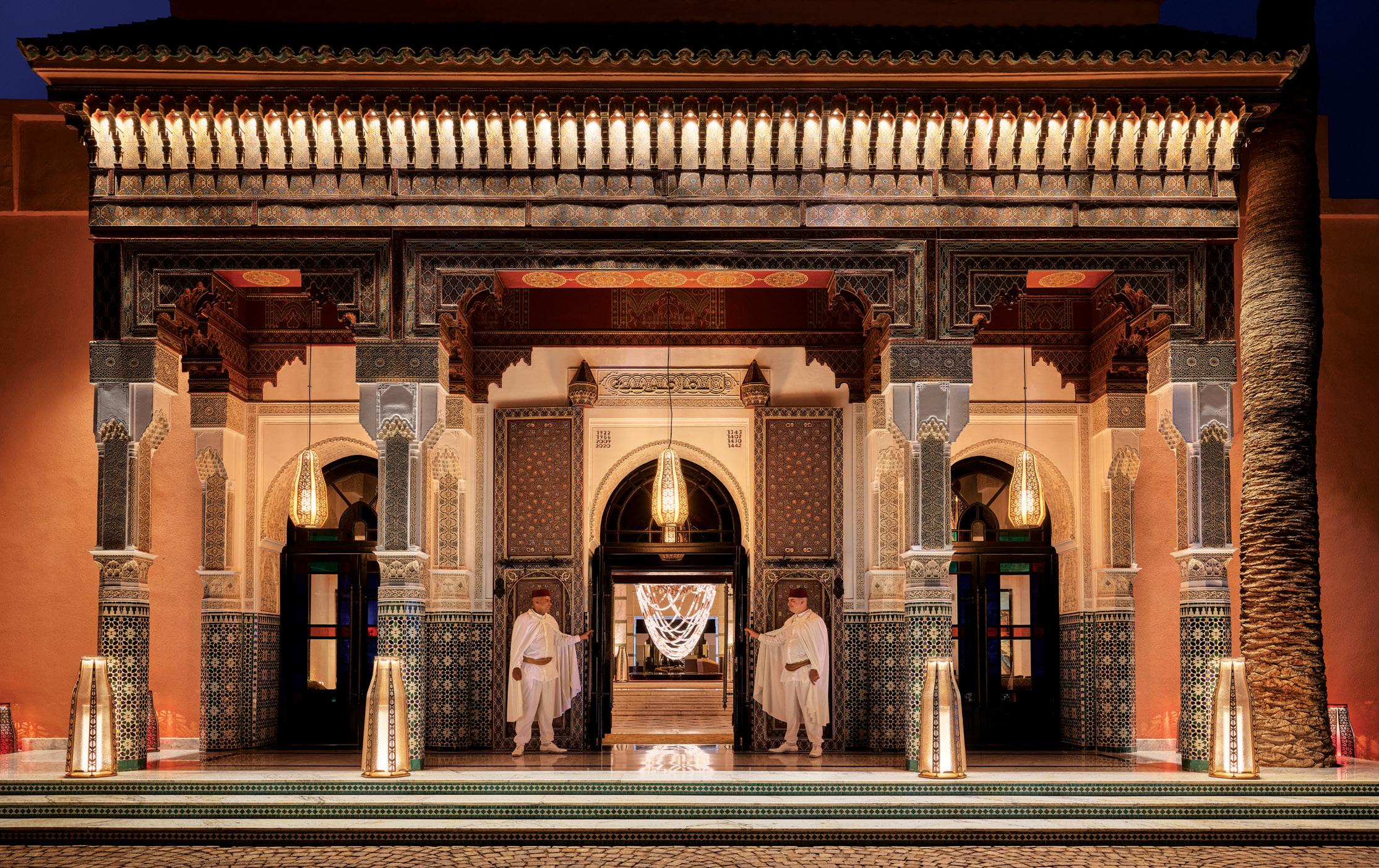
India holds a special place in my heart, having spent several remarkable years there. My first experience was as general manager of The Oberoi’s flagship hotel in New Delhi, from 1998 to 2000. It was an extraordinary experience, one that allowed me to immerse myself in the Indian market and truly understand its rich culture and unique dynamics. During that time, I developed a close relationship with the Oberoi family, particularly with Mr. P.R.S. Oberoi, a true visionary in luxury hospitality.
I distinctly remember Mr. Oberoi often mentioning that the most promising hotel in New Delhi was The Imperial, a property once under The Oberoi Group's management but now in desperate need of a major renovation. He spoke of it with admiration, recognising the immense potential it had despite its condition at the time.
As fate would have it, one of my final dinners before I left India in 2000 was at The Imperial. I was completely captivated by the charm and history of the hotel. I recall thinking, ‘What potential is lying here!’—it was a property that needed the right vision and attention to come alive.
A few years later, I had the distinct honour of being contacted by the Aakoi family to take over the helm of The Imperial, overseeing its renovation and helping to reposition it as an iconic destination. Those seven years were extraordinary—a time of pure joy and a remarkable success story in Indian luxury hospitality. The work we did at The Imperial even caught the attention of Harvard University, which later selected it as a case study, a testament to the success and transformation we achieved together.
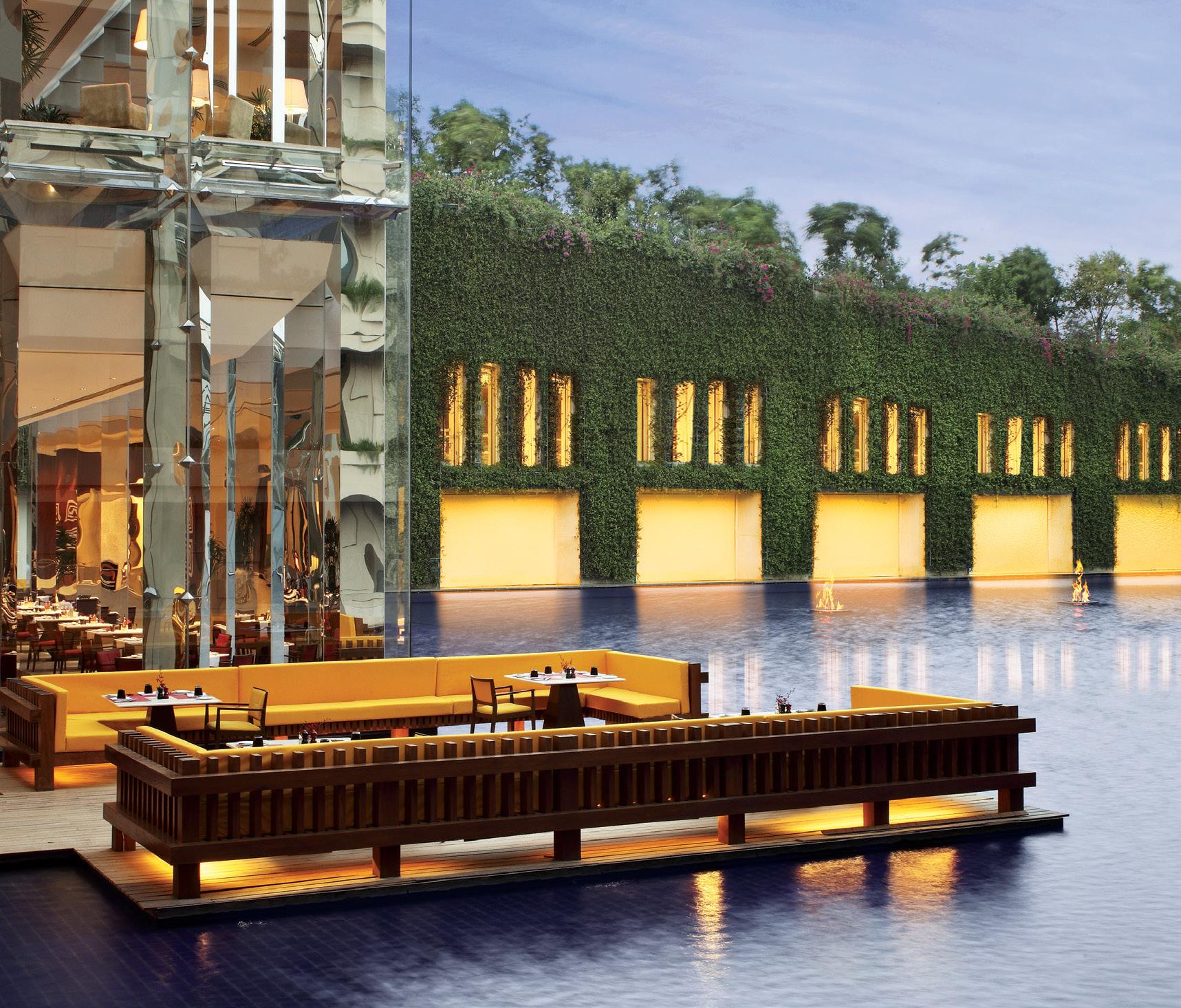
“At The Oberoi and then at The Imperial, I witnessed how even the smallest of gestures could create a lasting impression.”
simultaneously pushing the boundaries of innovation. The unique challenge lies in safeguarding the soul of these legendary establishments, preserving their identity; and their sense of place, while adapting to the evolving needs and expectations of a modern clientele.
At The Imperial, for example, you are surrounded by the grandeur of British colonial architecture and an immense sense of history. Here, the challenge is to incorporate contemporary luxury and technology, without disrupting the authenticity of the experience.
La Mamounia, with its rich Moroccan heritage, presents a similar challenge. The hotel's history and deep connection to Marrakech are essential, but you must also ensure it continues to stand at the pinnacle of global luxury. It’s about honouring the traditional craftsmanship, the gardens, the architectural marvels, and the cultural ties while continuously innovating—whether that means modernising amenities, introducing new dining concepts, or elevating the guest experience.
One of the first challenges I encountered at La Mamounia was the existing work culture. While the team was dedicated, they were rigid and hesitant to take initiative. Many staff members refused to smile and were bound by strict procedures, affecting the guest experience.
OPPOSITE PAGE:
La Mamounia had also developed a somewhat snobbish reputation, and it was essential to change this perception. I focused on creating a welcoming atmosphere for guests and staff by promoting hard work with a calm, friendly demeanour. Grooming was another key area. I introduced stylish yet strict grooming standards, elevating the hotel’s image and fostering pride and professionalism among the team. By creating an



environment where everyone felt valued, we broke free from the rigidity that stifled innovation. These changes have transformed La Mamounia into a dynamic, guest-focused environment. In both cases, innovation must always serve to enhance, not overshadow, tradition. Whether through design, service, or guest experiences, every change is measured, thoughtful, and respectful of the legacy we are entrusted to preserve.
How did you and your team adapt to the unique demands of hosting two grand Indian weddings at La Mamounia, and what key strategies ensured a seamless blend of Moroccan and Indian cultural elements for their success? The first key to success was understanding the scale and complexity of these events. Indian weddings are intricate, multiday celebrations that demand meticulous planning and flawless execution. We worked closely with families and planners to ensure every detail, from decorations to ceremonies, was handled seamlessly.
Blending Moroccan and Indian cultures was an exciting challenge. We integrated vibrant Moroccan architecture and gardens with Indian customs, collaborating with Indian chefs to design authentic menus that complemented Moroccan cuisine for a rich culinary experience. Our dedicated, flexible team recognised the emotional significance of these events, ensuring every guest felt at home, whether experiencing Moroccan hospitality or celebrating their Indian heritage.
How has your experience with globally recognised hotel chains influenced your approach to managing La Mamounia, an independent luxury property? What unique challenges and freedom come with operating independently?
There’s a clear difference between working for a hotel within a large chain and managing an independent property. In a chain, the focus is often on standardisation and brand alignment, which enhances operational efficiency. I’ve adopted some of this structure to streamline decisionmaking and ensure we can quickly respond to guest needs.
However, as an independent hotel, the greatest advantage is creative freedom. This flexibility fuels innovation and allows us to bring our ideas to life. It drives our attention to detail, whether introducing new linen, creating a signature cocktail, or reinventing our culinary offerings. In a chain, such changes often require multiple approvals, slowing the process.
An independent hotel has a unique soul and identity, offering something truly one-of-a-kind that guests won’t find anywhere else. This distinct character creates a sense of magic that leaves a lasting impression.
What opportunities do you see for growth and innovation in Indian hospitality, particularly in the luxury sector?
The country’s rich cultural heritage, diverse landscapes, and evolving economic landscape position it as a future leader in global luxury travel. There’s no doubt that India has all the ingredients to become a major player in the luxury hospitality world—it will take a little more time to unlock this potential. I believe that in the next five years, India will play a crucial role in shaping the global luxury hospitality scene. India's growing appetite for bespoke luxury travel experiences is particularly interesting. As the market matures, demand will increase for experiences blending rich Indian culture with world-class service, creating an ideal environment for both homegrown brands and international luxury chains to thrive.
Do you have a favourite destination or country where you’ve enjoyed living or working the most?
That is a difficult question, given the diversity of extraordinary places I’ve had the privilege to experience throughout my career. However, if I had to identify a few that resonate deeply with me, Corsica comes to mind for its breathtaking landscapes and crystal-clear waters. There is something profoundly moving about its rugged beauty, a place where nature feels untamed yet welcoming. Then there’s Mauritius, a country that I hold dear not only for the sheer beauty of its lagoons but also for the kindness of its people. The island exudes a sense of peace, and the tranquility I find there is unparalleled. Lastly, Thailand, particularly at The Oriental Bangkok, is one of my most cherished places in Asia. The Thai culture, steeped in Buddhism, the vibrant food, and the rich flavours have always fascinated me. Here, tradition meets modernity, and there’s a spiritual depth that captivates me every time I visit. Thailand is a country that embodies beauty on so many levels—from its landscapes to its people and culture.

“Let me make one hotel.”
It all started with this statement by an entrepreneur engaged in a thriving jewellery business, when he yielded to his passion for hospitality. That was in 1998, and the debut was the Grand by GRT Hotels in Chennai, “which became a benchmark for the brand with its striking 100-foot atrium, the city’s first indoor pool, and a spacious lobby,” says Vikram Cotah, CEO of GRT Hotels & Resorts. Following the success of their flagship property, GRT expanded its hospitality footprint by acquiring Chennai’s Radisson Group hotel and then the 40-acre ITDC Temple Bay resort in Mamallapuram, which was also rebranded as a Radisson. “Since then, we started acquiring hotels,” Cotah notes. Today, the
GRT Hotels began its journey far from hospitality, but its leap into the hotel industry was no accident. Vikram Cotah , CEO of GRT Hotels & Resorts, shares how the 22 hotelstrong group is staying ahead in the hospitality game by championing sustainability, practicing inclusivity, and redefining luxury for the next generation.
RUPALI SEBASTIAN
group operates 22 hotels across southern India and has recently ventured internationally with a new project in the Maldives. Their portfolio spans multiple segments, with luxury hotels and resorts franchised to Radisson for broader distribution; the Grand by GRT brand catering to the upper-upscale market in cities such as Chennai, Madurai, Kakinada, and Vijayawada; the Regency brand targeting the mid-market segment in the Tier II and Tier III locations; upscale leisure resorts under Great Trails by GRT Hotels focusing on exotic or unique locations; and lean luxury youthful hotels under Zibe by GRT Hotels catering to major metros and Tier II cities.
While Tier II and Tier III cities are now gaining attention for their hospitality potential, GRT Hotels & Resorts had the foresight to tap into these markets over a decade ago. “We had the vision to expand into Tier II cities almost 12 years back with our first hotel in Madurai,” shares Cotah. Today, the group has established a strong presence in most of Tamil Nadu’s Tier II cities, closely tied to the region’s rich cultural and spiritual heritage. “We connect all the temple towns,” says Cotah. “With Indian tourism heading towards spiritual tourism, we are in an advantageous position, connecting all spiritual tourism locations in Tamil Nadu with our hotels.” This focus on Tier II cities allows Cotah to offer ‘aspirational hospitality’ to
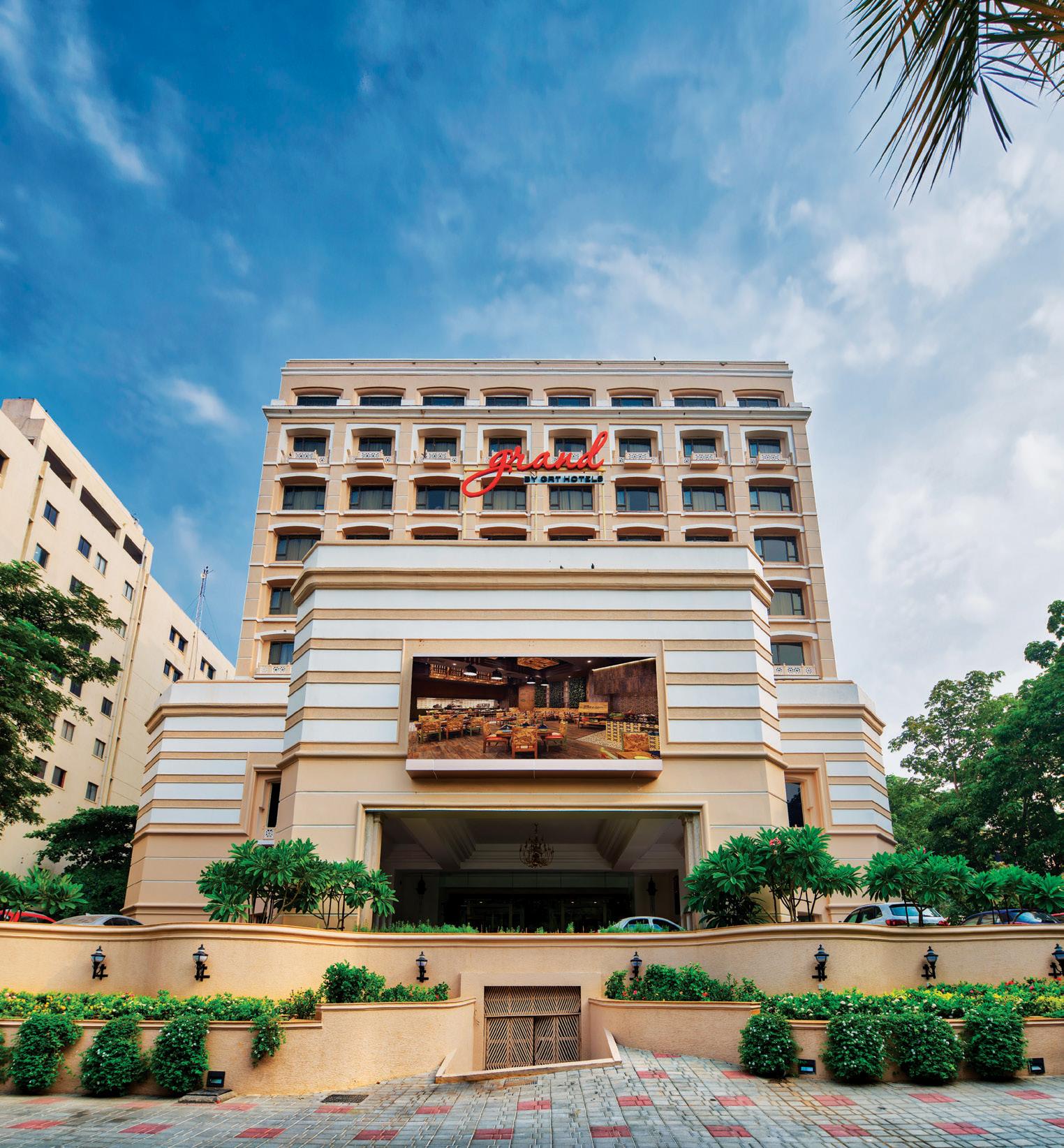
its inhabitants who have largely migrated to these developing urban areas from rural locations. “We refer to this segment interchangeably as ‘midmarket’ or ‘affordable luxury’,” Cotah explains.
This blend of spiritual tourism and aspirational hospitality has allowed GRT Hotels to cement its place not just in Tamil Nadu but across the southern states of India, including Andhra Pradesh and Karnataka.
Are luxury and sustainability opposing concepts? Cotah and GRT Hotels do not think so. They view them as two sides of the same coin. As Cotah explains, “The definition of luxury has changed. I’m a Gen-X, part of a generation that viewed luxury hotels as opulent—marble floors, goldplated taps, large chandeliers, and expansive lobbies.” However, today’s definition of luxury has shifted for the new generations. “When you ask a millennial, Gen Z, or even a Gen Alpha what luxury is, they will tell you it is sustainability, personalised experiences, and local immersion. Luxury has taken a complete U-turn,” he notes.
GRT Hotels has embraced this change by embedding sustainability into its operations without sacrificing the guest experience. “We’ve gone completely plastic-free in our hotels. You walk into many new-age hotels, and they’re filled with plastic—plastic water bottles, shampoo kits, everything. But if you don’t have plastic, that’s luxury today,” says Cotah. The company’s latest innovation, the biophilia suites at Radisson Blu Hotels and Suites GRT Chennai—74 of them—epitomise this sustainable luxury blend. “They are designed with terrariums—complete ecosystems in bowls—with lights. We guarantee an AQI of 25, unheard of in cities like Delhi where it can go up to 500. We believe luxury today is about creating spaces that are not only eco-friendly but also offer an exclusive, rare experience,” Cotah affirms.

ABOVE LEFT: Built in 1998, Grand Chennai by GRT Hotels has been a symbol of elegance and sophistication for over two decades. This is also GRT Hotels & Resorts' first property.
ABOVE RIGHT: The elegant 41-room, pet-friendly GReaT Trails River View Resort Thanjavur by GRT Hotels is a tranquil property located on the banks of Vennar, a tributary of the Cauvery.
Sustainability isn't just an initiative at GRT Hotels; it's embedded in their very essence. With ventures spanning renewable energy, organic farming, and a 750-acre coffee estate, GRT has long been committed to green practices. As Cotah puts it, “We invested in wind energy 15 years ago, and when solar came up, we moved into solar.”
The hotel group's sustainability journey in hospitality was sparked by a session at HICSA with Liz Ortiguera, Managing Director and Senior Advisor of the WTTC (World Travel & Tourism Council). Cotah


recalls, “She spoke about the 12 hotel sustainability basics, which intrigued me. We went back, did research, and immediately rolled out changes.”
Their first move was eliminating plastic bottles, and setting up bottling plants to produce Zro water—zero carbon footprint water that doesn’t travel and is also RO-filtered. “We made our water 7.5 pH, alkaline and healthier, and the guests loved it,” Cotah notes. This effort quickly expanded to all properties, including bulk amenities that are sulfate and paraben-free, and the complete removal of single-use plastics from restaurants.
Cotah is proud of the speed with which these initiatives were embraced.“Within six months, we achieved so much. I shared this with Radisson's global sustainability manager, and she was surprised. Liz Ortiguera was amazed too.” The impact was significant enough to inspire Cotah to document GRT's green journey in a book, which will be free to independent hoteliers.
The group’s sustainability efforts don’t stop there. GRT Hotels generates much of its power through solar energy and offsets any grid-based fossil fuel usage with the renewable energy produced by GRT Group’s solar plants. “We’re electricity neutral,” Cotah says proudly.
Beyond GRT Hotels, Cotah is pushing for policy advocacy. As chairperson of the Southern Regional Tourism Council and an independent director of the Tamil Nadu Tourism Development Corporation, he’s working to make minimum sustainability measures a requirement for hotel classification. “Sustainability should be at the core of hospitality,” he asserts.
This commitment has earned GRT Hotels certifications from SGS, a global benchmark for sustainability, quality, and integrity. “In eight months, we have achieved a lot, and it’s not just about ticking boxes. Our commitment to sustainability is real, and we’re proud to lead by example,” Cotah reflects.
VIKRAM COTAH
ONE DISH FROM YOUR HOTEL’S MENU THAT YOU COULD EAT FOR THE REST OF YOUR LIFE. Nei Choru with Nethili fry (Editor: ghee rice with fried anchovies).
YOUR GO-TO TRAVEL DESTINATION WHEN YOU NEED A BREAK FROM WORK. Pondicherry in India and Bali in Indonesia.
ONE BOOK, MOVIE, OR SHOW THAT EVERY HOTELIER SHOULD READ OR WATCH. Book: Setting the Table by Danny Meyer.
Movie: The Grand Budapest Hotel. Show: Hotel Hell (Editor: A reality television series created, hosted, and narrated by Gordon Ramsay).
IF YOUR HOTEL COULD HAVE A MASCOT, WHAT WOULD IT BE?
A dog—ever ready to please, unconditional love, gratitude, and fun to be with.
A QUIRKY MORNING RITUAL THAT HELPS YOU START YOUR DAY ON THE RIGHT FOOT. Begin each day by writing down one act of kindness I can do that day, whether it’s sending a positive message to a friend, leaving a kind note for a neighbour, or just smiling at strangers on my way to work.
DO YOU COLLECT ANYTHING WHEN YOU TRAVEL, SUCH AS SOUVENIRS, LOCAL ART, OR SOMETHING MORE UNCONVENTIONAL?
I collect pictures of me jumping in all the locations around the world I have been to!
IF YOU HAD TO PLAN A HOTEL BASED ON YOUR CHILDHOOD DREAM, WHAT WOULD IT LOOK LIKE?
An architectural marvel with an indoor forest, a swimming pool, a thousand varieties of birds, flowering trees and luxury tents. I love nature and wanted to be an architect who built nature retreats in forests.
At GRT Hotels, sustainability also extends to the food they serve, embracing a locavorian approach where local, seasonal produce plays a vital role. Cotah explains, “We balance things out as the produce is seasonal. Herbs and vegetables from our GRT farms are used in most of our hotels. We have a separate section in our buffets that highlights this farm-totable concept.”
GRT's menus also cater to diverse tastes, offering luxury ingredients such as Norwegian salmon and Kobe beef. Cotah points out that they don’t shy away from informing guests about the environmental impact of such choices. “We mention the carbon emissions linked to these items, giving guests the choice to opt for more sustainable, plant-based alternatives or hyperlocal options,” he notes.
Their commitment to sustainable sourcing is also evident in their work with local farmers and fishermen. “We ensure that the food we buy is sustainably and ethically grown or fished. We work directly with farmers and fishermen, ensuring we source food within 100kms,” Cotah explains. This philosophy underlines their dedication to creating a more conscious, eco-friendly dining experience across their hotels.
Sourcing hyperlocal food is part of building connections with local communities, a fundamental aspect of their philosophy. Cotah shares, “In Mamallapuram, for instance, when guests seek entertainment, we invite local artists to perform traditional arts like Poikkal Kuthirai Attam (horse dance) and Karagattam, where they balance pots on their heads while dancing.”
Beyond traditional performances, GRT collaborates
THE GRT HOTELS & RESORTS PORTFOLIO CURRENTLY FEATURES 22 PROPERTIES ACROSS KEY CITIES AND TOURIST DESTINATIONS IN SOUTH INDIA.
THESE PROPERTIES SPAN DIVERSE CATEGORIES, INCLUDING BUSINESS HOTELS, RESORTS, AND BUDGET HOTELS, CATERING TO A WIDE RANGE OF GUEST PREFERENCES.
THE TOTAL ROOM INVENTORY STANDS AT 1,566 KEYS, WITH FLAGSHIP HOTELS SUCH AS GRAND CHENNAI BY GRT HOTELS (133 KEYS) AND RADISSON BLU GRT CHENNAI AIRPORT (179 KEYS) LEADING THE PORTFOLIO.
MAJOR PROPERTIES ARE LOCATED IN DESTINATIONS LIKE CHENNAI, BENGALURU, MADURAI, COIMBATORE, KODAIKANAL, AND PONDICHERRY, WITH A MIX OF URBAN AND LEISURE-FOCUSED LOCATIONS.
THE GROUP’S EXPANSION PLANS ALSO INCLUDE KEY HOSPITALITY SEGMENTS SUCH AS THE ZIBE BY GRT HOTELS CHAIN, FOCUSED ON PROVIDING VALUEORIENTED, MODERN ACCOMMODATION IN CITIES LIKE COIMBATORE, HYDERABAD, SALEM, AND KAKINADA
THE GREAT TRAILS PROPERTIES IN YERCAUD, KODAIKANAL, WAYANAD, AND THANJAVUR OFFER CURATED NATURE AND EXPERIENTIAL STAYS FOR GUESTS SEEKING A MORE TRANQUIL AND IMMERSIVE EXPERIENCE.
IN THE PIPELINE IS A LUXURY COLLECTION PROPERTY IN THE MALDIVES WITH MARRIOTT. DISCUSSIONS ARE ALSO ON FOR A PROJECT IN HYDERABAD, WHILE ALSO EXPLORING OPPORTUNITIES ON A 750-ACRE COFFEE PLANTATION NEAR KODAIKANAL.
with local naturalists in scenic areas like Yercaud and Kodaikanal. “These naturalists possess intimate knowledge of the local flora and fauna. They can identify specific trees, plants, butterflies, and birds that guests might encounter during their stay. Guests truly appreciate this authentic experience,” Cotah explains. By integrating local culture and expertise into their offerings, GRT Hotels enriches the guest experience and contributes to the preservation of traditional art forms and knowledge within the communities they operate.
To engage guests in a deeper manner in its sustainability endeavours, the hotel chain is gearing up to launch an innovative sustainability-focused loyalty programme called the Caco Club, short for ‘Carbon Conscious

Club’. Cotah describes it as a way for guests to “live sustainably in the hotel,” with incentives that reward eco-friendly behaviour. Guests will earn Caco Coins—akin to cryptocurrency—when they take conscious steps like reusing linen, adjusting air conditioning temperatures to 24 or 27 degrees, or using natural sunlight. “We’re making guests part of the sustainable journey,” Cotah explains, adding that these Caco Coins can be traded or used to offset stays, turning sustainability into a win-win for both the hotel and its environmentally conscious guests.
The hospitality sector often overlooks both women and the third gender. In India, women represent only 12% of the hospitality workforce. To address this, GRT Hotels has pledged, “For every four men, we should have at least one woman in our workforce within a year.” This initiative aims to increase the representation of women on the hotel teams, including in leadership roles. Programs such as Women on Workforce (WOW) aim to reintegrate women who have taken career breaks to raise families, offering support through crèches and other resources. “During this process, we realised that the third gender is also an overlooked community. So we took it upon ourselves to encourage the third gender and mainstream them,” reveals Cotah, highlighting their mentorship of Namitha Marimuthu, a transwoman and finalist of Miss Universe 2023 from Chennai. New hotels feature gender-neutral bathrooms in both public and employee areas, and staff members from the community have been welcomed into the team. The commitment extends to supporting other LGBTQ+ initiatives as well. While sensitising younger staff is more straightforward, Cotah acknowledges that the challenge lies in changing the mindsets of the older generation. “We had to conduct numerous sensitisation workshops,” he explains, noting that existing staff members have been paired with new hires as buddies to facilitate the transition.
VIKRAM COTAH CEO, GRT HOTELS & RESORTS
“We have a strong purpose to make responsible tourism the future for the country. And within that future, I see GRT Hotels amongst India’s top three boutique hotels.”
Wellness is a significant theme woven into the fabric of GRT Hotels. Their journey began over 12 years ago with the launch of in-house spas, inspired by a month-long training experience in Thailand. This evolution led to the establishment of the Bodhi Spa, which has now transformed into Bodhi Prana Spa. These wellness havens combine diverse therapies, offering a menu spanning Western treatments such as Swedish massages, Ayurvedic therapies, Tibetan medicine, and cutting-edge
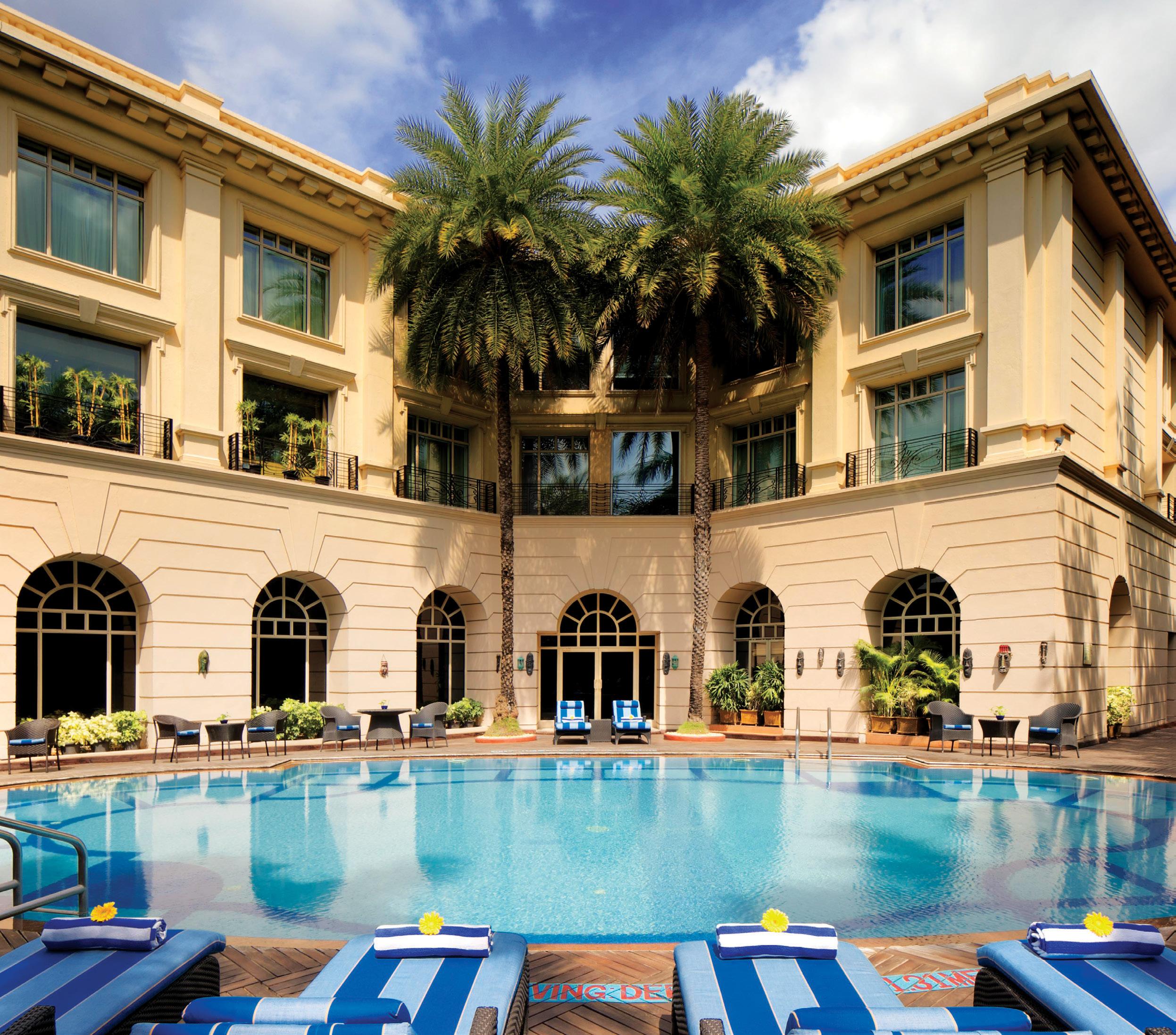
biohacking techniques such as red light therapy, cryotherapy, and sleep therapy.
Nutrition is also a focus, with thoughtfully curated menus that promote well-being, featuring options like Vedic, plant-based, vegan, and gluten-free selections. Yoga studios are integrated into the hotel experience, with state-of-theart equipment provided by Precor in a newly renovated 3,000 sq. ft. gym at Radisson Chennai. This gym features a cardio section that uses AI to track previous workouts, alongside areas for strength training and
CrossFit. Curated treks and trails offer guests the chance to explore their surroundings, enhancing the overall wellness journey.
The GReaT (a pun on GRT) branding encompasses GReaT sleep, GReaT touch, GReaT nutrition, and GReaT movement, implemented wherever possible across properties. While select service hotels like Zibe may not feature spas, the wellness philosophy remains consistent.
GReaT Social initiatives are grounded in the principles of Blue Zones, where longevity is celebrated.
All hotels embrace a pet-friendly and smoke-free policy—a bold decision that faced initial scepticism. “People claimed guests would leave,” Cotah remembers. “But as a policy towards well-being, we became smokefree in all our hotels. It’s worked out well because I think every guest has appreciated it.”
These initiatives reflect the group’s tagline, ‘Promise of More.’ In the context of a Radisson-branded property, this means a stronger commitment to luxury, while Zibe represents a promise of smart stays. “We are not competing on price; we are competing on value,” Cotah
Sustainability isn’t just a buzzword—it's a pressing need, and GRT Hotels, under the leadership of its CEO Vikram Cotah, is setting an example by turning commitment into action. As more hotels recognise the urgency to go green, Cotah shares 12 foundational steps every property can take to kickstart their sustainability journey. From simple operational tweaks to mindful energy use, these practical tips provide a roadmap for hotels looking to make a meaningful impact on the environment. Here's how to begin the transformation.
Energy Conservation
Measure and reduce energy consumption.
Install energy meters in critical areas (diesel, grid power).
Water Conservation
Measure and reduce water usage.
Install flow metres to measure water sources (bore well, tanker).
Waste Reduction
Identify and reduce waste generation.
Weigh waste (dry, wet, bottles, IT waste) to track and analyse.
Carbon Footprint
Measure and reduce carbon emissions (will be done by a third party).
Linen Reuse
Implement a linen reuse program for guest rooms.
Offer credits to guests who participate.
Plastic Reduction
Eliminate single-use plastic in F&B operations.
Implement a plastic-free dining table SOP.
Sustainable Drinking Water
Replace single-use plastic water bottles in guest rooms with glass bottles with RO water.
Toiletry Refills
Replace single-use mini toiletry bottles with bulk amenities in guest and public bathrooms.
Eco-Friendly Cleaning
Use green cleaning products for housekeeping and laundry.
Food Choices
Offer vegetarian options.
Promote local and hyperlocal food (sourced from within 100kms).
Community Engagement
Implement community benefit programs.
Hire differently-abled staff.
Equality
Reduce inequalities.
Promote gender equality in the workforce.
THIS SPREAD: Radisson Blu Hotels and Suites GRT Chennai recently underwent a renovation that blends technology with nature. A standout feature of this update is the terrariums, which also serve as light fixtures in the biophilia suites.

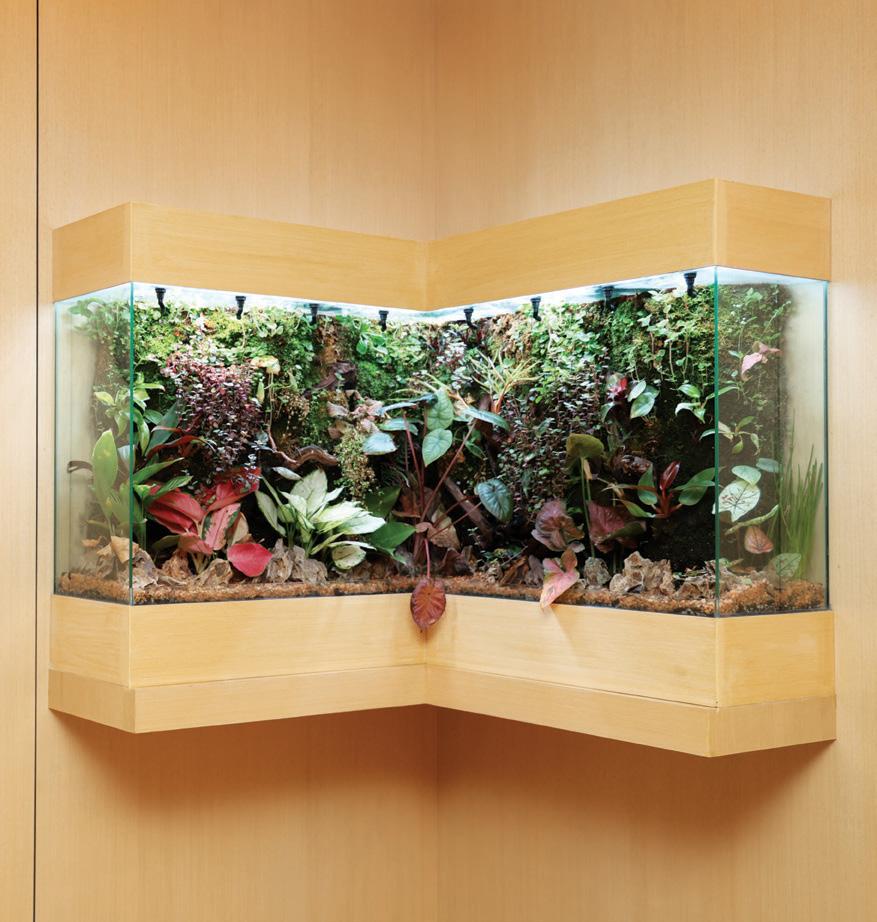
GRT Hotels prioritises guest comfort with a strong focus on sleep quality. Their hotels feature custom King Koil mattresses, which are exclusive to the brand, and designed with a 12-inch profile and multiple layers that guests rave about. To enhance the sleep experience, they offer a pillow menu with eight varieties and four duvet options for guests. Additionally, GRT Hotels provides white noise machines upon request and a comprehensive sleep kit, including lavender spritzers to promote relaxation. Their rooms also ensure complete blackout for optimal sleep conditions.
asserts, emphasising the intention to provide guests with more meaningful experiences.
GRT's partnership with Radisson has flourished for 26 years, evolving alongside the brand in India. Radisson provides international exposure, brand equity, training, and adherence to global standards, enhancing operational practices like housekeeping techniques. Their established distribution networks offer significant advantages in collaborating with large OTAs and PMCs for revenue management pricing. In return, GRT brings invaluable local market knowledge and operational excellence as both owner and operator. This synergy has proven beneficial since GRT
took over Radisson Chennai in 2001, the property’s inception dating back to 1998.
Over the years, GRT has rebranded Temple Bay Mamallapuram as Radisson Blu Resort Temple Bay Mamallapuram and transformed a resort in Pondicherry into the only internationally branded resort in the area, now known as Radisson Resort Pondicherry Bay. The Radisson Bengaluru City Centre, situated across from Ulsoor Lake, adds to this impressive portfolio. Cotah states, “We work with Radisson as a franchise, and they collaborate closely with us. We share a great synergy and leverage each other’s strengths. What GRT brings to the table is operational excellence; we have skin in the game as both owners and operators.”
There is a clear eagerness to explore further partnerships. “At the end of the day, we are asset owners,” Cotah remarks, underscoring GRT’s proactive approach. The company has signed a Memorandum of Understanding with Marriott for a Luxury Collection property in the Maldives and is in discussions with another hotel brand for a project in Hyderabad. Cotah adds, “We are also exploring opportunities on the 750acre coffee plantation located 40kms from Kodaikanal. There’s considerable potential for growth.”
The hospitality industry today is defined by three key themes: sustainability, well-being, and the rapid acceleration of digital transformation, particularly post-COVID. Cotah explains, “COVID fasttracked digital transformation. What we would have experienced in 2034, we are already experiencing in 2024.” GRT Hotels has fully embraced this shift, integrating technologies such as AI, NFC, augmented reality (AR), virtual reality (VR), and IoT across its properties.
At the forefront of this transformation is the concept of IoE (Internet of Everything). “We are working towards a future where people, data, and processes converge onto one platform,” says Cotah. This not only enhances operational efficiency but also improves guest experiences. GRT Hotels is pioneering the use of these technologies, making them a key differentiator in their offerings.
One innovative example is the AR map at Radisson Blu Hotels and Suites GRT Chennai, which allows guests to navigate the property on their mobile devices in real-time. “Traditionally, a staff member would escort the guest to their room and explain the facilities. Now, they can access the AR map, which positions them wherever they are and guides them to any



part of the hotel with the touch of a button,” he explains. This feature offers guests greater autonomy and caters to the preferences of Gen Z and millennials, who value choosing when and how they interact with people.
However, GRT Hotels is mindful of where and how technology is deployed. “While our larger properties such as Radisson Chennai and Grand GRT have digital tabs in rooms that can do everything for guests, in our Tier II city hotels like Regency Madurai, introducing such technology could be intimidating for older or less tech-savvy guests,” Cotah shares.
The approach is clear: use technology as an enabler, not as an overwhelming force. “We’re very careful about ensuring that technology doesn’t intimidate or scare guests away. It’s about finding the right balance—using tech where it enhances the experience, but always maintaining the human touch where it’s needed.”
Overtourism stands out as a pressing challenge in India’s hospitality landscape. “It will not only affect the planet and the ecosystem, but it can also diminish the overall guest experience. Imagine seeking a peaceful holiday with family, only to be surrounded by crowds and noise,” Cotah explains. While the surge in domestic tourism reflects a growing interest in travel, it predominantly favours traditional leisure hotspots and metro cities, leaving lesser-known locations overlooked due to insufficient infrastructure and limited access to quality accommodations. While established leisure destinations offer quicker returns on investment due to their popularity, developing new destinations requires time and resources. The exploration of lesser-known areas, such as the 750-acre estate near Kodaikanal, and places like Yellagiri and Yercaud, Cotah asserts, represents a proactive approach to mitigate this issue.
Technology also presents a dual-edged sword. The rise of AI in the hospitality sector is undeniable. However, this shift raises concerns about the essence of hospitality. Emphasising the need to balance innovation with personal interaction, he notes that technology should enhance productivity and service without compromising the human touch, so essential to hospitality.
In a landscape where hospitality faces numerous challenges, including global competition and changing consumer preferences, GRT Hotels & Resorts is committed to staying ahead by prioritising sustainability, encouraging responsible wellbeing, embracing technology, and providing memorable experiences rooted in local culture. As Cotah puts it, “We have a strong purpose to make responsible tourism the future for the country. And within that future, I see GRT Hotels amongst India’s top three boutique hotels.”


SOH | VOYAGES OF INFLUENCE
How the former Indian skipper and one of India’s greatest cricketers, Virat Kohli finds serenity through travel and family.
AS TOLD TO ALEX MASCARENHAS








Virat Kohli, India's star cricketer and former captain of the Indian cricket team, is known for his aggressive batting style and his unwavering dedication to fitness. But off the field, Kohli has a different passion: exploring the world in style. His travel choices, often alongside his wife, actor Anushka Sharma, offer a glimpse into a lifestyle that blends luxury, exclusivity, a love for plant-forward cuisine, and a quest for serenity.
For Kohli, travel means spending quality time with his family. Travel allows him to bond with his family in private, peaceful surroundings, away from the demands of public life.
The first travel memory: Long before the roar of packed stadiums and the flash of cameras, a young Virat Kohli, just six or seven years old, embarked on a journey that would spark a lifelong love for travel. His destination: the picturesque hill station of Ooty, nestled in the Nilgiri mountains of Tamil Nadu.
Those early memories—hiking through tea plantations, the mist and the mountains—were all about escape and adventure. It was a world away from the cricket practice and schoolwork that usually filled his days. It was the beginning of a lifelong passion for exploring new destinations.
The family escape: Whether it’s exploring in Bhutan or enjoying a beach vacation in the Maldives, Kohli’s trips underscore the importance he places on balancing work with family life. “Travel becomes a way for me to create lasting memories with my loved ones,” he states.

Travelling the world: Then there is travel for cultural explorations across the world. Kohli’s travels reflect a curiosity and appreciation for different cultures and traditions. “My favourite travel destination would be somewhere in Europe, but Australia, too, is a great place to holiday, as is one of the Arctic countries,” he says. “No one knows me at all and it is a wonderful feeling to walk around.”
His recent trip to Queenstown in New Zealand made him fall in love with the destination. “I haven’t seen a destination as beautiful as that one till today.” Not a lover of adventure sports, Kohli says, “I am not fond of hikes. Our contract prohibits us from indulging in adventure sports. I have rafted when I was a child in Nanital, and would love to do that some time when I am done playing.”
Kohli’s trips often have a spiritual or mindful element. His welldocumented trip to Bhutan, where he visited monasteries and explored serene mountains, showcases his belief in mindfulness and the importance of mental well-being. “We love to discover destinations and places, to experience new things.”
CLOCKWISE FROM TOP LEFT: Tuscany's vineyards and historic villas are the ultimate romantic escape; Pristine beaches and a focus on privacy ensures Maldives is a tranquil getaway; On his Bhutan trip, Kohli visited monasteries in a vacation that combined mindfulness and mental well-being; Kohli claims he hasn’t seen a destination as beautiful as Queenstown in New Zealand; London offers a mix of culture, fine dining, and urban luxury; Zermatt in Switzerland is known for its world-class skiing and charming villages.

Virat


Maldives
This island paradise is a regular escape for him and his wife. With its pristine beaches, luxurious overwater bungalows, and focus on privacy, it's easy to see why the Maldives is a favourite for those seeking a tranquil getaway. Kohli appreciates the seclusion and personalised service that resorts like One&Only Reethi Rah offer, allowing him to unwind away from the spotlight. “From private infinity pools to underwater restaurants, the Maldives is exclusive and serene,” says Kohli.
Bhutan
Kohli and Sharma's 2019 trip to Bhutan captured the essence of mindful travel. They embraced the country's serene landscapes and the Himalayas, exploring ancient monasteries, and connecting with the local culture. Bhutan's emphasis on sustainable tourism aligns with the couple's values, making it a perfect destination for those seeking a luxurious yet eco-conscious experience. Its high value, low-impact tourism policy ensures an “intimate, uncrowded experience, making it a paradise for travellers,” he says. The couple's Bhutan trip reflected their love for nature and mindfulness. “Bhutan’s culture of happiness, minimalism, and natural beauty resonates with our love for wellness and peace. With its emphasis on happiness and peace, Bhutan became an important journey that nourished the mind and soul.”
Switzerland
The Swiss Alps provide a stunning backdrop for Kohli's adventures. Whether he's hitting the slopes or relaxing in a luxurious chalet, Switzerland offers a mix of adventure and opulence. The couple frequents destinations like Zermatt, known for its world-class skiing and charming villages.
Europe
From the rolling hills of Tuscany to the vibrant streets of Paris, Kohli and Sharma have explored Europe's diverse offerings. Tuscany's vineyards and historic villas provide a romantic escape, while Paris offers a blend of culture, art, and fine dining. “Tuscany is famous for private wine tours, farm-to-table dining, and peaceful retreats, which is what we enjoy.” Destinations such as Castello di Casole and Borgo Santo are charming getaways.
England
While Kohli often travels to England for cricket tours, he also enjoys spending leisure time there. “London, in particular, offers a mix of culture, fine dining, and urban luxury,” he says.
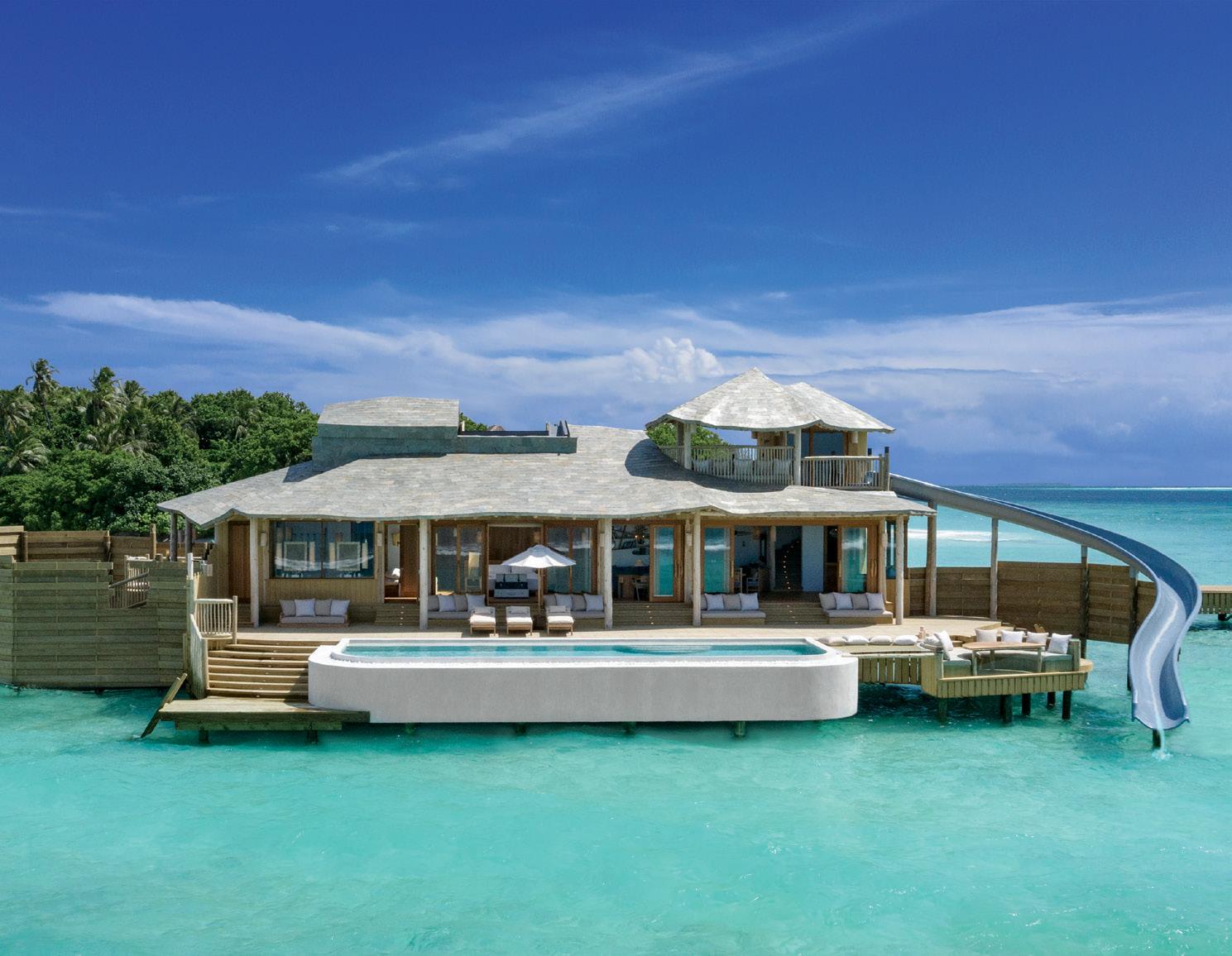
New Zealand
New Zealand is another favourite for the couple, known for its stunning landscapes and adventure activities. Kohli enjoys the outdoor activities and scenic beauty the country has to offer. Says Kohli, “New Zealand’s combination of nature trails and relaxation (luxury lodges, wellness retreats) fits our active lifestyle.”
Goa, India
Closer to home, Kohli enjoys the beaches of this tropical destination. “I like laidback beach vibes and the privacy that comes with exclusive beach resorts. Not to forget great food.”
The hotels he stays in: As a cricketer, he has stayed in several beautiful hotels across the world, but there are his favourites. One&Only Reethi Rah, Maldives stands out for its opulent overwater villas, private beaches, and world-class service. Soneva Fushi in Maldives is a “sustainable paradise, and aligns with the values we believe in, all set in luxurious surroundings”. In Bhutan, they have stayed in the Aman Hotels, again loved for the serenity and peace. In Maldives, Taj Exotica Resort & Spa is a great escape from the crowds. Ananda in the Himalayas is a “well-known retreat on the foothills of the Himalayas, and very interesting for detox, rejuvenation and mindfulness”.
Beyond the destinations: Travel provides Kohli with precious moments to connect with his wife and daughter. “I often feel the need to take time off to reset and recharge. My travel, especially to nature-filled, serene locations, reflects my need to relax, away from the media frenzy and high-energy sports world.”

LEFT: Soneva Fushi is a sustainable paradise, and aligns with Kohli’s values of mindful living set in luxurious surroundings.
TOP: Virat Kohli and Anushka Sharma in Queensland. BOTTOM: Ananda in the Himalayas, a retreat on the foothills of the Himalayas, is a perfect destination for detox, rejuvenation and mindfulness.
“ I have rafted when I was a child in Nanital, and would love to do that some time when I am done playing.”



A food lover’s journey from butter chicken to balanced meals: Kohli's love affair with food is a story of transformation. In his early days, the cricketer was known to indulge in rich, flavorful curries and buttery naan—a testament to his Delhi upbringing. But as his focus on fitness intensified, so did his awareness of how food fuelled his performance.
Today, Kohli's plate tells a different story. “While I still like fine dining, my choices reflect a conscious shift towards clean eating and plant-based goodness. I have turned vegetarian for the last few years. A superfood salad is the best way to get taste and nutrition,” he says. At his own restaurant One8 in Bengaluru, there is a section on Virat’s Favourites. “It includes all my favourite food, from tartare topped with avocado with crispy corn, Japanese mayo and sriracha, served with scallions.”
His favourite cuisine at the moment happens to be Japanese. “I totally love the cuisine and have developed a taste for it.” Among the other restaurants he frequents is Cé La Vi in Dubai, with a view of the skyline from the 54th floor, where he dines on contemporary Asian cuisine that's as visually stunning as it is delicious. “In Mumbai, we like to go to Yauatcha, for its steamed dumplings,” he says. Wasabi by Morimoto is another favourite for “its sushi and other Japanese food”, as is Hakkasan.
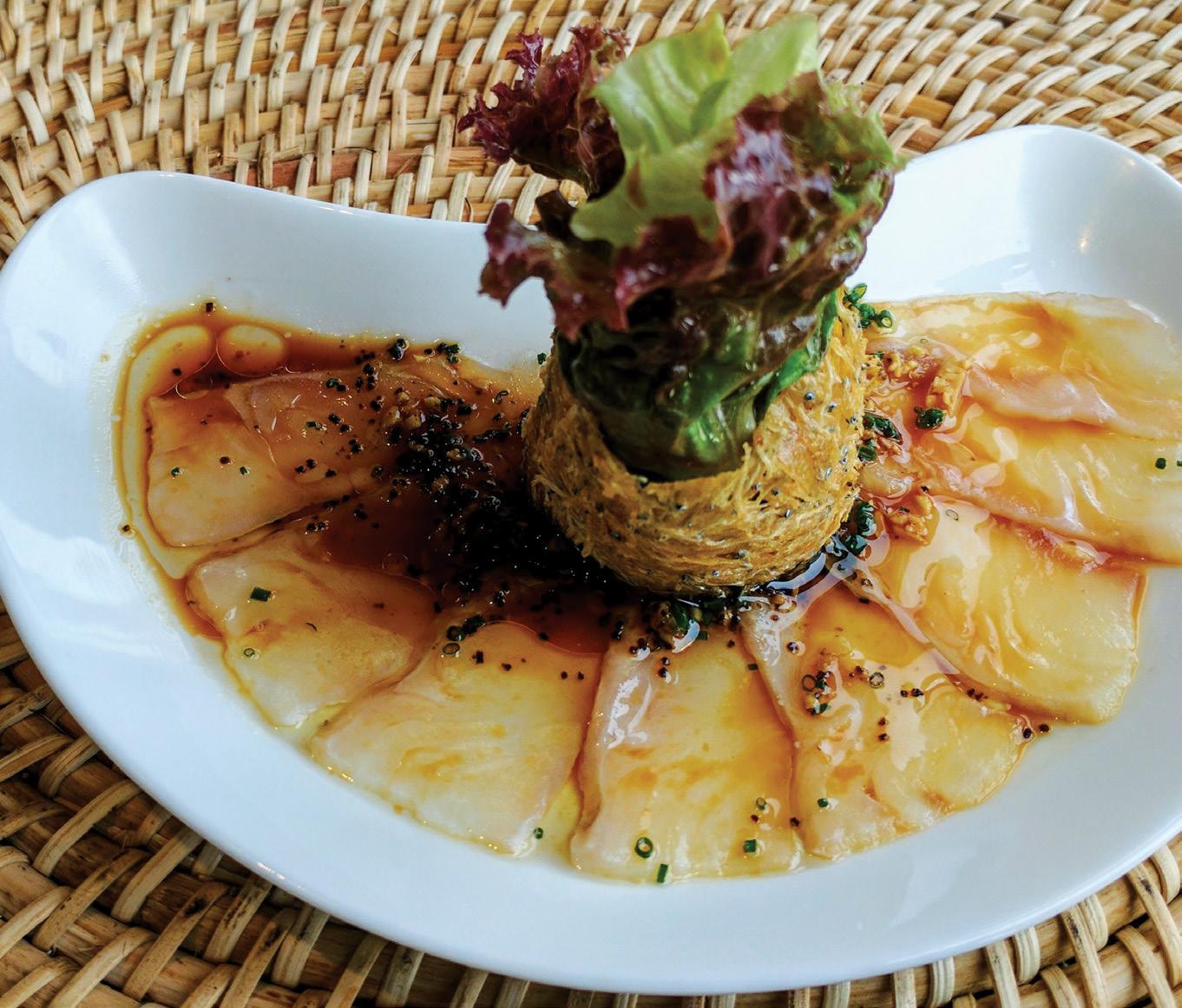
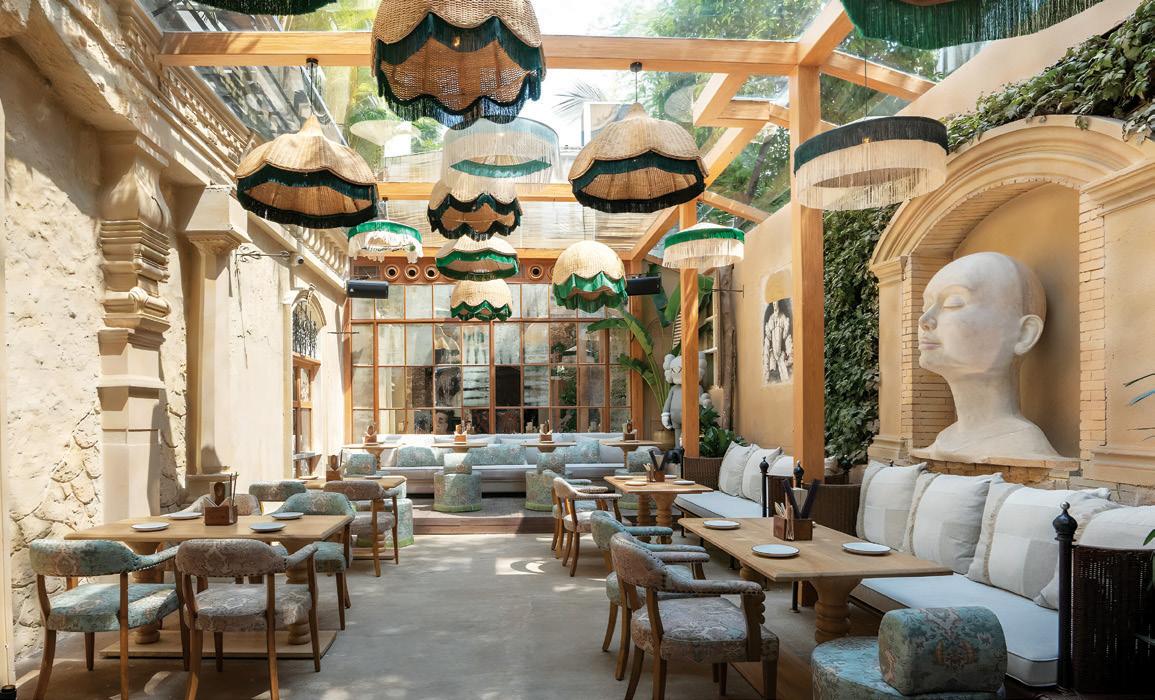
Kohli's culinary journey isn't just about upscale restaurants. His life hasn’t been cocooned in privilege, and growing up, street food and small restaurants in his home city, Delhi, have been his favourite dining destinations. India’s capital city's street food culture has evolved over centuries of influence, from the Mughals to the Punjabi migrants, a narrative which unfolds across its many bazaars and wayside restaurants.
For the best chole bhature, there is Civil Lines Wala, in Sector 15 of Gurugram. “There is also Ram Chole Bhature wal on Jail Road, which serves the most delicious dish.” But those days when he ate chole bhature are largely in the past. “You need carbs but it is important to understand what kind of carbs. My indulgence would be gluten-free desserts once in a while. I do not have too many cravings anymore.”








As digital nomads redefine how and where we work, hybrid hospitality emerges as the perfect solution, offering seamless integration of workspaces, living and leisure under one roof.
SUMAN TARAFDAR
Bengaluru-based techie Venkat R left his job at the height of the pandemic, determined to work from Coimbatore, his hometown. The move held him in good stead because of the emerging co-working spaces in the town. Then the travel boom began, a trend he wanted to cash in on, hoping to work from the destination he travelled to.
The hospitality space has witnessed a few paradigm shifts in the past decade, and hybrid hospitality seems to be the latest to challenge longestablished norms. While the concept was already finding early adopters preCovid, the pace has quickened. ‘Low Touch Economy’, a concept that swept the world post-pandemic, has helped it evolve.
The loss of revenue during the lockdown period spurred hotels to innovate. According to a Hotelivate 2020 report, Covid-19 and its Impact on the Indian Hotel Industry, India’s organised hotel industry loss due to the Covid-19 epidemic was in the range of US$1.55 billion. While the blended nationwide occupancy dipped by 18 to 20%, the blended nationwide ADR saw a drop of 12 to 14%. This was true for the hospitality industry across the world.

To draw new categories of people, hotels are adapting multiple spaces within their premises to include spaces to work, dine and lounge in.

The hospitality industry was forced to innovate and think outside of the box. The germ of this concept came from Airbnb’s path-breaking offerings. Global trends have been moving towards mixed-use real estate long before COVID-19. Late in 2019, PricewaterhouseCoopers identified mixed-use as the second most popular property type in a survey among investors considering what to do with defunct assets.
The rise of hybrid hospitality, then, was a trend foretold.
Hybrid hospitality allows the increasingly popular breed of ‘digital nomads’ the opportunity to combine work with pleasure while being anywhere around the world. Often, empty ‘business centres’ that hotels traditionally—and safely—estimated to be the least
FAQS What is hybrid hospitality?
The concept could be best defined as a mix of the traditional hotel experience, blended with elements of co-working and co-living spaces, and easy access to restaurants, wellness facilities, retail and more.
Why is hybrid hospitality the new norm?
Simply put, even without a lockdown, technology was already making remote working possible. Now this has evolved to remote working, especially popular with digital nomads. Perhaps the increased
alluring public space in an average hotel, are getting a makeover.
With hybrid hospitality, people can live, stay, eat, drink, work and socialise all in one dynamic space, says co-living consultant and community experience specialist Leah Ziliak. “Hotels, hostels, restaurants, bars and other hospitality venues are making the shift towards multifunctional spaces that foster connection and enhance the overall guest experience.” She points out, “With a co-working space, community events, group fitness classes, and even a mini-movie theatre and a popcorn machine, this is more than just a hotel; it's an experience.”
Hotels have been eager adapters, seeking to increase revenue from untapped sources within the hotel. To draw new categories of people to their hotels, owners and operators are reimagining the use of multiple spaces within their premises— meeting rooms, lounge rooms, restaurants/bars, parking spaces, laundry facilities, gyms, swimming pools et al, and seeking to better cater to the needs of people who live and work in surrounding areas.
Some hotels are going beyond offering bleisure options to
uncertainty people encountered during the COVID period made them relook at work-life balance, with a thriving career now balanced with personal well-being.
How are hotels catering to the new requirements?
Hotels, forced
to innovate, are leveraging technology to offer alluring workspaces, flexibility of location, a range of services, dining and entertainment options, and even health and wellness offerings, etc. This helps them generate additional revenues from the new sources.


anchoring the neighbourhoods by even offering retail, entertainment, dining and other options.
The trend of hybrid hospitality is sprouting healthy green shoots.
A look at Zoku Loft in Amsterdam reveals why this innovative home-office hybrid, which offers lofts with hotel services, is path-breaking. The centrally located hotel caters largely to international guests, for instance, globetrotters, digital nomads and remote workers. According to Veerle Donders, Concept & Brand Director at Zoku, a hybrid hotel works like a 24/7 ecosystem that blends different functions, each having a potential effect on the other.
The best hybrid hotels are making an effort to stand out from the crowd.
According to Veerle Donders, Concept & Brand Director, Zoku, residents can balance their private life with work in the Zoku Lofts, which are cleverly designed to resemble a home. Here, guests can access everything they need to live comfortably and work efficiently. The space allows them to invite others into their ‘home’ since they can eat, meet and play around the large kitchen table.
Architecturally, Zoku’s Social Spaces are designed to bring people together. Barriers between staff and residents are reduced to a minimum to allow for a more homely feel. Instead of a traditional reception desk at Zoku, guests are welcomed by a large coffee bar table stacked with cakes. Long communal tables, customisable art frames, and cosy living room nooks easily facilitate connections between strangers.
Hotels like Ginger, Fairfield Marriott, and ibis Styles have witnessed a paradigm shift in their design to appeal to Gen Z.
Hybrid hotels are utilising their square metres much more efficiently by using their space for sleeping, working, eating, drinking and events during different times of the day. The aim is to use each square metre as efficiently as possible. At Zoku Loft, there are no hotel rooms. Instead, there are lofts that during the day can be used as a meeting room or workspace, and during the evening as a living space.
Marriott in London has recently been among the top performers in engaging local consumers with the option of selecting an extended stay inventory, whether they want to live, work, or play, according to Toposophy, an Athens-based




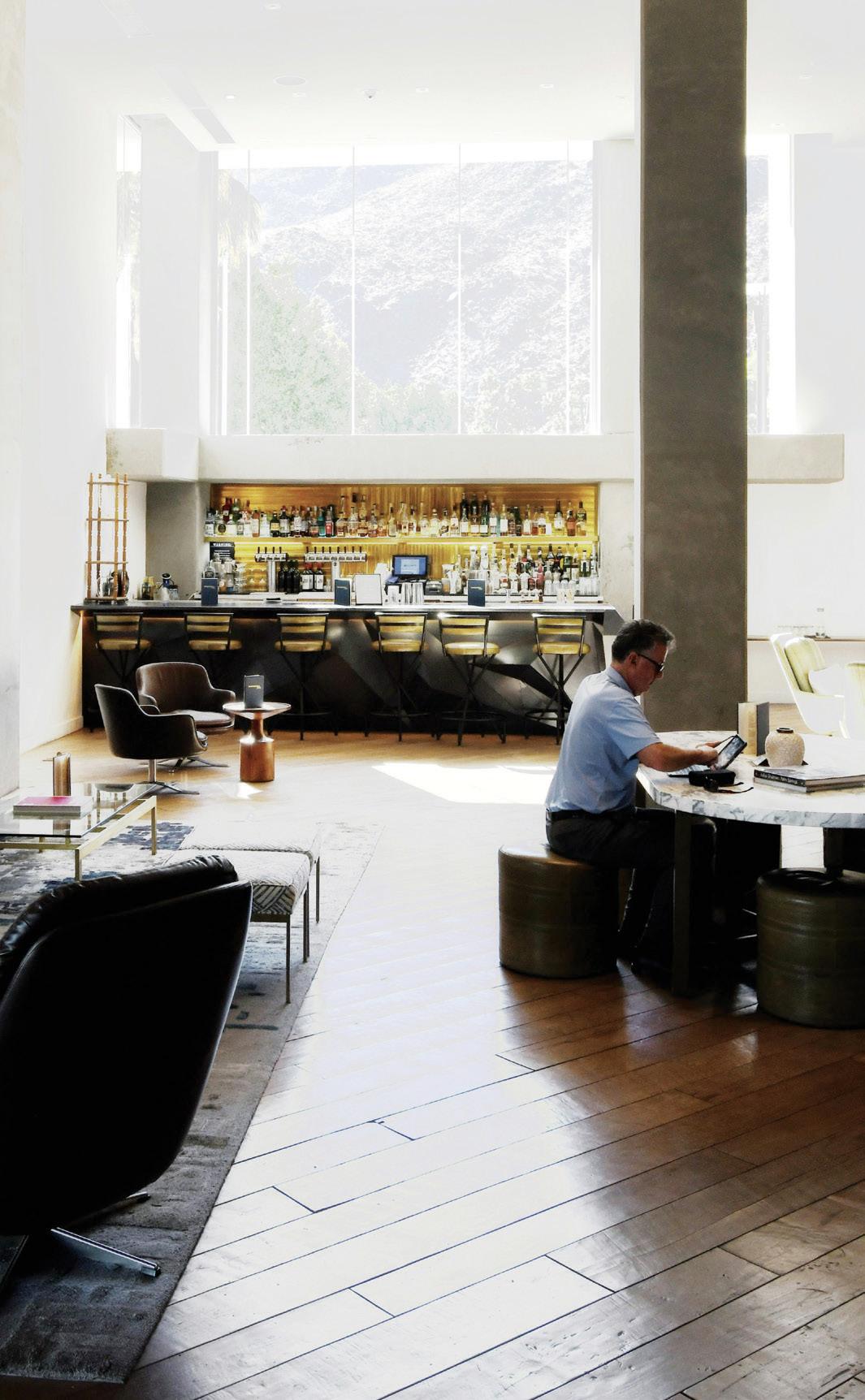
Hybrid hotels are utilising their square metres much more efficiently by using their space for sleeping, working, eating, drinking and events.

marketing group. Paris’ Le Grand Quartier defines itself as a ‘place of life and a place of exchange’, seeking to blend hotel services and activities that allow stay and non-stay guests to interact and immerse themselves in different experiences.
Hotel management company Cross Hotels & Resorts introduced its ‘destination-centric’ and hybrid hotel brand, Lumen, by opening Lumen Bangkok Udomsuk Station in Thailand earlier this year. Cross Hotels & Resorts CEO Harry Thaliwal said at the opening: “Lumen is a special hospitality brand that adapts to its neighbourhood and brings the local community into its fold.”
The Indian reference point
In India, too, hotels have begun to open up, though currently, most offering ‘hybrid’ experiences have
largely jazzed up their erstwhile business centres and combined with them better WiFi and better coffee. Hotels like Ginger, Fairfield Marriott, and ibis Styles have been re-imagined as hybrid hospitality offering. Marriott has introduced the young brand, Moxy, in India, to appeal to the young and the digital nomad traveller.
Yet, hybrid hospitality is still largely a bleisure offering in India. But with the country’s hospitality scene adapting quickly to global trends, we could soon see hotels emerging as neighbourhood hubs. Venkat, of course, is thrilled with all the options available. Given that his organisation allows remote working, his long-held desire to see the world has become possible, without compromising on his job. All he needs to ensure is that the hotel he plans to stay in has high-speed WiFi.
DESIGN
From shaping moods to supporting sustainability, lighting plays a pivotal role in hospitality design. Experts reveal how strategic lighting can elevate guest experiences while balancing aesthetic, emotional, and operational demands.
RUPALI SEBASTIAN

Lighting in hospitality goes beyond mere illumination; it shapes the identity of a space and orchestrates the guest journey from the moment they walk in. Whether it's the warm lighting that evokes a sense of welcome in the lobby or the dimmed, intimate glow in a fine-dining restaurant, strategic lighting enhances mood and influences behaviour. It highlights architectural details, supports brand storytelling, and integrates seamlessly with design elements, all while balancing function and sustainability. As technology advances, lighting in hospitality also plays a pivotal role in energy efficiency and customisation, making it integral to both guest satisfaction and operational success.

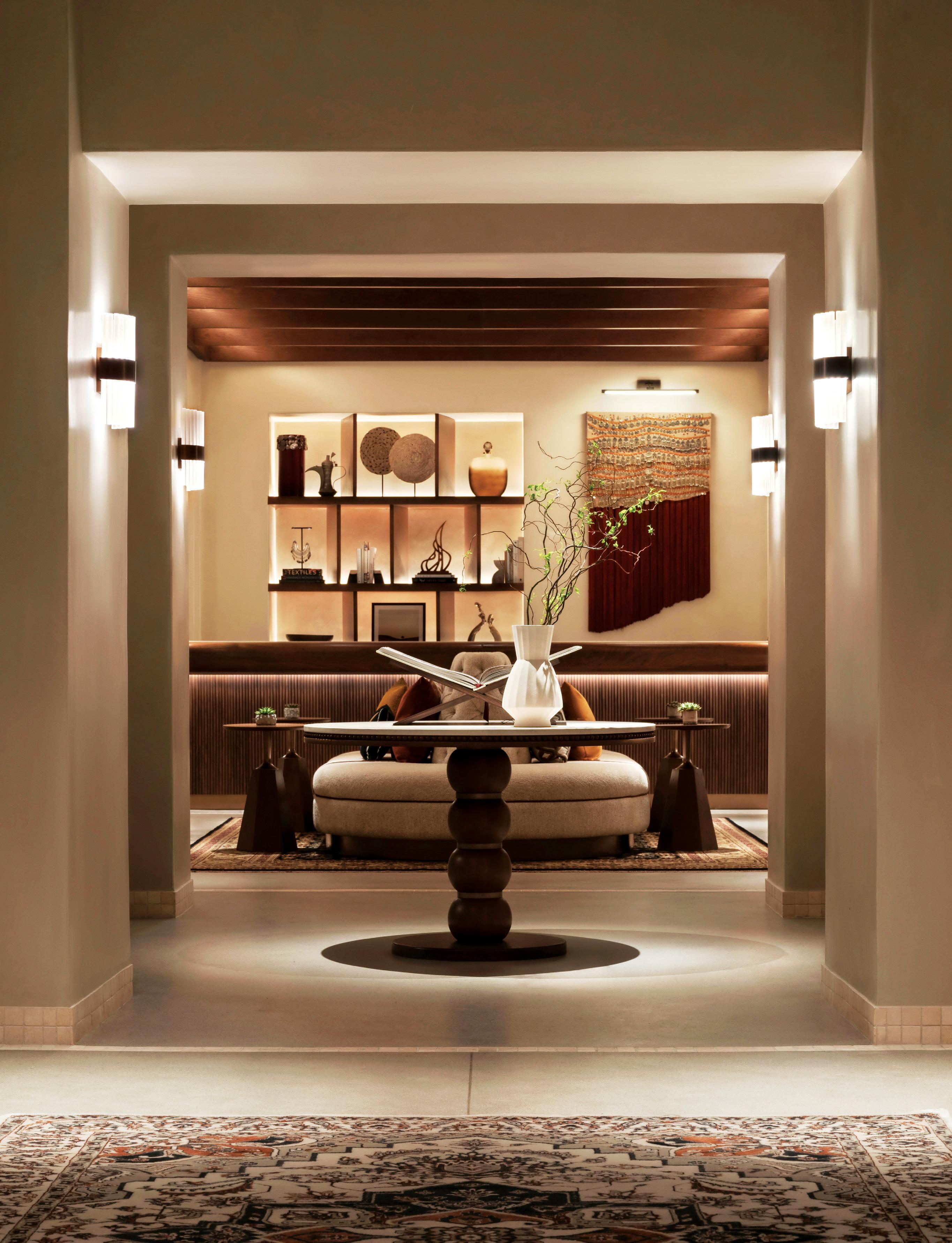


“Ultimately, lighting is about storytelling. It has the power to transform a physical space into a sensory experience,” says Siddharth Mathur, Partner at Studio Lumen, a global lighting design consultancy. “The way a space is illuminated profoundly influences how people feel, think, and interact within it.” Beyond mood, lighting shapes perception and behaviour. It can make a room feel expansive or intimate, accentuate or soften architectural elements, and even shift our sense of time. “Lighting has the power to determine whether we form an emotional connection with a space—or disengage from it entirely,” Siddharth adds.
But nothing underscores a point more convincingly than a compelling example. To illustrate the impact of lighting in hospitality, we turn to Sandeep Basur, Principal of Lucent Worldwide, who has led over 7,000 projects globally. He starts with a bold statement: "Hospitality is 80% a night business, and only 20% a day business. And being a night business, we are dependent on artificial lighting.”
The example he gives takes us back to 2010, when he was engaged by an international chain of resorts to design properties across Southeast Asia, some nestled in jungles, others on islands, where guests were meant to immerse themselves in nature. After about

SARVDEEP
PRINCIPAL,
LUCENT WORLDWIDE
“We’ve come full circle— rooms were brighter four decades ago, then moved
towards darker tones.
Now, we’re seeing a return to brighter rooms, with an emphasis on decorative lighting and indirect sources like coves.”
Lighting for The Park Indore (EXTREME LEFT) and The Sanya EDITION, China (LEFT) has been designed by Sarvdeep Basur-helmed Lucent Worldwide.
RIGHT: Multiple bands of linear cove lights provide diffused general illumination in the central circulation core of Courtyard by Marriott, Madurai. Lighting design by Amardeep Dugar.
a year, feedback from guests started trickling in. To everyone’s surprise, people booked for a week but were leaving after just two days. “The most common complaints were that they felt bored or lonely,” Basur says. The feedback was unexpected, especially for resorts in such idyllic, serene settings. It was conveyed to the project consultants, including Basur, who took it upon himself to investigate. “I admitted that it might be the lighting,” he says.
In two of the resorts, his team decided to brighten the spaces, making them more vibrant, rather than soft and somber. Within a month, guest feedback had shifted. The resorts even invited back some of the same guests, and their responses were overwhelmingly positive. “People are used to bright city lights,” Basur notes, observing that many guests came from bustling cities, where light pollution dominates the night sky. In these darker, more natural settings, they felt out of place. “Our DNA is accustomed to the dark,” Basur muses, “but in the short term, we crave bright lights.” While lighting wasn’t the sole issue, it became clear that creating a sense of familiarity through brighter spaces played a major role in improving guest satisfaction.
“The best compliment to a lighting designer is when people don’t notice the lighting, only experience a space,” says Linus Lopez, partner at Delhi-based lighting consultancy Lirio Lopez. He emphasises that the goal of lighting design varies, depending on the location and typology of a space, such as a resort, business hotel, or beachside property. The key is to create an immersive experience that

complements the surroundings. For example, in a mountainous location with breathtaking views of snow-capped peaks, lighting should create a warmer, cosier ambience, while a beachside resort can use dynamic light to complement the changing colours of the sunset.
For architect Bobby Mukherji, who has spearheaded numerous hospitality projects from both architectural and interior design perspectives, it's the power of lighting to evoke drama and atmosphere that captivates him the most. “Lighting transforms a space,” he explains. “Textures on walls, art objects highlighted through a blend of direct and indirect lighting, the soft glow of a table or floor lamp—all these elements work in concert to create a rich, atmospheric environment.”
Mukherji also highlights how lighting can redefine a space from day to night. “When a place transforms after dark, it becomes an entirely different experience for those staying 24 or 48 hours, or even longer. This shift brings a delightful change,” he says.
The emotional impact of lighting in hospitality spaces cannot be overstated. “Light is one of the most powerful yet flexible elements of a spatial experience. Like poetry in literature…like tempo in music,” says Harmeet Singh Issar, Founder-partner and Design Director of Delhiheadquartered Design Matrix, a lighting design studio with 400+ projects under its belt, in a lyrical reflection. “It brings an immense degree of richness and emotion to the space.” Issar even describes lighting as the “most humane” element within a space, second only to the hotel team itself, given its unique ability to be both flexible and adaptable.
Both Lopez and architect Abhishek Mathur, Director at Studio HBA, highlight a crucial goal in hospitality design: creating a sense of “coming home.” However, in the context of a hotel, where guests come from diverse backgrounds and experiences, the concept of “home” can mean different things to different people. “Therefore, lighting must be versatile, offering warmth, comfort, and a personalised experience,” says Abhishek. Warm colour temperatures—associated with comfort, relaxation and companionship—and layered lighting mimic the familiar ambience of a home, while smart lighting systems allow guests to adjust brightness and colour to suit their preferences, “enhancing the feeling of ownership over the space,” notes Abhishek.
Before diving into the biological impact of artificial light, it's essential to recognise that our responses are deeply rooted in ancestral experiences with natural light, spanning nearly 10,000 years. The colours of sunrise and sunset signal changes in time, while the interplay of light and shadow helps us interpret spaces. Building on this, lighting design today has evolved to harness our innate biological responses to light. “Human physiology is governed by light. When this is positively influenced, it leads to a sense of comfort and well-being,” says architect Kapil Surlakar, Director of Design at Goa-based Light@Work Design Consultants. An understanding of circadian rhythms and human physiology helps designers make informed decisions that align with the architectural and functional character of a space, ensuring the desired emotional effect is achieved.
Praveen Thampi, whose firm Ministry of Light has lent its expertise to several projects in Asia and the Middle East, reveals that this approach is called human-centric lighting design. “It involves a circadian software

“Lighting has the power to transform a physical space into a sensory experience. It has the power to determine whether we form an emotional connection with a space—or disengage from it entirely.”


program that adjusts the colour temperatures and wavelengths of luminaires in sync with the sun’s natural changes over the course of the day,” he explains.
However, not everyone agrees that circadian lighting is suitable for hospitality spaces, particularly in hotels. Basur offers a contrarian view that challenges the common narrative: “Circadian lighting, while effective in offices and workspaces, doesn’t really work in hotels,” he argues. Basur points out that guests don’t spend enough time in areas like hotel lobbies for circadian lighting to have a meaningful impact on their biological rhythms. He also highlights research conducted in China and at MIT (in which he was personally involved), revealing that it’s not direct lighting that influences circadian cycles, but rather indirect lighting—especially the colour of the sky. According to Basur, to achieve a greater effect, designers should focus on keeping lighting levels and colours constant on tables, while allowing dynamic changes in ceiling and indirect lighting to simulate the natural shifts in the sky.
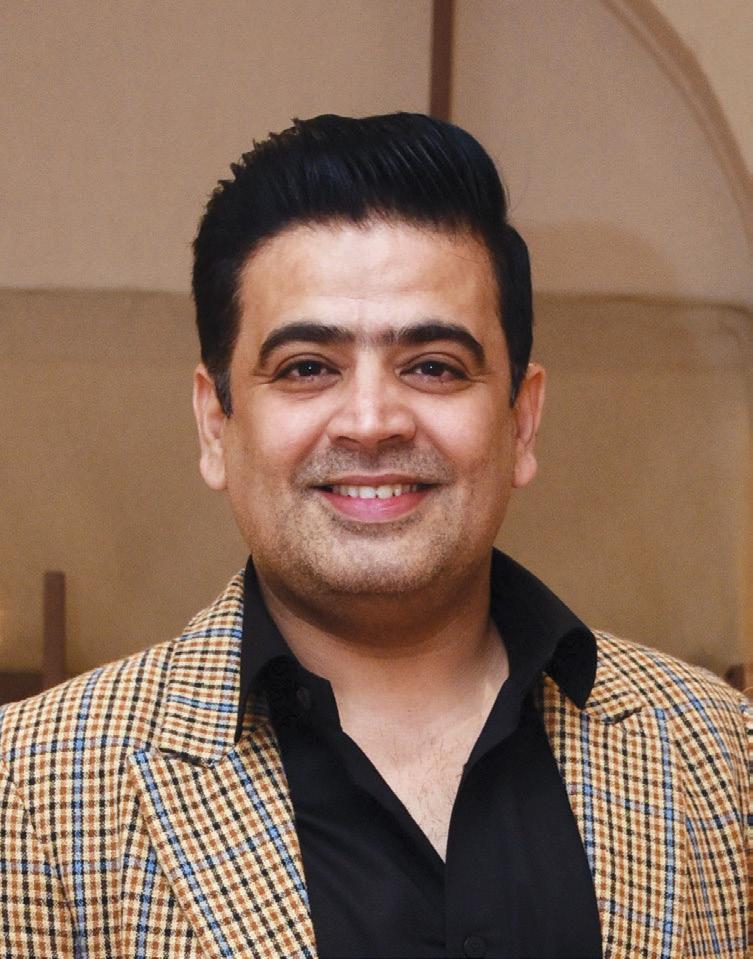
CO-FOUNDER, HYBEC
“Advancements in battery technology and wireless power for lighting systems are creating possibilities for more flexible and portable lighting designs that offer greater adaptability.”


The advent of LED technology was a major leap in lighting innovation, occurring around 15 years ago. Since then, newer developments are focused on enhancing its applications rather than reinventing the core technology.
One such advancement is the rise of smart lighting systems, which can be controlled through mobile apps, voice commands, or integrated with IoT devices. “These systems allow for personalised lighting experiences and seamless interactions, particularly in F&B spaces,” explains Dr. Amardeep Dugar, founder of Lighting Research & Design (LR&D), a Chennai-based design consultancy in architectural lighting. He notes that automated lighting systems are being designed to adapt to factors such as time of day, occupancy, or specific events. “Tuneable white lighting, which allows the colour temperature to shift from cool to warm tones, is also gaining traction,” he adds.


DIRECTOR, STUDIO HBA
“Lighting must be versatile, offering warmth, comfort, and a personalised experience.”
When it comes to aesthetics, Dugar highlights the increasing popularity of minimalist lighting design, where fixtures are recessed or integrated into the architecture. Using hidden light sources, such as cove lighting or wall washers, produces soft, diffused lighting that enhances the ambience without drawing attention to the source. This technique, Dugar notes, is particularly effective in creating a serene, luxurious atmosphere in guest rooms and spa areas.
Basur, focusing specifically on guest rooms, observes a shift back to brighter spaces. “We’ve come full circle—rooms were brighter four decades ago, then moved

towards darker tones. Now, we’re seeing a return to brighter rooms, with an emphasis on decorative lighting and indirect sources like coves,” he explains. Guest room designs have also simplified, with fewer switches and the introduction of manual rotary dimmers, making for a more userfriendly and minimalist approach.
Haresh Manshani, Co-founder, Hybec, throws light on what future has in store for this vertical in the form of upcoming technologies and innovations. “We’re excited about the potential of Li-Fi (Light Fidelity), which uses light waves to transmit data, offering faster internet speeds with enhanced security. This could revolutionize connectivity in hotels, particularly in spaces where Wi-Fi has limitations. Another exciting innovation is the use of biophilic lighting, which mimics natural light patterns and helps reconnect people with nature, contributing to overall wellness. Moreover, advancements in battery technology and wireless power for lighting systems are creating possibilities for more flexible and portable lighting designs that offer greater adaptability in hospitality.”
Maulik Jhaveri, Director, LightAlive Solutions, sees great potential in integrating Tunable White (TW) and Dim-To-Warm (D2W) technologies under a single DALI (Digital Addressable Lighting Interface) address, especially in luxury hospitality projects. He believes this could deliver


FOUNDER, MINISTRY OF LIGHT
“The art of achieving the operators' expectations, in line with international standards, while working within the tight budgets set by the owners, is the key to a successful project.”

the most significant cost-to-impact ratio, stating, “For lighting design, a less-is-more approach works best in high-end spaces, where visual balance is key. There’s also a growing trend towards using warmer tones of light, ranging from 2200K to 2700K.”
Mukherji emphasises that a lighting designer should be brought on board immediately after the concept stage—but his experience often finds them engaged much later in the process. Basur, however, has seen a shift over the years. “We may have faced that problem 20 years ago, but things have changed. Today, we work on 300 to 400 projects a year in India, and 90% of the time, we are brought in at the right stage.”
What happens when a lighting designer is brought into the picture at the appropriate time? “From the outset, we actively participate in discussions with architects, interior designers, and other creative partners to gain a deep understanding of the project's goals, the desired atmosphere, and the brand identity,” says Siddharth. Many hotel brands have specific values or themes, such as sustainability, wellness, or luxury. “The lighting designer works closely with the hotel’s branding and marketing teams to ensure that the lighting design reflects these


DIRECTOR OF DESIGN, LIGHT@ WORK DESIGN CONSULTANTS
“The quality of light, optical performance, and the lifecycle of products are critical components of sustainability, but they come with a price tag.”
values,” says Dugar. It’s no longer about about one-size-fits-all.
And so the design process continues—always in collaboration, never in isolation. “If that dialogue is missing,” says Lopez, “you could have a lighting effect that is either unachievable or, worse still, not possible to rectify later on. You might miss out on opportunities to create something more efficient, memorable, or impactful if you weren’t involved from the initial phases of design.”
Just as lighting designers need to enter the project at the right time, so do product partners, underscores Manshani, ideally “from the beginning of
a project. Advanced modelling software and real-time mockups help us visualise how the lighting will interact with the space. Flexibility and customisation are also key in addressing client-specific needs and ensuring the design aligns with their vision.”
One of the key challenges in designing lighting for hospitality projects in India, according to Thambi, is striking a balance between the expectations of hotel owners and operators. “As lighting design consultants, we are required to follow the Lighting, LMS (Lighting Management System), and GRMS (Guest Room Management System) guidelines set by the operators, which adhere to international standards,” Thambi explains. However, while operators focus on maintaining these global benchmarks, owners often look to reduce costs due to budget constraints.
Thambi highlights that, in most projects, lighting consultants are recommended by operators and appointed by owners, creating a unique challenge: “The art of achieving the operators' expectations, in line with international standards, while working within the tight budgets set by the owners, is the key to a successful project.” However, even the best design may not always result in a high-quality product, as

“For lighting design, a lessis-more approach works best in high-end spaces, where visual balance is key. There’s also a growing trend towards using warmer tones of light.”
owners sometimes cut corners by purchasing substandard lighting that fails to meet the required specifications. “Even if we give the best specifications at the lowest prices, the outcome can still be compromised,” he notes.
Jhaveri echoes Thambi’s concerns, pointing out that the market is flooded with cheaply priced lighting equipment that promise technical excellence
In lighting design, the absence of light can be just as critical as its presence. “There should be zero exposure of light in a guest room at night,” says Linus Lopez of lighting consultancy Lirio Lopez. “The guest needs to have complete control over the lighting to ensure a good night’s sleep. It’s equally important that façade or landscape lighting doesn’t intrude into the room.”
Sarvdeep Basur of Lucent Worldwide echoes this concern, pointing out how even small details can disrupt a guest’s rest. “People often overlook simple things like the placement of a nightlight,” he notes. “Then there are those tiny lights on appliance plugs that can be quite bothersome. While some illumination is necessary, since the room is an unfamiliar space for the guest, it shouldn’t be disruptive.”
Both Basur and Lopez stress the need for a broader perspective, saying, “We need to move away from the belief that we are the only important inhabitants of this planet. Rest and sleep patterns are crucial, not just for us but for the environment around us—including animals and birds.” This is why it’s essential to turn off lights at night, though the timing may vary depending on the location and the nature of the property.


FOUNDER, LIGHTING RESEARCH & DESIGN
“There is increasing popularity of minimalist lighting design. This trend creates clean lines and emphasises the lighting effect rather than the fixture itself.”
but often fall short in practice. “These lights often ignore crucial factors like glare control and beam quality, which can detract from the overall aesthetic of a high-end space,” Jhaveri explains. To counter this, his team actively educates clients by demonstrating the stark difference in quality between substandard products and higher-end fixtures. By showing clients firsthand how a 20% or 30% increase in price can lead to exponentially better lighting outcomes, they help ensure that quality remains a priority.
“Sustainability is a major driving force in the industry,” says Manshani. “At Hybec, we see clients increasingly prioritising energy-efficient lighting solutions such as LED fixtures, which offer significant reductions in power consumption.” Furthermore, there’s a growing interest in renewable energy integration, such as solar-powered lighting, as well as the use of recyclable and eco-friendly materials in fixtures, he adds. “The demand for lighting systems that support longterm sustainability goals,” he discloses, “is also pushing innovation in the areas of energy management and smart control systems, which minimise waste by adjusting lighting levels based on occupancy and time of day.”
But cost considerations pose significant challenges when trying to make a hospitality lighting project truly sustainable. “The biggest hurdle is integrating a high-quality control system that goes beyond simple mood and scene settings,” points out Issar. “Another challenge is advocating for sustainable equipment, which inevitably comes at a


higher cost. Even now, despite lighting being such a crucial element in any space, it's frequently undercut and inadequately funded.”
Sustainability in hospitality, however, has evolved beyond mere energy efficiency. “The quality of light, optical performance, and the lifecycle of products are critical components of sustainability, but they come with a price tag. It’s essential to educate the client and ensure the value is properly conveyed, encouraging them to adopt greener practices,” explains Surlakar.
With the lighting load significantly reduced—“It’s come down to just 10%,” says Basur—discussions around sustainability, as Surlakar notes, must focus on the cradle-to-grave energy embodied in a product: how fixtures or luminaires are manufactured, the materials used, and their recyclability. “Unfortunately, we’re lagging behind in India in this regard. We need to address this carefully because we’re massive consumers and only growing,” cautions Lopez. “More than any technological shift, this is where real change needs to happen.”
Cheaper, less durable products lead to frequent replacements—not just of the fixture itself but also of control gears and drivers. “That’s creating a lot of clutter,” Basur points out. “Reuse of fixtures is a trend that hasn’t yet caught on in India. In China, we signed two contracts with a vendor—one for the supply of lights, and another for the buyback of those lights. After 15 years—the expected product life—the vendor will buy them back at a predetermined price. If the lifespan falls short, the vendor will be penalised with an increased buyback price. In Europe, we’re working on similar assignments with the buyback model, though without the penalty clause.”
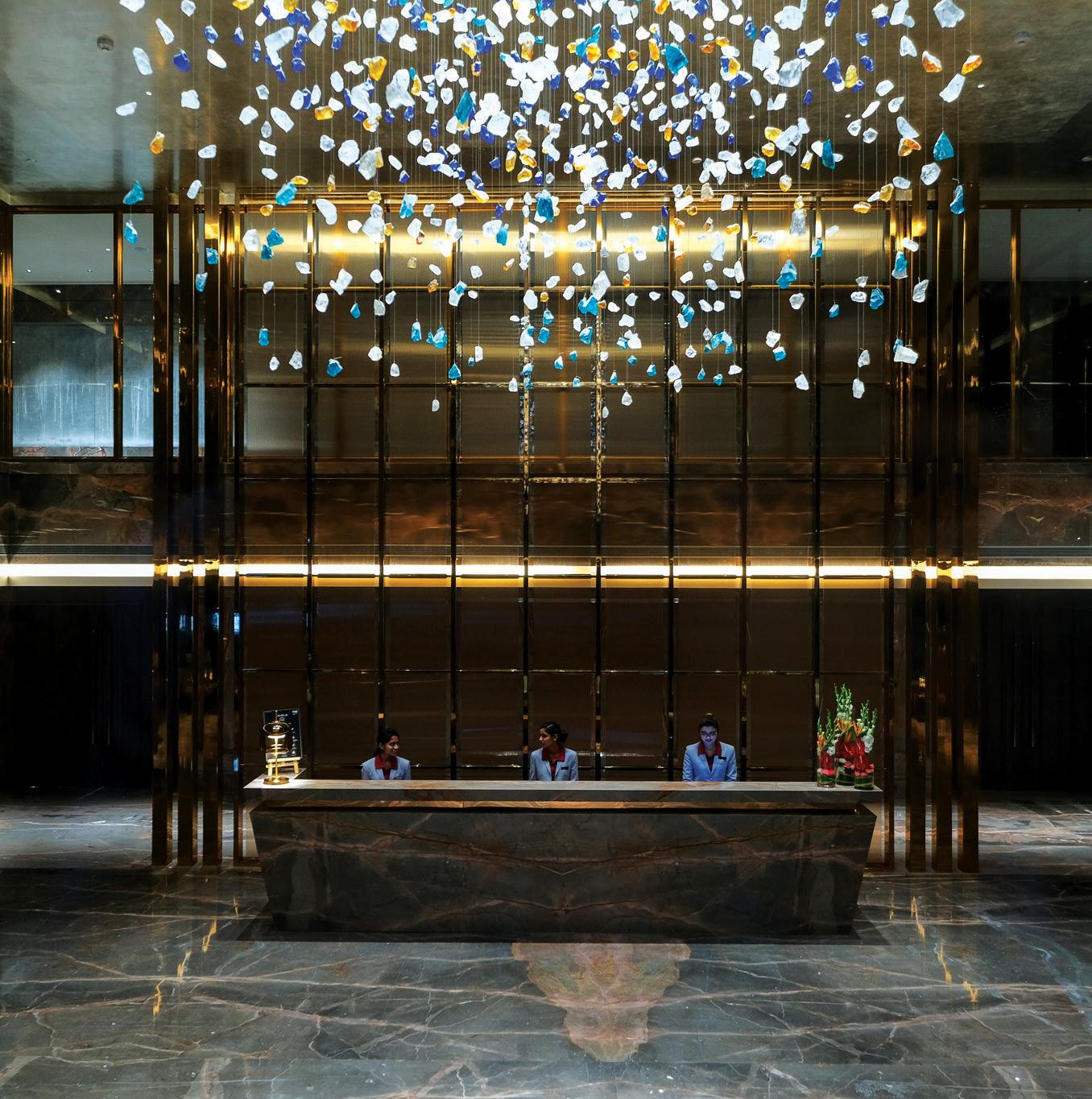

PRINCIPAL, BOBBY MUKHERRJI ARCHITECTS
“Post-occupancy visits often reveal mismatched fixtures in the same space, where different colour temperatures are used simply because certain options are more readily available.”
A key distinction between designing a residence and a hospitality space, despite the shared goal of crafting a comfortable experience, lies in the operational demands—hotels run 24/7, which fundamentally affects considerations of maintenance and durability. However, after what Surlakar describes as “a very thoughtful and responsive design process with the design team,” discussions often shift to costs, led by an entirely different set of stakeholders, who frequently overlook the design intent. “Their focus is on the cost mandate,” he explains, leading to compromises like cheaper fixtures that affect both operations and longterm maintenance.
Typically, a single lighting project requires integrating luminaires (sourced from one vendor), control systems (procured from another), and an execution team. “There needs to be complete synergy between all these systems. This is critical to the success of lighting in a hotel,” Lopez emphasises. Flexibility also plays a key role—not necessarily in corridors or guest rooms but certainly in conference rooms and banquet spaces that serve multiple purposes. Ultimately, the issue isn’t about budgeting for lighting—it’s about investing in quality lighting.
For Mukherji, addressing post-occupancy challenges is paramount. He tackles this by implementing preset lighting moods—typically three or four—to simplify operations for hotel management. “Keeping things uncomplicated for the top management is key,” he notes. These controls are often placed out of reach of other staff members to prevent tampering with the presets. Maintaining consistent colour temperature is another recurring issue. “Post-occupancy visits often reveal mismatched fixtures

FOUNDER-PARTNER AND DESIGN DIRECTOR, DESIGN MATRIX
“We feet lighting becomes the next 'most humane' part of the space—that is both flexible and adaptable— after the hotel staff.”
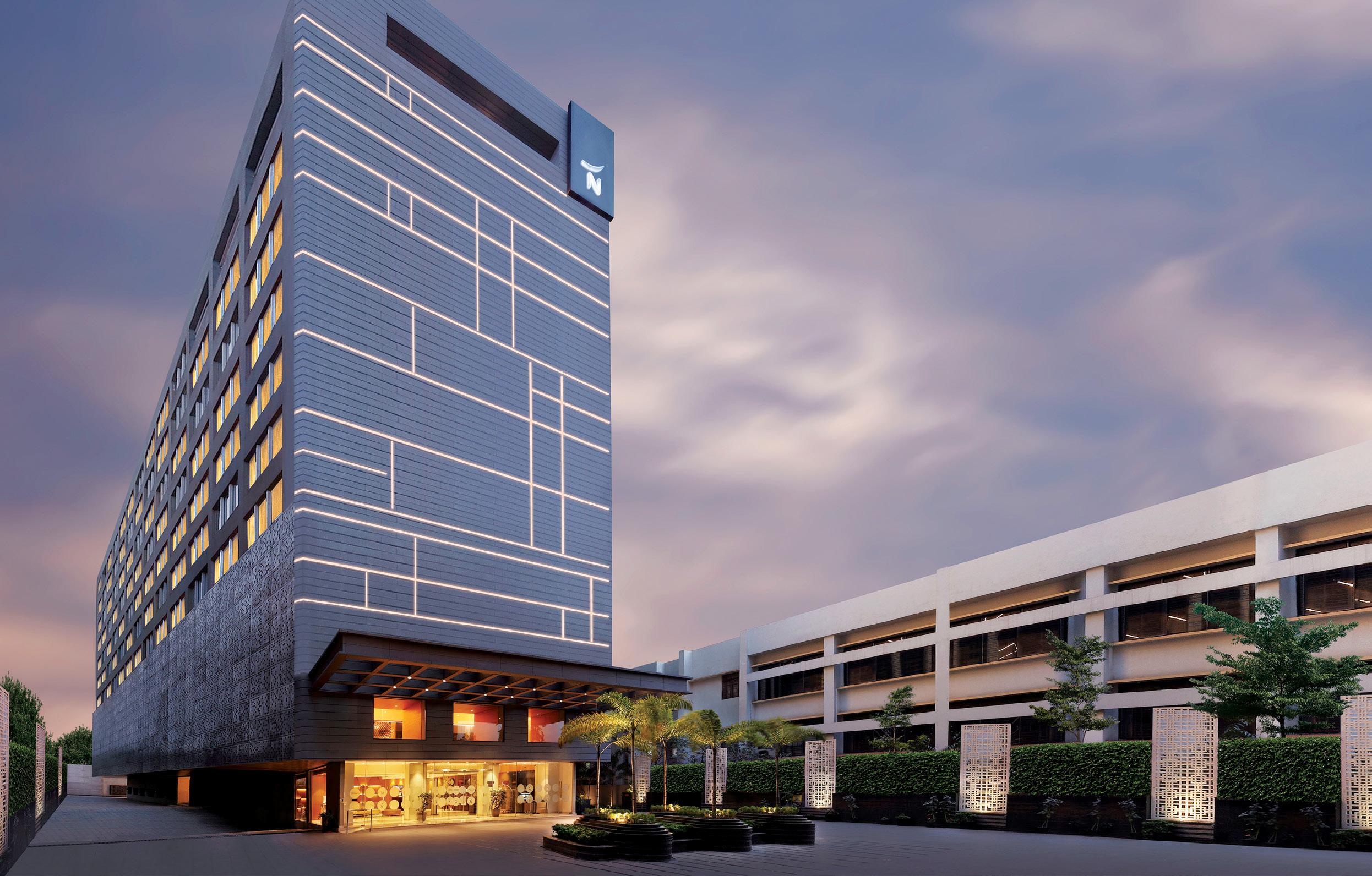
in the same space, where different colour temperatures are used simply because certain options are more readily available,” Mukherji explains. To mitigate this, he prioritises educating hotel ownership, as staff and brands may change over time. “I've found that as the owner becomes more attuned to lighting, subsequent properties are less likely to face these issues,” he adds.
From the fixture point of view, Manshani recommends modular designs that “make it easier to replace or upgrade components without significant downtime. In high-traffic environments, we focus on robust systems with smart controls, allowing operators

LINUS LOPEZ PARTNER, LIRIO LOPEZ
“The best compliment to a lighting designer is when people don’t notice the lighting, only experience a space.”
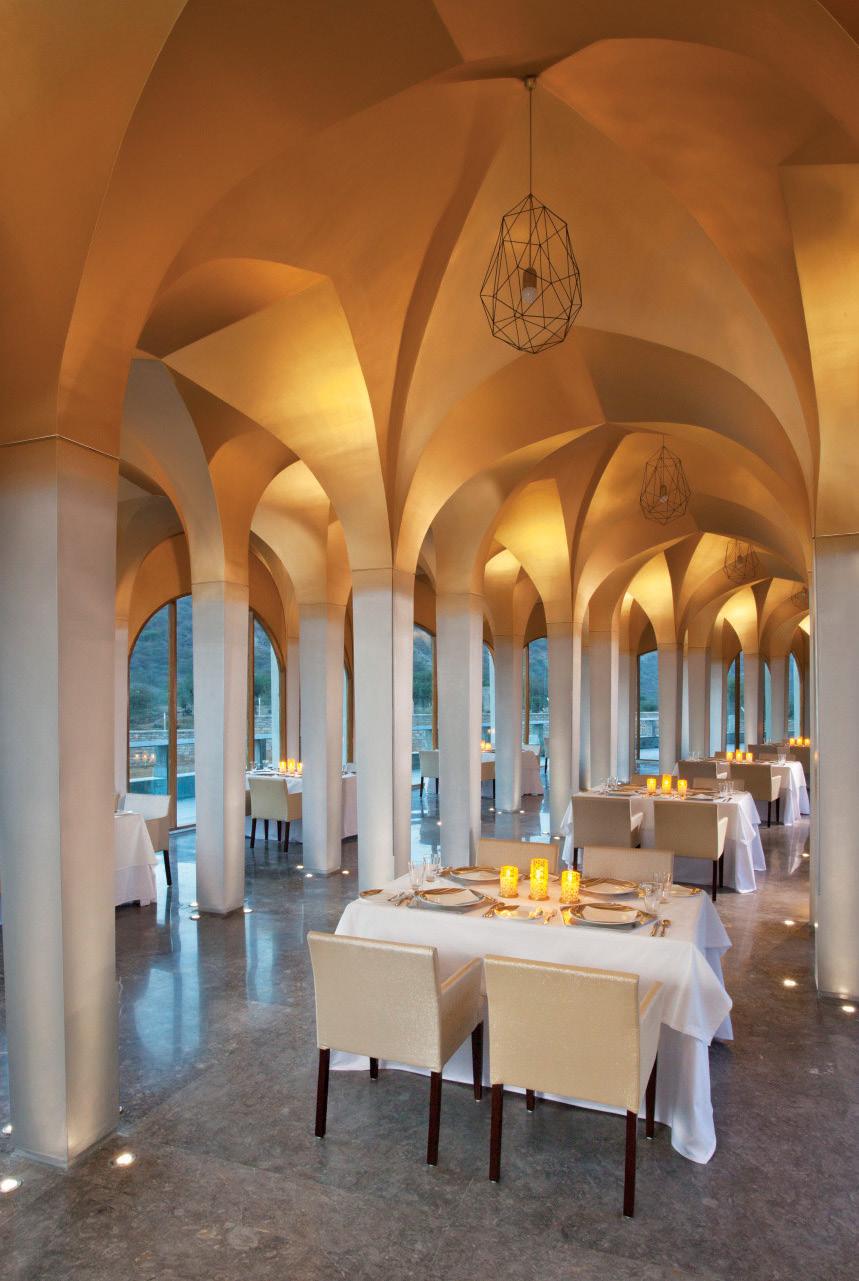
to easily manage and troubleshoot issues remotely, reducing the risk of prolonged outages.”
In the ever-evolving landscape of hospitality design, lighting has transitioned from a functional necessity to a key player in crafting unforgettable guest experiences. As technology continues to evolve and sustainability becomes a critical focus, the role of the lighting designer is more pivotal than ever. By staying ahead of trends, embracing innovation, and tailoring solutions to unique environments, designers have the power to shape not only spaces but the moods and memories of those who inhabit them. The challenges are real, but so are the opportunities to illuminate the future of hospitality with creativity and precision.

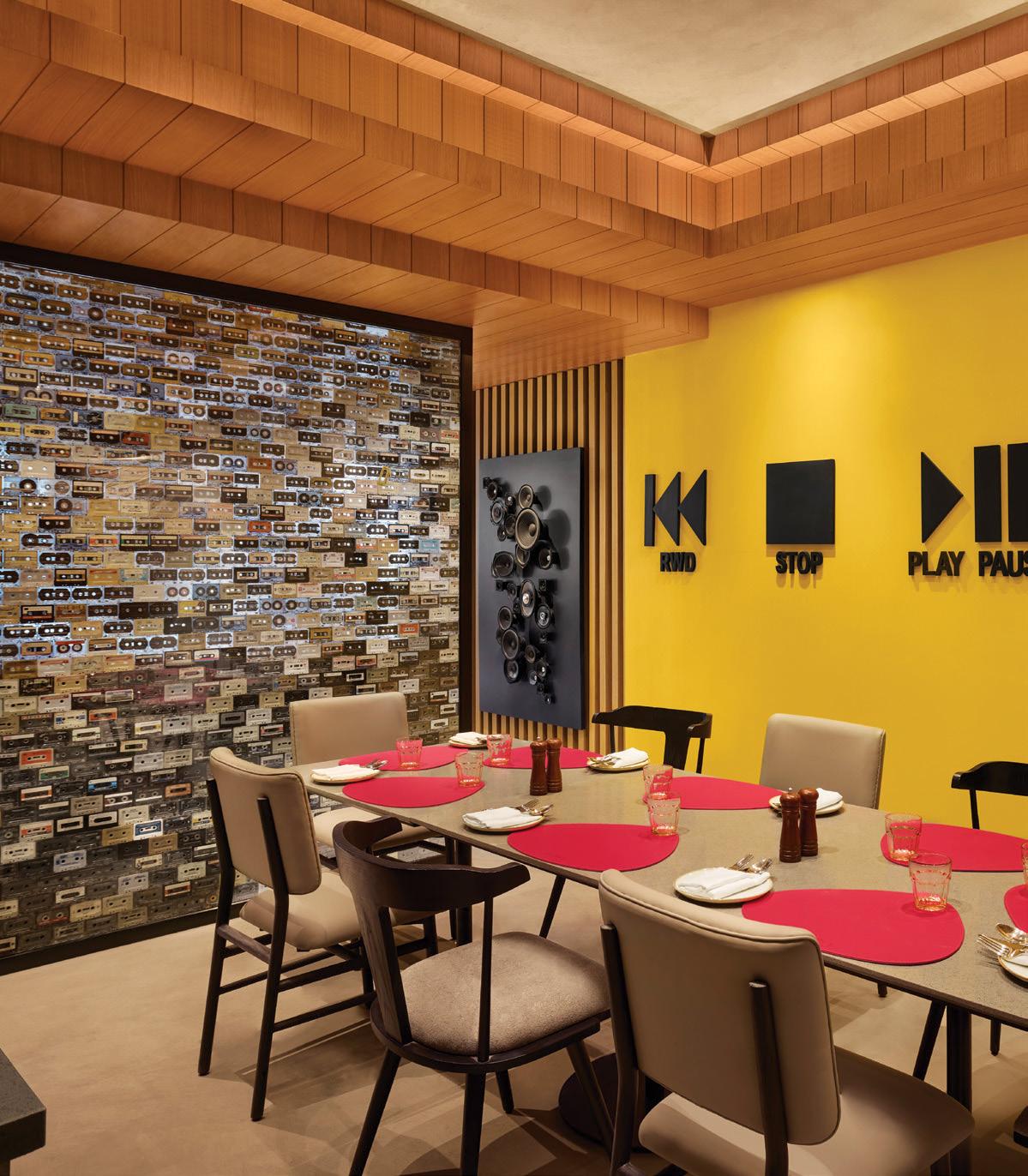




CLOCKWISE FROM TOP LEFT
Note the chandeliers inspired by film reels seen from the library on the mezzanine; The private dining room at Moxy Kitchen; The check-in counter at the bar; The lobby with its community tables and sofa seating.

Discover the fusion of vibrant Bollywood culture and modern hospitality at Moxy Mumbai, where every detail is designed to inspire joy and creativity for guests of all ages. From eclectic decor to innovative communal spaces, this hotel is a testament to playful design and experiential travel.
RUPALI SEBASTIAN
As I settle into the vibrant lobby of Moxy Mumbai, I can’t help but notice a young guest walk in, her eyes widening in delight as she exclaims, “How cool!” It’s a spontaneous reaction to the hotel's whimsical design, encapsulating the spirit of Moxy— an establishment that is not just a place to stay but a playful experience waiting to unfold. While Moxy Hotels are designed with a youthful audience in mind, they embrace all who are young at heart, making it a lively destination for anyone seeking an unconventional hotel experience.
Moxy Mumbai’s lobby invites guests to mingle, work, or simply relax. The playful decor encourages exploration, while the inviting seating—including community tables—fosters interaction among guests.
Sharad Singh, the Captain of Moxy Mumbai, shared insights into how the hotel captures the attention of Gen Z and millennials. “At Moxy, we understand that these generations value authenticity, creativity, and experiences that break the mould,” he explains. This awareness shapes Moxy’s offerings, from engaging social spaces to unique local partnerships that resonate with younger travellers.
Moxy’s brand ethos revolves around celebrating nonconformity and originality. With over 135 properties spanning 25 countries, Moxy has carved out a niche by transforming the conventional hotel experience into a playful adventure. Yet, this exuberance is always rooted in the local context. “Our core values—Thoughtful, Spirited and Fun—are nonnegotiable, but how we express them varies by location. We work closely with local teams to understand their market’s trends and culture, and then we adapt our brand voice to fit that context. This allows us to be consistent in delivering the Moxy spirit while staying relevant to different audiences,” says Singh.
For instance, Moxy’s Indian debut in Bengaluru, located near Kempegowda International Airport, features spaces named ‘Arrival Zone,’ ‘Quiet Zone,’ and ‘Layover,’ reflecting its airport proximity. The Mumbai property, nestled in Andheri West—home to film studios and both aspiring and established actors—takes its inspiration from the glamour and vibrancy of Indian cinema. “Every corner of Moxy Mumbai is a visual treat, inviting guests to explore the magic of cinema and feel a part of the story,” shares Gaurav Premchandani of JOI-Design India which was tasked with scripting a spirited yet evocative narrative for the 105-key property. From the moment you step inside, you're welcomed by a burst of colour and creativity that mirrors Bollywood’s exuberance. Bright bold hues— magenta, electric blue, and sunny yellow, quite in line with the brand’s cheery pink—evoke the flamboyance of Indian cinema.
The experience begins right at check-in at Bar Moxy, where guests are welcomed with a complimentary drink. More than just a check-in point, the lively bar sets the tone for a fun-filled stay. Situated within the multifaceted lobby, its black industrial design and neon signage give it undeniable character. Designed to double as a social hub, Moxy Mumbai’s lobby invites guests to mingle, work, or simply relax. The playful décor encourages exploration, while the inviting seating—including community tables—fosters interaction among guests. Charged with energy, the atmosphere is heightened by vibrant music and the creative cocktails and

The Mumbai property, nestled in Andheri West— home to film studios and actors—takes its inspiration from the glamour and vibrancy of Indian cinema.


small bites served at the bar. The space transforms throughout the day: cafelike and laid-back by day, bustling and vibrant by night. As Singh notes, “We don’t believe in the traditional hotel stay. Every part of the guest journey is designed to surprise and delight.”
Every corner of the lobby tells a story, adorned with quirky Bollywood memorabilia and art pieces. There's graffiti featuring Bollywood icons, the silhouette of a certain ‘king’ in his signature arms-wide stance, and a famous dialogue urging a heroine not to give in to villainous demands. Chandeliers inspired by film reels and many other lighthearted details invite guests to explore and smile at the creative nods to Bollywood culture. “We invite the guests to embrace the spirit of Bollywood in a setting that marries fantasy with comfort,” remarks Premchandani. “Each space is thoughtfully crafted to
immerse visitors in an enchanting and spellbinding experience, one that is a delightful departure from the ordinary.”
On the mezzanine level, guests will find the Library and a Plug-In Area, perfect for those who need a comfortable space to work. The Moxy Kitchen, located upstairs, is the hotel’s all-day dining option, designed to resemble a recording studio. With wall ornamentation


evoking speaker drivers, neon signs spelling "Play On," and a mosaic floor pattern reading "Play It Too Loud," the space has a vibe that's both edgy and nostalgic. A dining nook is cleverly partitioned by a wall of cassette tapes. The menu echoes Mumbai’s iconic street food, featuring playful takes like Passionate Naan, a tandoori naan, topped, among other things, with a sprinkle of channa jor garam; and Bombay Emotions, a nostalgic chai brûlée paired with Parle-G biscuits and a sugar candy cigarettes, inspired by the iconic chai-sutta moment.
Moxy Mumbai’s 105 guest rooms are thoughtfully designed for compact yet stylish living. Corridors leading to the rooms are bathed in blue and accented with quirky art referencing Mumbai institutions like the iconic dabbawallas (tiffin carriers). True to the brand's philosophy, the rooms maximise functionality without compromising comfort. While compact, each room is packed with personality—from signature art pieces
LEFT: The living room of the Producer Room. Note how simple pegs and hangers do away with bulky wardrobes.
RIGHT: One of the meeting rooms on the mezzanine. The aesthetic is industrial chic.
to personalised messages etched on mirrors by a differently-abled team member. Retro rotary phones and cosy lighting create a warm, welcoming vibe. In a nod to smart design, wardrobes have been replaced with wall-mounted pegs for hanging clothes and backpacks, with even the 55-inch televisions suspended on pegs. "We embrace the idea that less can be more," Singh explains, underscoring Moxy’s commitment to balancing efficiency with style.
Finally, Moxy Sky—the hotel’s rooftop bar—offers a stunning infinity pool, artisanal cocktails, and sweeping views of Mumbai’s skyline, making it the perfect spot to unwind as day turns to night.
Another noteworthy aspect of Moxy Hotels is its commitment to sustainability. Moxy Mumbai integrates eco-friendly materials and practices (an in-house bottling plant with soon do away with plastic bottles as well) into its architecture and interiors. With energy-efficient systems and refillable toiletries, the hotel ensures that guests can enjoy their stay while being mindful of their environmental footprint.
In a world where travel is becoming increasingly experiential, Moxy Mumbai stands out as a hotel that redefines what it means to stay away from home. It invites guests to not just check in, but to check out their creativity and immerse themselves in a world where playfulness reigns. As I left the lobby, I could hear laughter and music echoing through the halls, a testament to Moxy’s success in creating a space where everyone—young or young at heart—can revel in the joy of travel and connection.
CLOCKWISE FROM RIGHT:
The delightful Bombay Emotions evokes the iconic chai-sutta moment with a chai brulee, Parle-G biscuit and a cigarette candy.
The Passionate Naan is a tandoori naan offers a choice of Dungari paneer tikka, juicy chicken tikka or smoky Khandeshi mutton sukka, finished with a sprinkle of channa jor garam.
Summer Oasis, a cocktail made with vodka, green apple, cucumber, mint, and lime juice.
The décor of Moxy Kitchen, the hotel's all-day dining, is based on the theme of a sound recording studio.


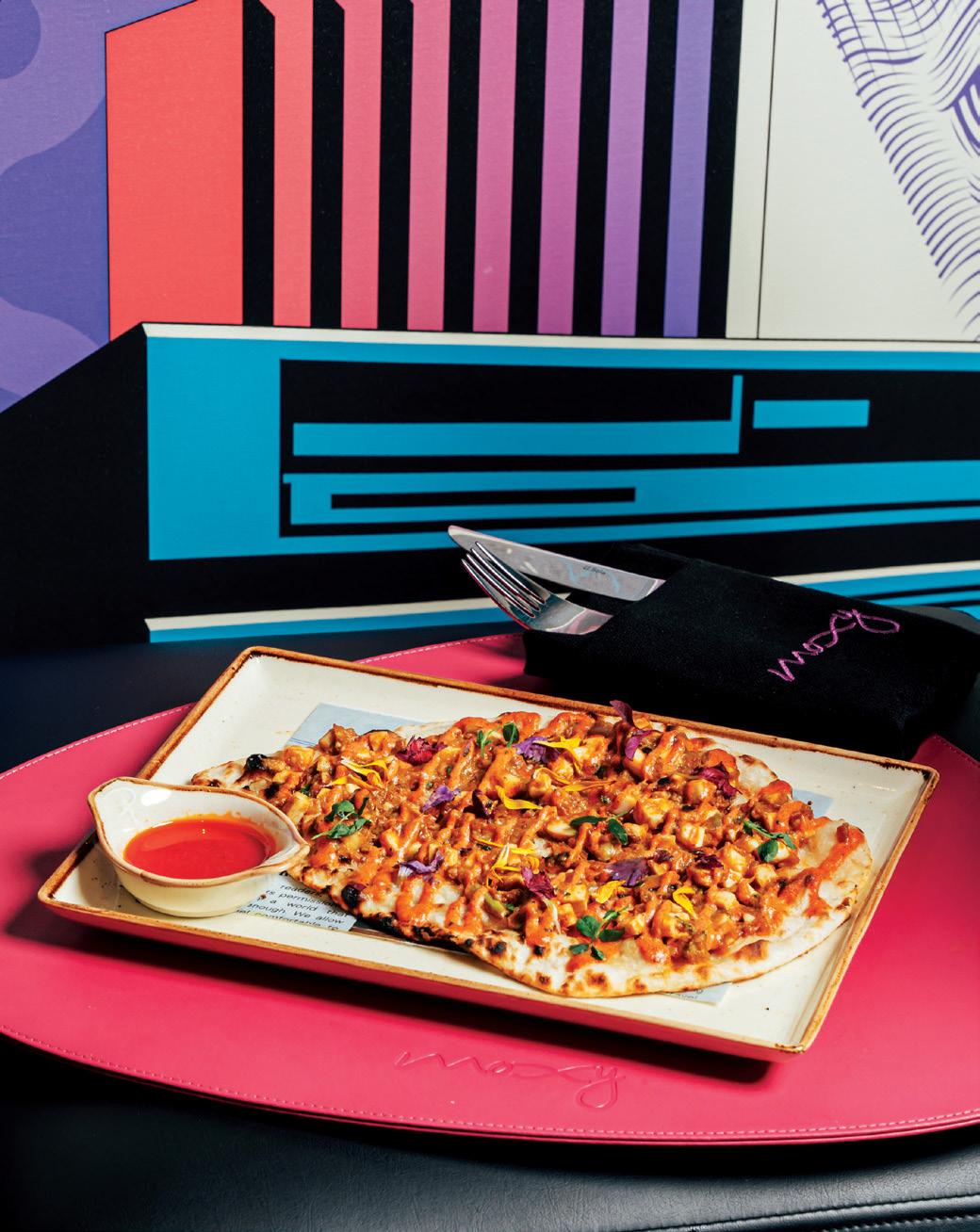

In a city renowned for its film industry and vibrant culture, Moxy Mumbai doesn’t just offer a place to stay; it crafts an experience that stays with you long after you leave. Whether you're sipping cocktails at the bar, mingling in the lobby, or exploring the tonge-in-cheek décor, Moxy Mumbai invites you to embrace the spirit of the city in a setting that beautifully marries quirk with comfort.
The
plays with various patterns and textures to elevate the
To

the


At Fairfield by Marriott Mumbai International Airport, the most captivating sight is of aircrafts taking flight and touching down against the fiery canvas of a Mumbai sunset. Step within and discover a design-driven oasis that reimagines what a mid-market business hotel can be like.
DEEPALI NANDWANI
The view from the 9th-floor Presidential Suite of Fairfield by Marriott International Airport is a spectacle of modern aviation. The runway stretches into the distance, a grey ribbon against the backdrop of the sky, with its markings and lights visible. And the sky is blazing orange fast turning into flaming red as the sun sets. Every few seconds, flights taxi in, slide into their hangar, and another flight takes off.
If your view from a hotel room doesn’t include the sea off the Marine Drive/Bandra/Worli coastline or the vertiginous towers of Lower Parel (if you enjoy the quintessential urban vista), this could be the best view you can ask for. As the night shrouds the city, the darkness is pierced by the taillights of the flights landing and taking off and the dim tarmac lights. Glance a little to the left and you see kids playing football on an elevated pitch, a stark reminder of the lack of open spaces in Mumbai.
The rooftop, a unique feature for a Fairfield property, offers panoramic views of the airport runway. On one end is an infinity pool from where the skyline is a blend of blue on a good weather day, the tarmac lights, flights landing and taxing, and buildings in the distance. General Manager Iftekhar Mehdi tells me the hotel hosts sundowners at the rooftop level “which have been rather popular”.
Ajoy Balkrishna, Vice President, Balwa Group, which owns this premium business property in the heart of suburban Mumbai, says over a languid breakfast in its sun-suffused all-day dining, Mado Mado, “Our guests largely include business travellers, but on weekends, they can also include aviation geeks who check-in for an opportunity to watch
flights landing and taking off, to try and identify the aircraft and photograph them.”
Fairfield by Marriott Mumbai International Airport is not another cookie-cutter hotel. Opened in 2022 after navigating the challenges of the pandemic, this property has quickly become a design exemplar for the Fairfield brand and other business hotels in the mid-market segment. Strategically positioned near Mumbai's bustling international airport, it caters to the modern business traveller with a focus on efficiency and comfort, all while offering a sophisticated and stylish experience.
This success story is a testament to the vision of the hotel's owners, Hussein Balwa, Chairman, and Rafiq Balwa, Executive Director & Vice
BELOW LEFT: The rooftop has an infinity pool from where the skyline is a blend of tarmac lights and buildings in the distance.
BELOW RIGHT: From the light to the art, the lines are sculptural and undulating.

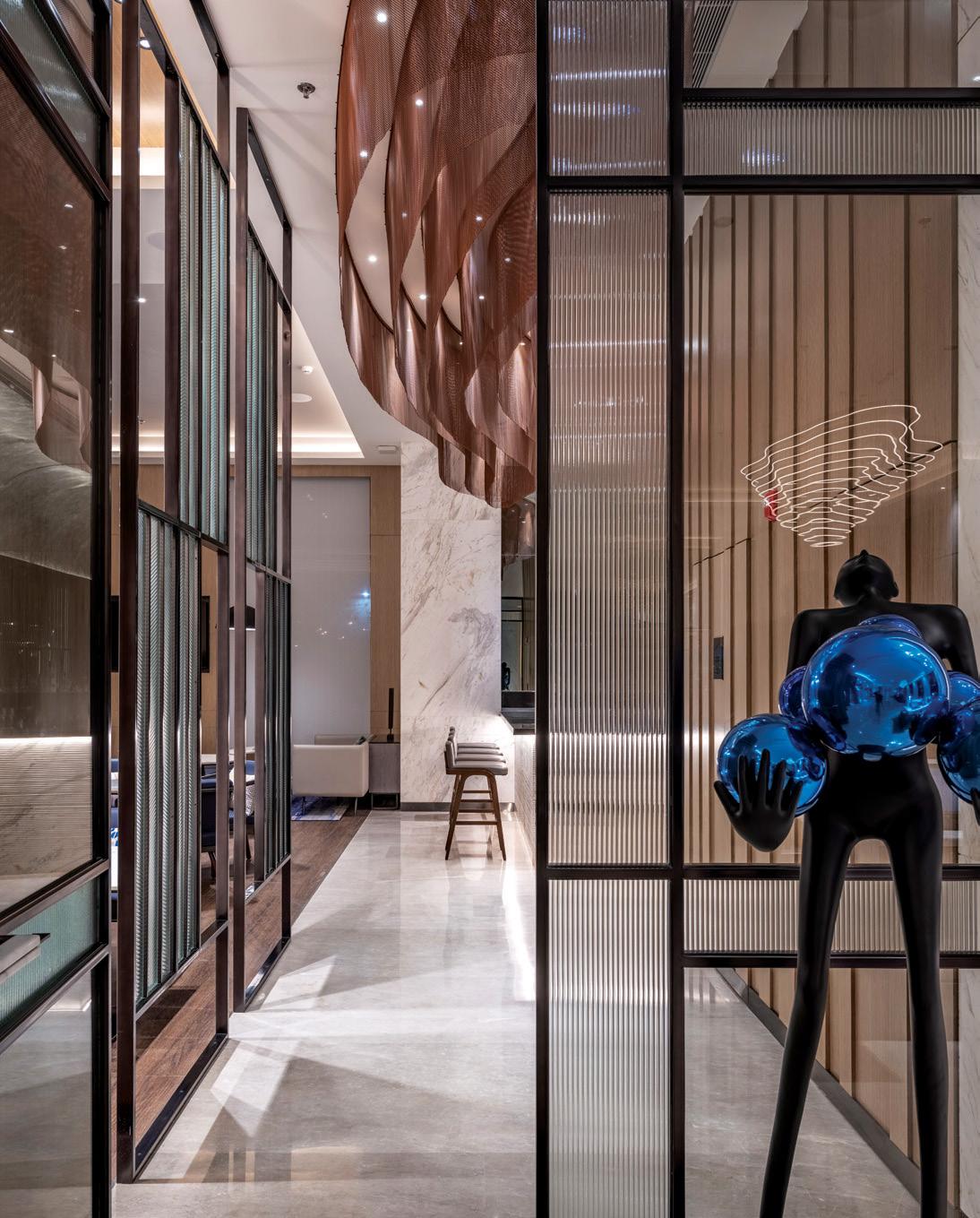

President of the Balwa Group, who sought to create a property that transcended the Fairfield template. They envisioned a hotel with a distinct identity, one that could stand out amongst the growing number of hotels in the area and compete with nearby luxury giants such as the JW Marriott in the neighbourhood. To achieve this, they partnered with Khozema Chitalwala of Designers Group, who brought his expertise to translate this vision into a reality.
Rafiq Balwa contends, “There was no mid-market business hotel near the International Airport and I think we have been able to maximise the revenue potential by maximising the capacity. A 20sq.mtr. room at Fairfield fetches me around ₹8,000 to ₹9,000 per night, whereas a 40 sq.mtr. room at JW Marriott Mumbai Sahar is fetching them around ₹12,000. If I were to take a combination of my two rooms, which amounts to 40 sq.mtr., it fetches me around ₹22,000 per night, whereas JW Marriott earns around ₹12,000 for the same size.”
The design concept, particularly for the public areas, has evolved over many conversations between the Balwas and Chitalwala. “A blend of standardised rooms (except the suites) and customised public areas creates a distinctive experience for guests,” says Balwa.
While adhering to Marriott’s minimalist brand philosophy, Chitalwala weaved in a narrative inspired by the "lifelines of Mumbai"—the iconic elements that keep the city pulsating with life. This is reflected in the artwork, which draws inspiration from Mumbai's Indo-Saracenic and Indo-Gothic architecture, and graphic representations of the now rapidly disappearing black-and-white taxis, the sprawling network of local trains,
The hotel's design philosophy extends beyond the grand gestures to encompass thoughtful details that elevate the overall experience. Intricate jaali screens, referenced from Indo-Gothic architectural style, grace the entrance and are echoed in screens and elevator doors throughout the hotel.
and the famous dabbawalas, who navigate the city's labyrinthine streets to deliver hot lunches. These elements, integral to Mumbai's spirit, are woven into the hotel's design language through subtle yet impactful artistic expressions.
The art program, curated by Manjula Bhattacharya, further
Rafiq
EXECUTIVE DIRECTOR & VICE PRESIDENT OF THE BALWA GROUP
“
Our design has proven so successful that we frequently receive compliments from guests who prefer staying with us over other hotels in the area for the overall flow and guest experience.”
enriches the hotel's connection to Mumbai. Inspired by the city's rich architectural heritage, the artwork adds cultural depth to the hotel's aesthetic.
“Right from the lobby, dining areas, banqueting facilities, terrace pool area, through to the common areas and the rooms, Fairfield by Marriott Mumbai International Airport is a parametrically designed celebration of all that symbolises


the city. The colour palette, the artwork, installations, furniture are all a tribute to the audacious aspirations of the city-dwellers, a documentary of untold stories spanning centuries, and an insight into the coastal tides that have shaped modern-day Mumbai. These highlight an evolved metropolis, from libraries and parks to railway stations and bridges and everything that makes up Mumbai,” says Chitalwala.
The visual disconnect from other Fairfields begins as soon as I walk into Fairfield by Marriott Mumbai International Airport, and encounter the striking design of its public spaces. The lobby is a symphony of colours inspired by the Mumbai skyline, creating a visual connection to the city beyond the hotel walls. The lighting, reminiscent of the undulating sand dunes on Mumbai's beaches, adds a touch of whimsy and organic flow.
Burnished by sunlight, with a view of the few trees in the neighbourhood, Mado Mado, the coffee shop-meets-all-day-dining, is a vibrant space. Its long, flowing layout, bordered by expansive windows, creates a sense of openness, while a dedicated private dining area offers a more intimate setting. “Instead of sizing our coffee shop to the typical 75-80 seats for a 200-room hotel, we opted for a much larger, airier space with 136 seats,” says Balwa. “Flooded with natural light pouring through expansive windows, it's a signature element in my design approach, prioritising a bright, welcoming ambience.”
The art program enriches the hotel's connection to Mumbai and adds cultural depth to the aesthetic.

The hotel's design philosophy extends beyond the grand gestures to encompass thoughtful details that elevate the overall experience. Intricate jaali screens, referenced from the Indo-Gothic architectural style, grace the entrance and are echoed in screens and elevator doors throughout the hotel. These partitions add visual interest and subtly delineate spaces within the open plan.
“The parametric pattern resonated with the overall design language. We featured it prominently on screens in the lift lobby and pre-function areas. These screens serve as visual dividers and artistic elements, seamlessly blending with the minimalist aesthetic,” says Chitalwala.
There is a bar on the ground level, located there for easy access, so that “people could walk in, have a drink or two, and walk out easily,” reflects the designer. “Originally conceived as a boutique hotel, the building was adapted to accommodate a Marriott property. The focus on natural light, especially in the dining and coffee areas, enhances the overall experience.”
ARCHITECT/INTERIOR DESIGNER KHOZEMA
CHITALWALA, PRINCIPAL ARCHITECT, DESIGNERS GROUP
LIGHTING CONSULTANT SAI TUNGSTEN
LIGHT STUDIO
LIGHTING SPECTRUM LIGHTING
While the hotel adheres to Fairfield's standard room sizes, it offers a range of accommodations that cater to diverse needs. The Executive Suites, located on the 3rd to 7th floors, provide a more spacious option for those seeking extra comfort. And in a truly unexpected move for a Fairfield, the hotel boasts two Presidential Suites on the 9th and 10th floors, offering a luxurious experience. While one has a long dining table for those who check in with a large family and friends, the other features a bathtub.
Adds Chitalwala, “Despite the inherent limitations of the Fairfield brand and small room sizes, the owners were determined to offer a premium experience. Capitalising on the building's height restrictions near the airport, we transformed a top-floor corner, originally intended for a gym, into a luxurious suite boasting stunning airport views.” Plans had to be reworked more than once, however. “Just before finalising the design, Rafiq and I recognised a critical flaw in the room layout: the bed orientation. To optimise the space, we made a decisive change, rotating the bed and reworking the entire layout. This required significant revisions to the drawings, but ultimately resulted in a more functional and aesthetically pleasing room,” says Chitalwala.
SANITARYWARE TOTO
CP FITTING TOTO
FURNITURE RAGHBIR INTERIORS
FLOORING/FAÇADE
GLASS/PAINT/MARBLE/ STONE/ARTEFACTS
CLIENT BOUGHT
WALL COVERING PHOENIX
DOOR AND PARTITION
RAGHBIR INTERIORS
“The colour palette, the artwork, installations, furniture are all a tribute to the audacious aspirations of Mumbaikars, a documentary of untold stories spanning centuries, and an insight into the coastal tides that have shaped modern-day Mumbai.”

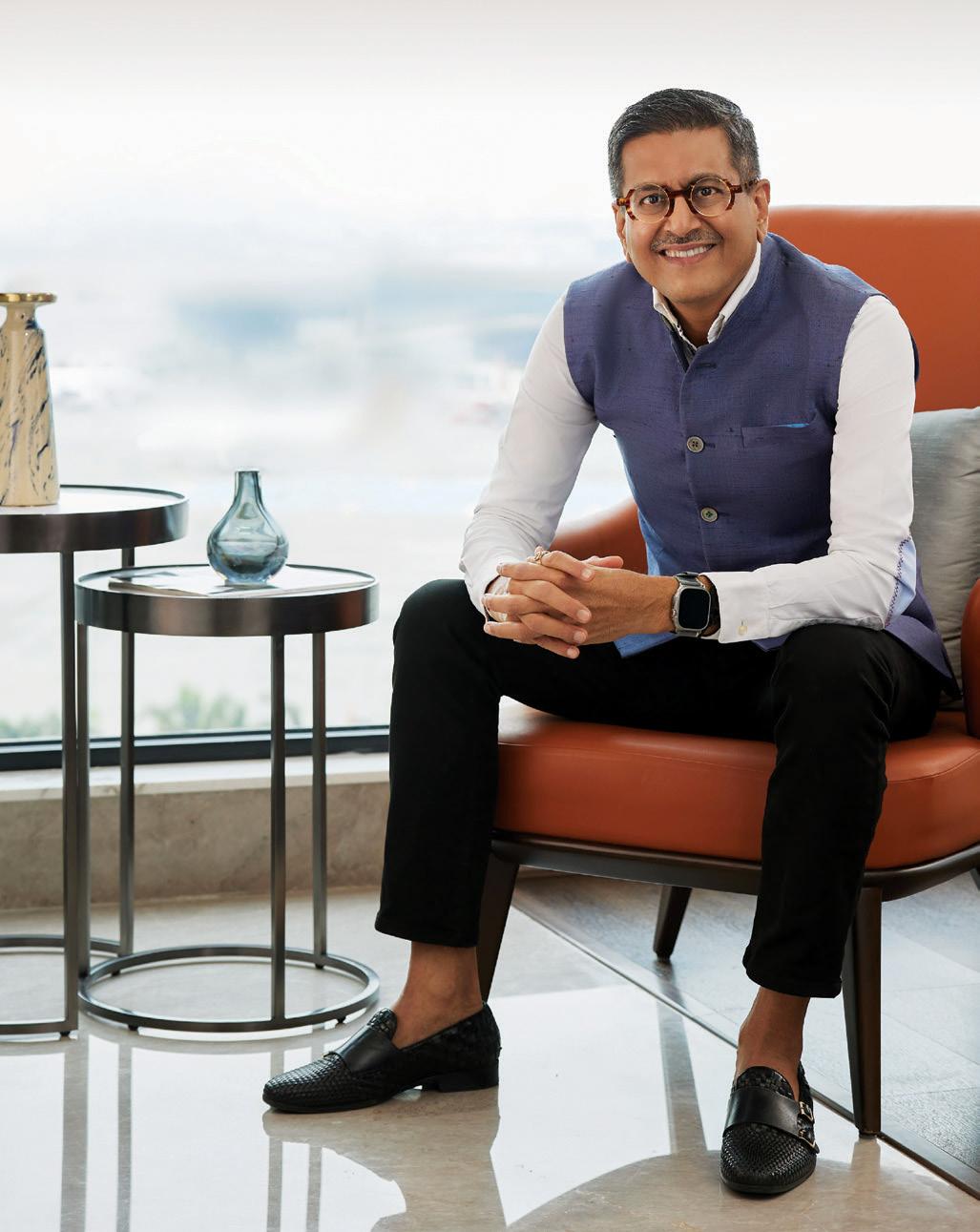
Sure, Fairfield by Marriott Mumbai International Airport's success can be attributed to its design, but the hotel's strategic location near the airport and its focus on catering to the needs of short-stay business travellers have also played a crucial role. It is one of the few Fairfields that welcome Marriott Bonvoy Platinum members, despite there being a JW Marriott close by, a luxury hotel from the same group.
Balwa explains that the decision to partner with Marriott was driven by the brand's strong distribution network and efficient onboarding process. The hotel's design, which emphasises functionality and streamlined flow, complements this business strategy. The hotel's smaller room sizes, while initially a concern, have proven to be a strategic advantage. By maximising room capacity, the hotel can offer

competitive rates while still maintaining profitability. This approach has resonated with budget-conscious business travellers, who appreciate the value and convenience offered by the Fairfield brand.
“Catering to the short-stay business traveller—with an average stay of just over a day—we prioritised efficiency and comfort. Knowing most guests arrive late after meetings and depart early following breakfast, we focused on maximising their brief experience by providing a seamless stay,” adds Balkrishna.
While Fairfield by Marriott Mumbai International Airport primarily caters to business travellers, it has become a popular destination for staycations and events. The hotel's spacious garden area of 16,000sq. ft, capable of accommodating up to 1,000 people, has hosted several weddings and social gatherings. “It is a key revenue driver, particularly for weddings, a significant market in Mumbai,” says Mehdi. “Five weddings last season generated between ₹20-25 lakhs each. We've secured two weddings this year and six for 2025, demonstrating the hotel’s popularity and strong revenue potential.”
The hotel's versatile 1,200-square-foot banquet hall, equipped with soundproofing and an LED wall, can be partitioned into smaller sections for more intimate events. And for those seeking a more exclusive experience, the private dining room offers a customisable setting for special occasions.” Our strategic location near the airport and Andheri-Kurla Road's commercial hub, with its concentration of major corporations and pharmaceutical companies, fuels a robust MICE market. This, coupled with strong Marriott support, particularly from the Asia Pacific region—which boasts one of our highest concentrations of Marriott Bonvoy elite members—ensures consistent business traffic,” he adds.
The hotel's smaller room sizes, while initially a concern, have proven to be a strategic advantage.
By maximising room capacity, the hotel can offer competitive rates while still maintaining profitability.
A prototype for the future
Marriott, initially hesitant about the hotel's departure from its brand guidelines, has now embraced this property as a prototype for future Fairfields. Balwa contemplates, “Our design has proven so successful that we frequently receive compliments from guests who prefer staying with us over other hotels in the area. Even the Emirates team from Singapore chooses our property over JW Marriott, not just for the room size, but for the overall flow and guest experience, from checkin to breakfast.”
This minimalist, functional hotel, conveniently located near the airport, was designed with longevity in mind. The use of light and grey tones creates a timeless aesthetic, ensuring a fresh feel for years to come. “We're confident this modern design will remain relevant for at least 20-25 years,” he adds.
In today’s competitive hospitality landscape, the smallest design oversight can leave a lasting impression on guests. From impractical tea stations to tricky lighting controls, these common hotel room mistakes might be costing you repeat business.
RUPALI SEBASTIAN
When it comes to ensuring a guest's comfort, the devil is in the details. While many hotels pride themselves on five-star amenities and sleek designs, it’s the little overlooked aspects of room functionality that often stand out to guests, and can lead to great frustration. Here are five common design mistakes hotels make, and why they can significantly impact the guest experience:

One of the most frustrating little annoyances for hotel guests is when they want a quick cup of tea or coffee and can’t locate the kettle. Often stashed away in a drawer or a cabinet, the kettle becomes something guests have to hunt for. Not only does this inconvenience guests, but it also diminishes the room's sense of welcome. A simple fix? The kettle should be placed atop the tea or coffee station, in plain sight. This way, guests feel invited to make use of the amenities, without having to play hide-and-seek first.
Bathroom privacy is a must, yet many modern designs opt for aesthetic over practicality. Fluted or frosted glass doors for WC stalls may look chic, but they offer an awkward experience for guests, especially when you can still make out the person inside. No one wants to be seen—however vaguely—during such private moments. A solid door or a better privacy solution will ensure guests don’t have to feel uncomfortable using their own bathroom.

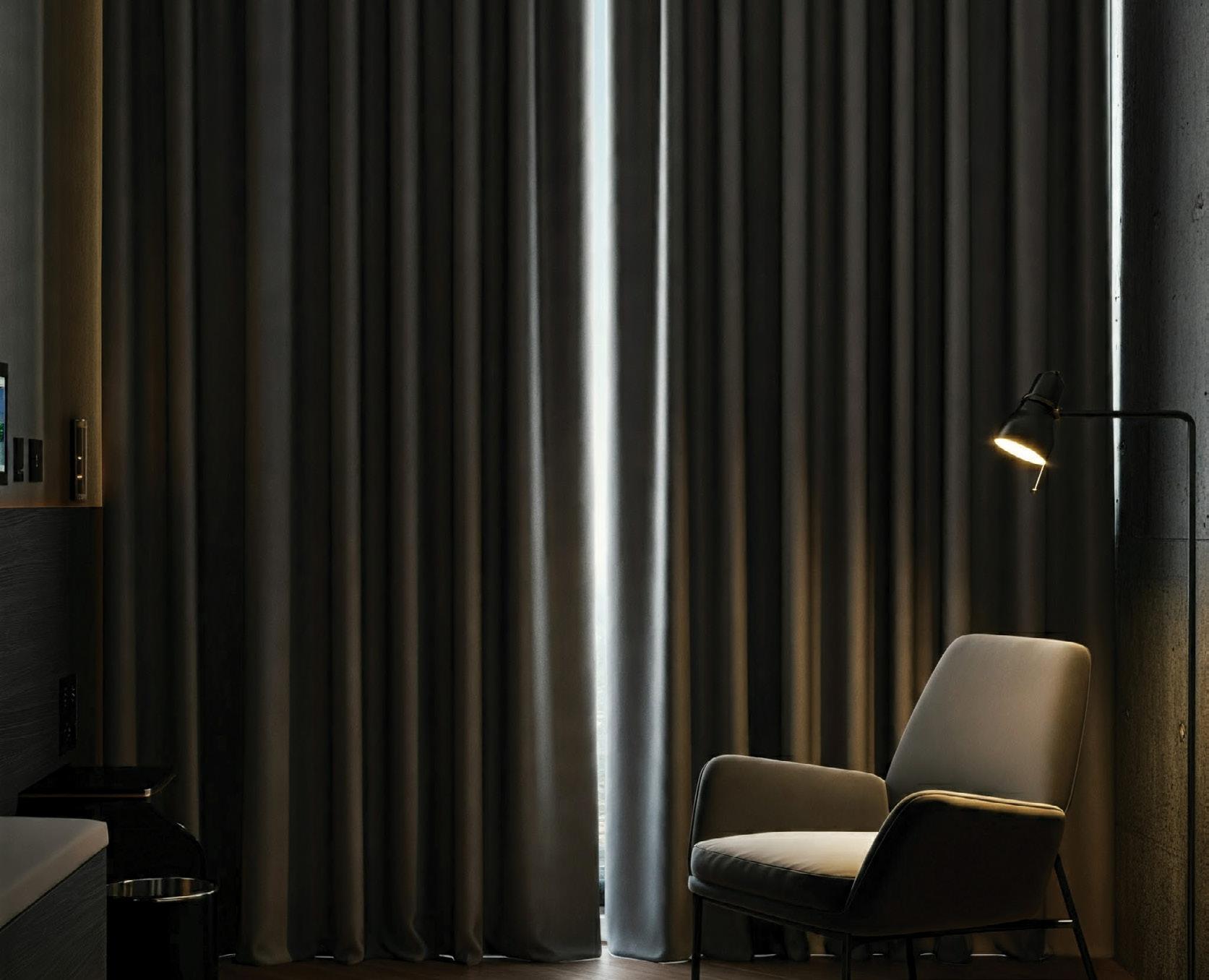
Light control is one of the most important factors in ensuring a restful stay, yet it’s surprising how often hotels fall short in this department. Ill-fitted curtains, particularly blackout curtains, are a frequent culprit. A gap in the curtains—whether at the bottom, sides, or top—lets in light, disturbing guests’ sleep. Whether it's the early morning sun or ambient city lights at night, this intrusion can be a deal-breaker for a peaceful stay. Hotels should invest in properly sized and layered curtains to ensure complete darkness when needed.


While hotel aesthetics get plenty of attention, the acoustics of a room are often neglected. Thin walls, doors near service areas, or poorly soundproofed windows can lead to a disrupted stay. Guests in rooms near service doors or elevators often report being disturbed by constant noise, such as doors banging or the sound of people walking past. A well-designed hotel room should minimise noise, ensuring that external sounds do not disturb the guest's relaxation. Adequate insulation, soundproofing, and better placement of service areas can significantly improve the guest experience.
With modern technology, hotels aim to offer the latest in convenience—but sometimes, this backfires. Complicated lighting systems or temperature controls can leave guests frustrated. They may spend more time figuring out how to dim the lights or adjust the AC than enjoying the room. The key is to keep technology intuitive and user-friendly. Simple labels or an easy-to-use interface can go a long way in ensuring guests don’t feel overwhelmed by the room’s gadgets.


Paying attention to small but significant details can elevate a guest's experience and encourage repeat stays. By focusing on practical, functional design choices, hotels can avoid common pitfalls and ensure their guests feel truly at ease. After all, it's the thoughtful touches that make all the difference.


The HFTP India CIO Summit brings together technology leaders, industry experts, and innovators to discuss the latest trends, challenges, and opportunities in hospitality technology.
14-16 October 2024 at Taj Cidade de Goa
SOH lists out unique products and services that add value to the hospitality industry and redefine the guest experience.

Zwiesel Glas Fusion: artisanal luxury for every occasion.
Cocoon Pret, Cocoon Fine Rugs' luxury collection, brings sophisticated elegance and exceptional craftsmanship within reach, at a moderate price point. This vibrant collection caters to young, dynamic homeowners who express themselves through their living spaces, blending geometric, classical, and modern influences. With an eclectic mix of asymmetrical shapes, varied materials, and textures that invite touch, Cocoon Pret offers a perfect rug for every style. Plus, customisation options enable personalised colours and designs, ensuring a seamless fit for any interior.
X-factor: Affordable chic.
Available in: Ready-to-pick and customisable options.
Website: www.cocooncarpets.com
Contact: +919326213461 (Mumbai); +919321709190 (Delhi)



Elevate your guest experience with Coffeeza Finero Next, a compact, powerful espresso machine delivering barista-level coffee. Despite its slim, space-saving design, this innovative machine is equipped with an impressive 20-bar pressure system, ensuring every brew is full-bodied, aromatic, and rich in flavour. Perfect for hotel rooms, Finero Next offers a seamless experience with easy usage and customisable premium Indian coffee capsules. Minimal maintenance and a space-saving design make it ideal. Offering freshly brewed, café-quality coffee in-room will foster a pleasant guest experience.
X-factor: Barista-level coffee in the comfort of your room.
Website: www.coffeeza.in
Contact: +918180033312
Portside Cafe’s new collection, Curation, brings together compelling pieces from their past offerings spanning 12 years. One of these, the striking and timeless Aisle Chair, evokes the architectural genius of Tadao Ando, particularly his Church of Light. The chair combines neoclassical design with bold elements. The subtle ‘slit’ at the back, a hallmark of Ando’s brilliance, introduces a minimalist yet profound touch to the design. Crafted from rich wood and premium leather, the Aisle Chair harmoniously balances art and comfort, making it a statement piece for any space.
X-factor: Function meets architectural artistry.
Website: www.portsidecafe.com
Contact: 011 46054371


Hästens' Maranga Bed is the epitome of luxurious sleep, meticulously handcrafted from 27 layers of the finest natural materials, including horsehair, cotton, wool, and flax. Each layer is carefully placed to provide optimal support, relieving pressure points and creating a feeling of weightlessness. The bed is side-stitched by hand, a hallmark of Hästens' 170-year legacy of craftsmanship, ensuring durability and timeless design. Its breathable natural materials regulate body temperature, making it perfect for any climate. Available in India, the Maranga Bed combines style, sustainability, and unparalleled comfort for a superior sleep experience
X-factor: Expert craftsmanship meets nature's sleep harmony.
Available in: 180 cm x 200 cm and 200 cm x 200 cm
Website: www.hastens.com
Contact: +9109268572224
Transform your bathroom with the sleek, tankless Automate Imperial, a cutting-edge smart toilet from Hindware’s Italian Collection. Featuring advanced technology like a presence-sensing lid, pre- and postflush functions, oscillating water spray, and a handsfree foot-touch flush, it delivers superior hygiene and comfort. Customisable settings include heated seats, adjustable water pressure, and temperature control, all managed via an LCD display. The self-cleaning system and warm air dryer add a luxurious touch, ensuring a seamless, hygienic, and personalised bathroom experience. Tagged at a starting price of ₹79,990.
X-factor: Luxurious bathroom experience through smart innovation.
Website: www.hindware.com
Contact: +919820544092 (Mumbai)

NOSE: Sweet earthy aroma with dried hay, fresh green figs, dried apricots, raisins, prunes, black pepper, and a hint of dried ginger, finishing with a whisper of umami mushrooms.
AROMA: Petrichor, wet grass, and musk.

PALATE: An intensely sweet beginning meets light savoury notes, salinity, dried fruits, and grassy flavours, ending with a peppery tingle.
South Seas Distilleries, India's oldest and largest Mahura distiller, introduces Six Brothers, the nation's first luxury Mahura spirit. Born from the fragrant Mahura flower and a century of distilling expertise, Six Brothers debuts with two exceptional expressions. 1922 Resurrection marks a historic moment: crafted from the world's oldest matured Mahura. Aged in oak casks, its limited-edition release of only 102 bottles is priced at ₹1,02,000 each (750ml, 40% ABV). The Six Brothers Small Batch offers a contemporary expression of this heritage spirit. Double-distilled in copper pot stills and refined through platinum filtration, it is priced at ₹2,492 (750ml, 40% ABV), and delivers a crisp, balanced palate.
Key highlight: Both spirits are presented in exquisitely designed bottles that capture the essence of the brand's heritage. Six pairs of eyes adorn the base, symbolising the revival of the Mahura spirit. In contrast, the all-seeing eye on the stopper embodies the Six Brothers' shared vision of elevating this Indian spirit to global acclaim. The tiger motif and claw marks on a ribbed glass bottle pay homage to the resilience of the Mahura flower and its native forests.
Deep in the Kumaon Valley, close to Jim Corbett National Park, lies Himmaleh Spirits, India's first distillery dedicated to artisanal spirits. Its inaugural offering, Kumaon & I, is a 100% Himalayan dry gin that embodies the unique terroir and rich flavours of Uttarakhand's Kumaon region. Founded by Ansh Khanna and Samarth Prasad, Himmaleh Spirits champions a hyperlocal, farm-to-bottle ethos. "We were inspired by India's incredible natural resources," says Khanna. "Kumaon & I showcases 11 unique Himalayan botanicals, including Timur (a berry-like Szechuan pepper), black turmeric, and local citrus fruits like Galgal.”
This commitment to the region extends beyond ingredients. "We collaborate with Kumaon's local community of harvesters, foragers, and distillers," adds Prasad, a Kumaon native with deep family ties to the region's hospitality industry. "Kumaon & I celebrates the traditions and culture of the Kumaoni people, reflected in the gin and the bottle design."
Key highlight: The logo and bottle design is inspired by Aipan, a traditional Kumaoni art form made using red ochre mud and white rice paste. The black circles symbolise the circularity of sustainable farming, while the lines represent the distillery's commitment to the traceability of its ingredients.
NOSE: An aromatic blend of Timur pepper and native Himalayan citrus fruits like Galgal and Kinu.
AROMA: Timur pepper has a distinctive peppery aroma with grapefruit-like nuances. Galgal and Kinu introduce a zesty dimension to the aroma.
PALATE: A textured mouthfeel, with earthy flavours of black turmeric and warmth of coriander seeds.


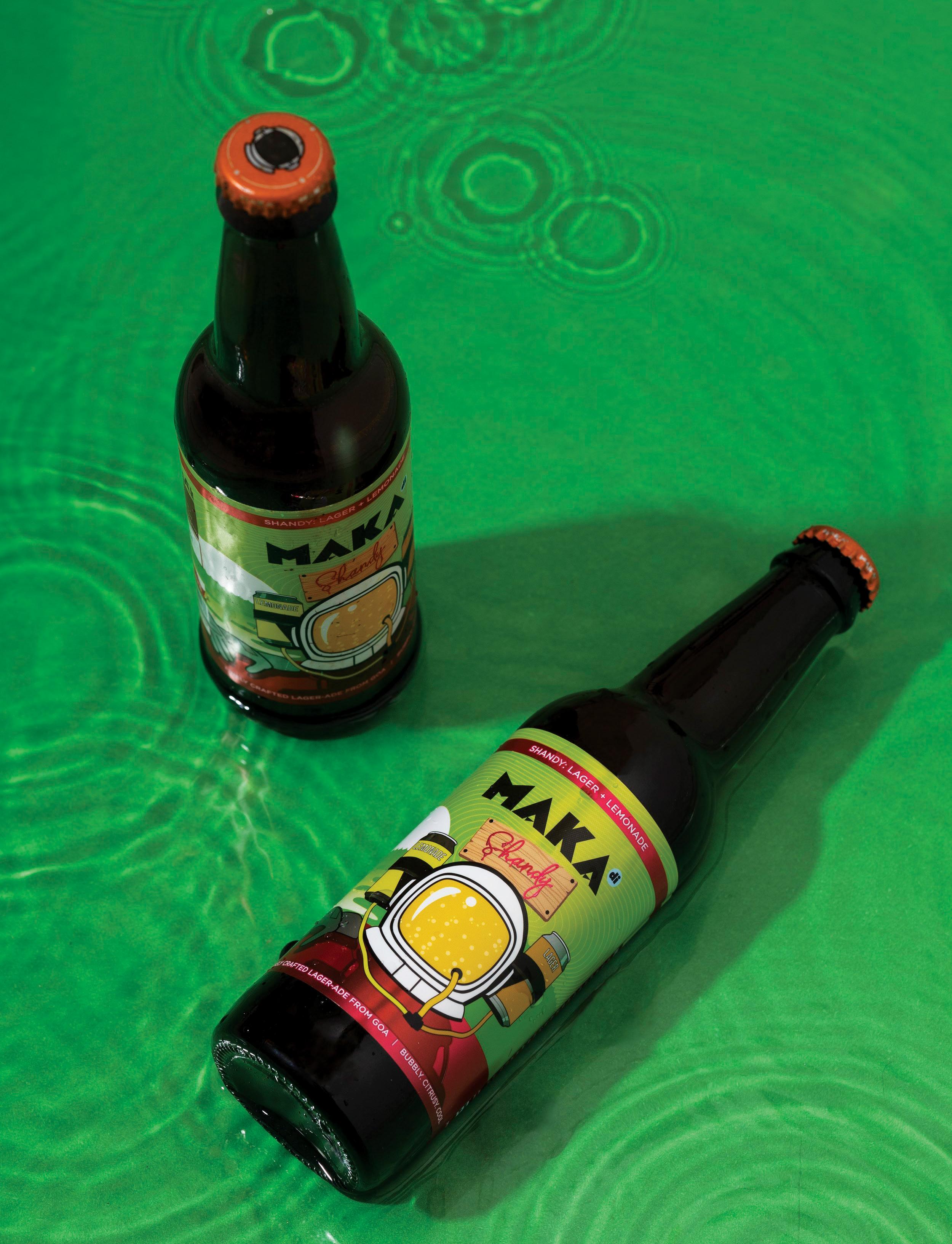
MAKA DI: INNOVATING CRAFT BEER IN A BOTTLE
The world of craft beer is as diverse as global tastes in cuisine, music, and architecture. Today's beer enthusiasts are eager to explore these diverse flavours, and Goan brand Maka di has launched them on “an intergalactic adventure”—the brand’s mascot is an ‘interstellar traveller’.
Maka di, meaning ‘give me’ in Konkani, is the brainchild of Latambarcem Brewers, a company producing craft beers that rival the famed brews of Europe. The brand captures the spirit of a new generation of beer lovers seeking exceptional taste, creativity and sustainability. It has launched three distinct craft beers in bottles, the first for India:
Maka Di Tripel Ale (7-8% ABV)
A Belgian-style ale with Czech hops and premium European malt, crafted in partnership with Lupulus Brasserie in Belgium, for a unique bespoke experience.
Maka Di Honey Ale (7-8% ABV)
An amber ale infused with wild honey from Jim Corbett National Park, offering a taste of the forest with a refreshing sweetness.
Maka Di Belgian Blanche (4-5% ABV)
A wheat beer spiced with coriander, cumin, and Sicilian lemon peel for a cool, zesty, laid-back drinking experience.
D’YAVOL INCEPTION: FINISHED IN TAWNY PORT CASKS
Shahrukh and Aryan Khan’s D'YAVOL INCEPTION is a rare breed. This 100% pure malt Scotch whisky, a symphony of eight single malts from across Scotland, is finished in a way few others are: it spends years maturing in first-fill Tawny Port and exceptionally rare Madeira casks. These casks, often 15 times the price of standard ex-bourbon barrels, impart unparalleled depth and complexity. The result?
A whisky with a captivating sherried sweetness interwoven with gentle Islay peat, a truly exceptional dram for discerning palates.
Key highlights: It is crafted by renowned Master Blender Vic Cameron from a meticulous selection of eight distinct single malt whiskies sourced from the renowned whisky regions of Scotland: Speyside, Highlands, Lowlands, and Islay. This creates a complex and layered flavour profile that showcases the diversity of Scotch whisky.

NOSE: Ripe pears with succulent cherries, complemented with creamy toffee against a smoke and raisin sweetness.
AROMA: The sweetness of dried fruits mingles with warm spices. There is a gentle wisp of peat smoke.
PALATE: Blend of fruity sweetness and gentle smoke evolving into sticky toffee pudding.


PRODUCT OF THE MONTH
Zwiesel Glas' Fusion series combines artisanal mastery and machine precision. Handcrafted, wafer-thin stems meet advanced, machine-made domes for unparalleled stability. Designed for discerning palates, beverage-specific shapes ensure sensory enjoyment. Balancing lightness and strength, Fusion blends luxury and functionality. With 150+ years of expertise, Zwiesel Glas sets the bar high. Perfect for intimate dinners or grand celebrations, Fusion offers the ultimate synergy of aesthetics and practicality, ensuring the right glass for every occasion.
X-factor: A balance of beauty and strength. Available in: Five sizes, catering to a wide range of grape varieties.
Website: www.zwiesel-glas.com
Contact: Pesi Engineer +919820050048
Five hotel beverage managers explore the rise of local ingredients, sustainable practices, and innovative techniques driving the evolution of cocktail programmes.
RUPALI SEBASTIAN
The art of cocktail making is in full evolution, blending tradition with bold innovation. In this lively chat with SOH, beverage managers from five standout hotels shake things up by sharing how sustainability and local ingredients are the secret ingredients behind their cocktails that do more than refresh—they tell a tale. From revamping the classics to crafting daring new concoctions, these experts spill the tea on the growing impact of social media, their strategies for staying ahead of the curve, and how they’re gearing up to raise the bar this festive season with irresistible new line-ups.
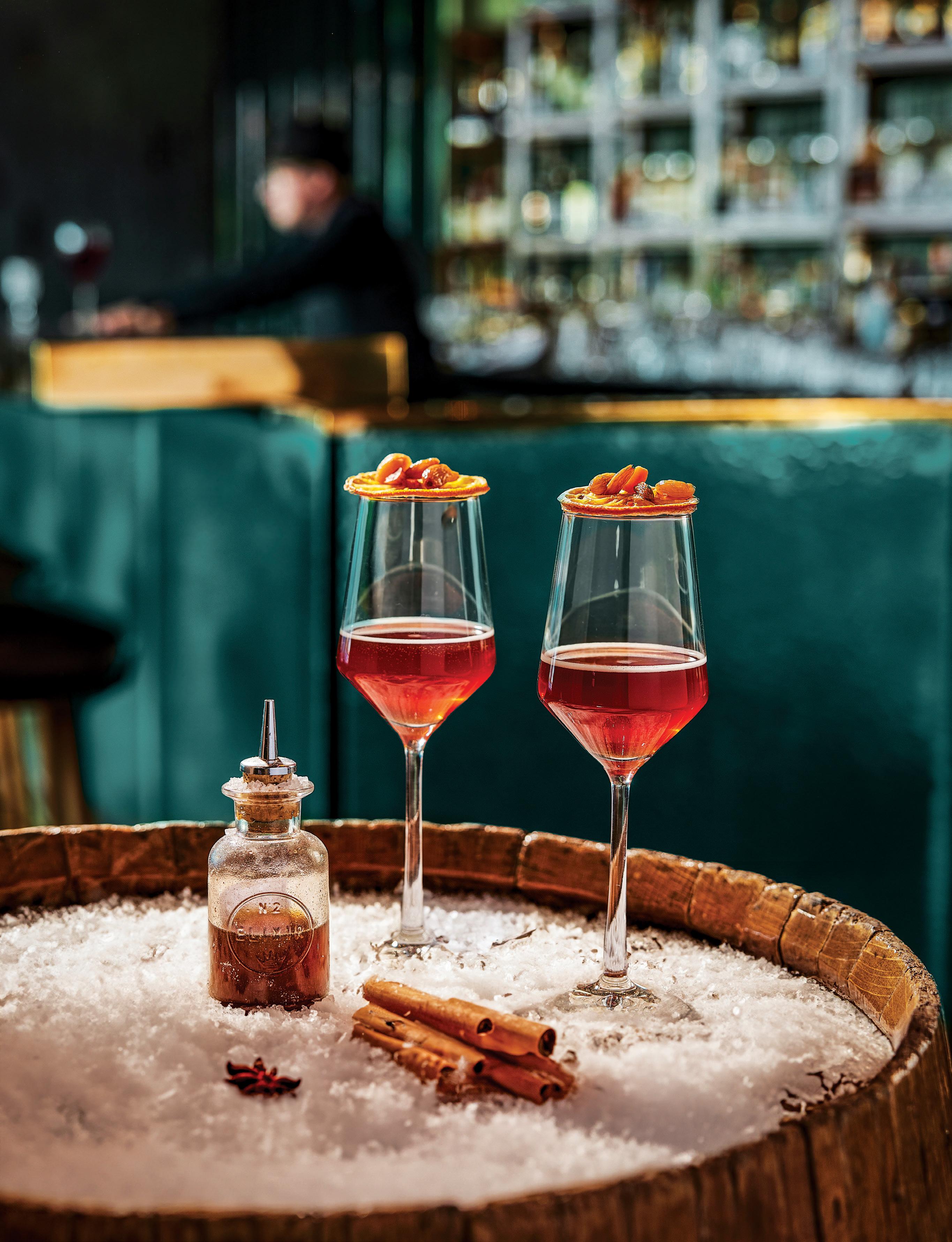
Rakesh Shetty
Director of Restaurants & Bars, Four Seasons Hotel Bengaluru at Embassy One






Can you describe your bar offerings in a few words?
Rakesh Shetty: Our bar program is uniquely designed around the concept of the Four Seasons tree, where we explore different parts of the tree in our menu. Currently, we’re diving into the ‘leaf’ segment in our signature Folium: Chapter 01 Menu, featuring cocktails crafted from locally sourced, hyperlocal leaves. This allows us to showcase a wide array of flavours and offer guests a truly unique experience. We stock a comprehensive selection of premium spirits including gin, vodka, rum, and tequila. Our highlight offerings include some of the finest spirits like Louis XIII and Yamazaki 18, both exclusive and rare. Additionally, we stock the exquisite Tears of Llorona tequila, which adds a luxurious touch to our offerings.
Yogesh Sonawane: At Sofitel Mumbai BKC, our bar offerings are crafted to surprise and delight. At one of our speciality restaurants Jyran, we showcase an extensive collection of gin labels from around the globe, infusing a dash of Mumbai’s vibrant soul into our drinks. We’ve crafted unique, bold infusions with Indian spices like black pepper and cardamom, lending an exotic twist to our signature Gin & Tonics. It’s an adventure for the senses, with each cocktail telling its own story to elevate the classic into something new, fresh, and unforgettable.
Srishti Sethia: At Taj Palace, New Delhi, each bar tells a unique story, contributing to an exceptional beverage experience across our outlets. With over 60 varieties of whisky and an extensive collection of 80 wines, we cater to a wide range of preferences, offering everything from time-honoured classics to innovative spirits.



Each restaurant at the Taj Palace features its own distinct bar that reflects its culinary philosophy. Capital Kitchen offers fun, fruit-forward cocktails designed for easy drinking and relaxed settings. Orient Express boasts timeless cocktails that have preserved their old-world charm while being enhanced by modern mixology techniques. Loya is dedicated to sustainability with its 'Paanch' philosophy, where spices, herbs, and indigenous botanicals from the heart of the northern India are woven into the cocktail experience. Spicy Duck pairs cocktails with nuanced flavours from China, creating lighter, more delicate drinks. Blue Bar has a vibrant and dynamic cocktail selection that adapts to the seasons—think fresh florals and fruit-forward drinks in warmer months, transitioning to spiceheavy concoctions around the festive season.
Rohan Rege: At W, we believe in ‘never say no’. While we offer expensive and high-end spirits, we also keep in mind that Goa is a house of craft spirits. Therefore, our inclination is more towards local and homegrown along with all top international brands.
Noel Mendes: At AER, we take immense pride in offering an extensive selection of premium spirits, with a particular focus on tequilas and gins. Our bar stands out for its innovative cocktails crafted with locally sourced, seasonal ingredients. Our signature drinks curated with AER Gin, captures the vibrant essence of the city by blending more than a dozen of botanicals.
How has 2024 played out in terms of big spirits and cocktail trends?
Rakesh Shetty: Tequila continues to dominate the spirits scene, with a growing demand for high-quality, premium selections. For cocktails, 2024 is all about bold flavours, particularly spicy profiles, and technique-driven creations. There’s a strong trend towards Instagrammable cocktails, where aesthetics is just as important as the taste.
Yogesh Sonawane: The year 2024 ushers in a celebration of tequila, as more guests are discovering its intricate nuances. Spirit-forward cocktails
OPPOSITE PAGE: Celestial Beam by AER uses AER gin, Lillet Rosé, Aperol, Cucumber.
LEFT: Loya, Taj Palace, New Delhi, pays tribute to the region's rich culture, with earthy sandstone textures, cosy ropechairs, and rustic-chic cutlery. Seen here is the bar courtyard.
are making a grand return. Guests are seeking sophistication and depth, craving classics that evoke nostalgia, yet are elegantly reimagined for today.
Srishti Sethia: There is a remarkable surge in the popularity of Japanese whisky and tequila, two spirits that have captured the attention and admiration of both seasoned connoisseurs and curious newcomers alike. Japanese whisky, with its smooth finish and nuanced complexity, has firmly established itself as a favourite among whisky enthusiasts, while tequila has transitioned from a party spirit to a sophisticated choice that appeals to a broader audience, showcasing its versatility in various cocktail creations. Moreover, today’s cocktail enthusiasts are highly attuned to the visual appeal of their drinks, driving the demand for creations that are not only delicious but also Instagram-worthy. This focus on aesthetics, coupled with bold and intriguing flavours, makes for an unforgettable drinking experience that resonates deeply with a social media-savvy audience.
Rohan Rege: Gin has been popular for a decade, and that trend will continue. Gen Z is currently preferring the agave spirits like tequila. Mescals are experiencing high consumption in many bars. When we speak of cocktails, the days of sours just don’t seem to stop. However, Highballs—such as Whisky Highballs, Tom Collins— have taken over. The current trend also includes food-based clarified cocktails like salad cocktails.
Is there any change of menu for the festive season or new offerings in terms of spirits, cocktails, and mocktails?
Rakesh Shetty: We will be introducing special menus for both Halloween and Christmas, featuring themed cocktails and mocktails to capture the festive spirit. Guests can expect a blend of classic holiday flavours with innovative twists, as we always aim to surprise and delight with our seasonal offerings.
Yogesh Sonawane: The festival season brings an exciting opportunity to enchant our guests with bespoke drinks. We tend to craft with festive ingredients to evoke a sense of wonder and warmth.
Srishti Sethia: Instead of undertaking a complete overhaul of our menu, our strategy centres around the thoughtful introduction of exciting new Japanese whisky and tequila brands. This approach ensures that we maintain a coherent and compelling narrative throughout our drinks menu, providing our guests with an experience that is both familiar and refreshingly new.
Loya will soon be launching a brand-new cocktail program, an innovative initiative that promises to showcase the bar’s commitment to sustainability and creativity, aligning perfectly with our ethos of celebrating local flavours and ingredients. The Blue Bar will introduce a delightful selection of winter cocktails featuring rich flavours, warming spices, and comforting ingredients that reflect the essence of winter festivities.
Rohan Rege: For this festive season, we are planning to come up with clarified batched cocktails inspired by our signature food dishes. The Choriz Highball, for instance, which is made by infusing tequila with local chorizo for 24 hours, clarified, and then topped with bubbles.
Noel Mendes: For Halloween, we’re crafting a dark, dramatic cocktail menu inspired by spooky elements and mysterious flavours, including smoke-

RIGHT: Mediterranean from W Goa.
EXTREME RIGHT: Copitas, Four Seasons Hotel Bengaluru.
BOTTOM: Le Bar
Diamantaire, Sofitel
BKC's lobby lounge, sports a wine tower that hosts over 800 bottles of select Indian and international wines.

infused spirits and black charcoal garnishes. Our Dia de los Muertos offering will honour Mexican traditions with tequila-forward cocktails, highlighting rich flavours of agave, citrus, and festive spices. As we move toward Christmas, we’re elevating the experience with a special holiday menu, featuring festive cocktails like mulled wine with an Indian twist and spiced rum punches.
How do you approach creating a beverage and bar program that caters to both local and international guests?
Rakesh Shetty: Our menu curation begins with a concept that aligns with the overall theme of the bar. We experiment with locally sourced ingredients, hold tasting sessions with both industry professionals and internal team members, and adjust based on feedback. This process ensures that the final product resonates with our guests. International guests often seek local flavours, while local guests enjoy international trends with a local twist. Therefore, we ensure that our menu reflects



“International guests often seek local flavours, while local guests enjoy international trends with a local twist. Therefore, we ensure that our menu reflects a fusion of both, using locally sourced ingredients to add authenticity while maintaining global appeal.”
- R
A K E S H S H E T
a fusion of both, using locally sourced ingredients to add authenticity while maintaining global appeal.
Yogesh Sonawane: We respect the classics, ensuring international guests can savour their favourites made with precision and authenticity. To add a twist to our offerings, we create cocktails brimming with local flavours— think tamarind, kokum, and fresh tropical fruits—inviting guests to explore the vibrant Indian palate. Our approach bridges cultures, offering a sophisticated, yet inclusive experience for all.
T Y
Shristi Sethia: We understand that our diverse clientele, particularly our international guests, seeks both familiarity and adventure in their drinking experiences. To cater to this demand, we have curated a selection of beloved favourites that resonate with cocktail enthusiasts from around the world. This includes expertly crafted martinis, timeless Negronis, and a distinguished collection of old-world wines.
At the heart of our menu lie creative reinterpretations of these classics by tapping into the essence of these timeless beverages while infusing them with modern flair, unique ingredients, and cutting-edge techniques.
At the same time, we take immense pride in our ability to blend tradition with innovation by crafting cocktails that incorporate locally infused ingredients. Take Loya for instance. This approach not only celebrates the rich tapestry of Indian flavours but also piques the curiosity of our global travellers who are eager to explore the unique tastes that the region has to offer.
By integrating indigenous ingredients—whether it’s spices, fruits, botanicals or herbs—into our cocktails, we create a fusion that elevates the drinking experience to new heights. The resulting synergy between local flavours and international techniques allows us to offer a uniquely immersive drinking experience that resonates deeply with our guests.
For those who appreciate a robust, spirit-forward cocktail, we offer meticulously crafted drinks that highlight the complexity and depth of premium spirits, such as whisky, bourbon, or gin. These cocktails are designed to showcase the natural character of the spirit, allowing its rich, nuanced flavours to take centre stage.
Rohan Rege: The game is always 60-40, where we have 60% of innovative choices followed by 40% of classics, which are never forgotten. Before you start working on the menu, you should know who the clientele is going to be. This is followed by the palate, keeping in mind whatever you design should appeal to all age groups. That said, you should not forget to include the fast-moving cocktails the earlier menu carried. Finally, the cocktail menu should not exceed 10 cocktails. Keep it to a minimum, but serve quality. We are equal mix of local + luxury liquid followed by current trendy cocktails, interweaved with stories and memories of each bartender, without forgetting the sustainability quotient.

Noel Mendes: Our approach to the beverage program at both AER and the Gimlet Garden is rooted in a desire to offer guests a memorable experience that blends global classics with inventive local flavours. The Gimlet Garden, set to launch later this month, with its botanical-forward theme, curated by our Beverage Manager Vineeth Krishnan, presents a refreshing, nature-inspired concept, featuring craft spirits and a thoughtfully curated menu. We’ve designed eight signature cocktails and four zero-proof options to cater to a wide range of guests, which focuses on botanicals, creating a connection to nature through cocktails that highlight the therapeutic, aromatic, and culinary qualities of plants. We’ve classified our Gimlet Garden menu into four categories: medicinal botanicals (such as blue pea flower and coconut); aromatic botanicals (for example, angling ginger and pandan); culinary botanicals (like amsol fruit and lavender); and cosmetic botanicals (think baboona and soft herbs).
What are the key factors you consider when deciding which beverages to include on your menus?
Rakesh Shetty: Diversity is the key. Our aim is to have something for everyone—whether it’s beer, wine, or spirits. We also consider the Four Seasons brand’s identity, the season, and sustainability trends, ensuring that every offering aligns with our overall vision and caters to a wide range of guest preferences.
Srishti Sethia: Our decision-making process regarding the beverage offerings on our menus at Taj Palace, New Delhi, is guided by several key factors that ensure we provide a well-rounded and exceptional experience for our guests. We prioritise diversity in our selections, recognising the importance of catering to a wide array of tastes and preferences. By curating a robust collection of Indian whiskies, we not only celebrate local craftsmanship but also highlight the rich heritage of whisky production in India. Alongside this, we are keenly aware of the growing popularity of trending spirits, and we ensure that these options are readily available to our guests, offering both local patrons and international travellers a variety of choices that reflect their evolving preferences.
In addition to diversity, we closely monitor current trends within the beverage industry. This awareness enables us to remain relevant and responsive to what our guests are seeking, allowing us to adapt our offerings accordingly. We understand that today’s discerning consumers are increasingly inclined toward sustainability, which is why we actively seek out ingredients and practices that minimise environmental impact. By sourcing local and organic ingredients whenever possible, we not only enhance the quality of our cocktails but also align our beverage program with the values of our eco-conscious clientele.
Another critical factor in our menu planning is the use of seasonal ingredients. By harnessing the flavours that are at their peak during different times of the year, we are able to craft cocktails that not only taste exceptional but also reflect the changing seasons. This seasonal approach not only enhances the freshness and vibrancy of our drinks but also allows us to create a dynamic and ever-evolving menu that keeps our guests coming back for new experiences.
Moreover, we understand the importance of pairing drinks with the restaurant’s cuisine. Our beverage offerings are carefully curated to complement the diverse flavours of the dishes served across our restaurants, enhancing the overall dining experience. This thoughtful pairing elevates the synergy between food and drink, allowing our guests to fully immerse themselves in the culinary journey we offer.
Rohan Rege: While the clientele and the breadth of appeal is important, we also always keep the mantra ‘Go local’ firmly in sight. This helps keep costs in check.
How do you stay updated on the latest beverage and alcohol trends and incorporate them into your offerings?
Rakesh Shetty: As a Four Seasons bar, we keep a close eye on global trends by participating in industry events, collaborating with brands, and leveraging the collective insights of our team. Additionally, having been a part of Asia’s 50 Best Bars helps us stay at the forefront of evolving trends, which we incorporate into our beverage programming.
Yogesh Sonawane: Staying at the forefront of trends is part of our DNA. We actively participate in cocktail competitions, attend spirit campaigns, and engage in workshops. These experiences help us bring the freshest ideas to the table, infusing our bar with innovation and excitement while remaining true to timeless elegance.
Srishti Sethia: Our commitment to excellence in the food and beverage sections is driven by the diligent efforts of our restaurant managers, who are consistently engaged in thorough research on F&B trends and cocktail culture—both within India and on a global scale. This ongoing research serves as a crucial tool that empowers us to stay ahead of the curve in an ever-evolving industry.
Our managers are equipped to design special curations that reflect current trends while also experimenting with innovative pairings. We are particularly passionate about breathing new life into traditional cocktailmaking techniques, reviving them with a modern twist that appeals to contemporary tastes while honouring the art and history of mixology.
Moreover, our managers possess a deep understanding of the local market, which is instrumental in tailoring our offerings to suit the specific tastes and preferences of our clientele. This nuanced insight enables us to adapt our beverage selections and cocktail recipes to align with the cultural preferences, seasonal ingredients, and emerging trends unique to our region.
Rohan Rege: Social media is a big help for all the bartenders for staying abreast of international trends. However, if you have a strong bar fraternity in your city, that also helps.
“For us, it’s not about how many cocktails we have sold but how many repeat guests we’ve been getting at the bar. More the repeat clientele, more is the cocktail/beverage sale and better is the popularity.”
- R O H A N R E G E
Noel Mendes: Collaboration is the key to our beverage program. We work closely with local distilleries, drawing inspiration from seasonal ingredients and trends observed at industry trade shows. One of our most exciting concepts is the Yacht Club, which takes inspiration from maritime and celestial themes, providing guests with an elevated, sensory journey through cocktails.

“Today’s cocktail enthusiasts are highly attuned to the visual appeal of their drinks, driving the demand for creations that are not only delicious but also Instagram-worthy.”
-
Can you share your strategy for managing costs and maintaining profitability?
Rakesh Shetty: Sustainability plays a huge role in cost management. By sourcing locally and reducing waste through practices like recycling, we not only save costs but also align with our environmental goals. Our noquestions-asked welcome drink is a sustainable one and initiatives like sourcing ingredients directly from local farms further contribute to keeping costs in check.
Shristi Sethia: Cost management and profitability are essential to running a successful bar program. We focus on pricing high-moving stock at competitive rates while maintaining a meticulously curated menu. Our regional and type-based segmentation ensures that local spirits, wines, and beers are easily accessible. Prioritising the sale of soft beverages and beers further bolsters profitability, especially during events and festive seasons.
Noel Mendes: Profitability is important to any luxury bar, and we achieve this through strategic cost management. Competitive pricing strategies, regular menu audits, and volume forecasting help us maintain a fine balance between creativity and financial sustainability. To ensure the program’s ongoing success, we
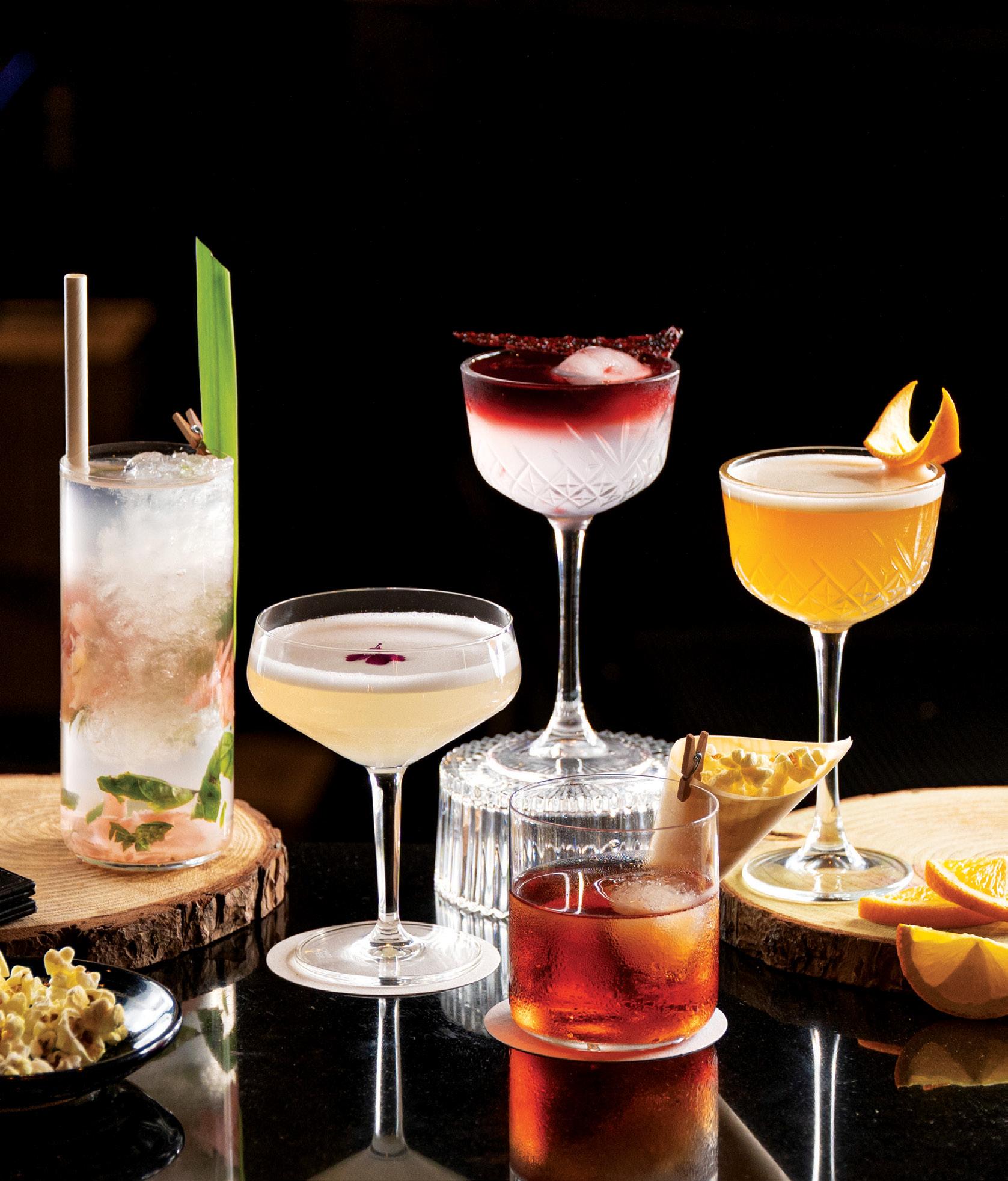
track KPIs like sales trends, guest feedback, and inventory turnover. These insights guide our decisions and allow us to keep refining our offerings. When it comes to cost management, we adopt a data-driven approach. We track P&L based on meal periods, use weekend vs. weekday sales analysis, and calculate ROAS (Return on Ad Sales) for our social media campaigns. Our three seatings starting from 5 pm maximise guest engagement, and tracking these metrics helps us fine-tune pricing and optimise inventory to boost profitability.
How do you measure the success of your bar and beverage program and make data-driven decisions?
Rakesh Shetty: We track customer preferences, sales data, and feedback from both guests and the industry closely. This data helps us refine our menu and offerings, ensuring that we remain relevant while maintaining profitability.
Yogesh Sonawane: Success is measured not only in numbers but in the smiles and satisfaction of our guests. We track key performance indicators such as sales, customer satisfaction, and inventory management. These insights help us refine our offerings, ensuring every guest experience is elevated, every sip a memory in the making.


Srishti Sethia: We measure the success of our bar and beverage program through three core metrics—social media engagement, menu performance analysis, and guest feedback.
One of the most significant indicators of our success is social media engagement, where we closely monitor how our drinks and experiences resonate with our online audience. In today’s digital age, platforms such as Instagram and Facebook serve as powerful tools for gauging the impact of our offerings. High levels of engagement, including likes, shares, and positive comments, provide us with valuable insights into which cocktails and beverage experiences are capturing the interest and excitement of our patrons.
Another critical factor in measuring success is menu engineering, a strategic process that involves analysing the performance of various menu items. By assessing which drinks are selling well, identifying trends in guest preferences, and pinpointing areas where certain offerings may need improvement, we can make informed decisions about which beverages to retain, modify, or replace. This detailed analysis helps us strike a balance between popular, revenue-generating items and innovative, trend-setting cocktails, ensuring that our menu remains both financially viable and creatively exciting.
Lastly, guest feedback plays an invaluable role in our success metrics. We place great importance on the opinions of our guests, actively seeking out their thoughts on the beverages they’ve enjoyed and the overall bar
“We believe every guest deserves a moment of magic. From a
warm
welcome to
personalised drink recommendations,
we
tailor each interaction. Our bartenders often craft bespoke cocktails on the spot, ensuring every drink is a reflection of their tastes and desires.”
experience. Whether it’s direct conversations with patrons, reviews, or feedback forms, the insights we gather help us understand the impact of our service and product offerings on a personal level. Guest feedback also serves as a compass, guiding us in the right direction when it comes to updating the menu or launching new beverage initiatives.
Rohan Rege: For us, it’s not about how many cocktails we have sold but how many repeat guests we’ve been getting at the bar. More the repeat clientele, more is the cocktail/beverage sale and better is the popularity. Our beverage program starts from the bartenders’ communication, followed by the stories and memories of each bartender with every cocktail listed in the menu—and ends at returning guests. A particular menu stays in our bar for six months, post which the high- moving items are retained, and the rest get replaced.
Noel Mendes: We measure the success of our bar programs through several key performance indicators. Footfall, cover turnover, and guest satisfaction surveys give us a clear picture of how our offerings are resonating with
our audience. By tracking social media engagement and ROAS from targeted ad campaigns, we ensure that our marketing efforts are effective and aligned with our goals.
Can you elaborate on your process for creating signature cocktails and other unique beverage offerings?
Yogesh Sonawane: Our signature cocktails are inspired by the essence of French zest—elegance, style, and a celebration of culture. We start with a concept, often drawn from the seasons or local festivals, and then build flavour profiles around it. Fresh herbs, exotic spices, and top-tier spirits are our canvas, allowing us to create drinks that are vibrant, balanced, and deeply rooted in the region. Each cocktail is a journey, offering a taste of something beautifully unexpected.
Rohan Rege: The signatures can only be called signatures if you have a story to tell behind every cocktail. And, not to forget the current trend to attract the Gen Z, we use unique flavour ingredients found in local markets or houses.
Noel Mendes: At AER, where we align the bar’s nautical theme with the changing weather patterns, our menu is influenced by the clouds that a sailor during their sail. We categorise cocktails into Clear Skies, Thunderheads, Cumulus, and Monsoon, reflecting the mood and intensity of each weather type. This dynamic curation ensures that every six months, our menus feel fresh and exciting.
How often do you update your menus and what influences those changes?
Rakesh Shetty: Changes are driven by seasonal ingredients, guest feedback, and current trends.
Yogesh Sonawane: Our menus
are updated seasonally, ensuring they remain dynamic and reflective of the current trends. Whether it’s a shift in guest preferences or new local ingredients becoming available, our menu evolves to keep the experience fresh, engaging, and always in tune with the brand spirit.
Sristhi Sethia: Our bar and restaurant menus are thoughtfully curated to reflect both our team's creativity and each outlet's unique identity. Our renowned Blue Bar features seasonal cocktails, transitioning from light and refreshing in the warmer months to warming and comforting in the colder months. Our restaurants—Loya, Spicy Duck, and Orient Express—offer annual menu updates, driven by a collaborative process between our chefs, mixologists, and creative teams. This ensures each menu remains timely and authentic to the restaurant's culinary philosophy, enhancing the guest experience while staying true to its story.
Rohan Rege: Goa is a booming market with many competitive bars rising up to the game—and it’s very important to be in that game. Therefore, we update our menus twice a year and it is always about the variety of clientele we serve in during season and also in the off season.
What are your thoughts on the growing trend of incorporating sustainability in bars? Do you use local and native ingredients from the region the hotel is in, in your bar program?
Rakesh Shetty: Sustainability is more than just a trend—it’s a responsibility. By using local ingredients and minimising waste, we contribute to a more sustainable future. For example, we create our own infusions using local herbs and botanicals, ensuring that our cocktails are both innovative and environmentally conscious.


Yogesh Sonawane: From reducing waste to sourcing local ingredients and eco-friendly packaging, we are committed to making our bar operations as green as possible. We celebrate the richness of local ingredients in every cocktail. From fresh mangoes and lemongrass to tamarind and turmeric, we use the bounty of India to create drinks that are vibrant and full of character. Our house-made infusions—like our turmeric-infused gin—are a perfect example of how we blend the traditional with the modern to offer our guests something truly special.
Srishti Sethia: The cocktail scene is evolving, with a growing emphasis on sustainability, innovation, and convenience. Modern drinkers seek cocktails that not only taste exceptional but also reflect eco-conscious practices and tell a compelling story about their ingredients. This includes sourcing local and organic products, reducing waste, and utilising sustainable packaging.
Sustainability is quickly becoming essential to a thoughtful, modern cocktail experience. A good story enhances the guest experience, and sustainability plays a major role in crafting that narrative. Whether it's through locally sourced ingredients, minimising waste, or employing ecofriendly practices, sustainability adds depth and meaning to our beverage program. We've found that sustainable cocktails resonate strongly with guests, especially when communicated effectively. We highlight our initiatives in-house, on social media, and through other channels to ensure wider visibility and engagement. By sharing the philosophy behind these cocktails, we forge a connection between the drink and the guest, making sustainability an integral part of their experience.
At Loya Bar, we use local and native ingredients inspired by the rich culinary traditions of northern India. This aligns with our sustainability
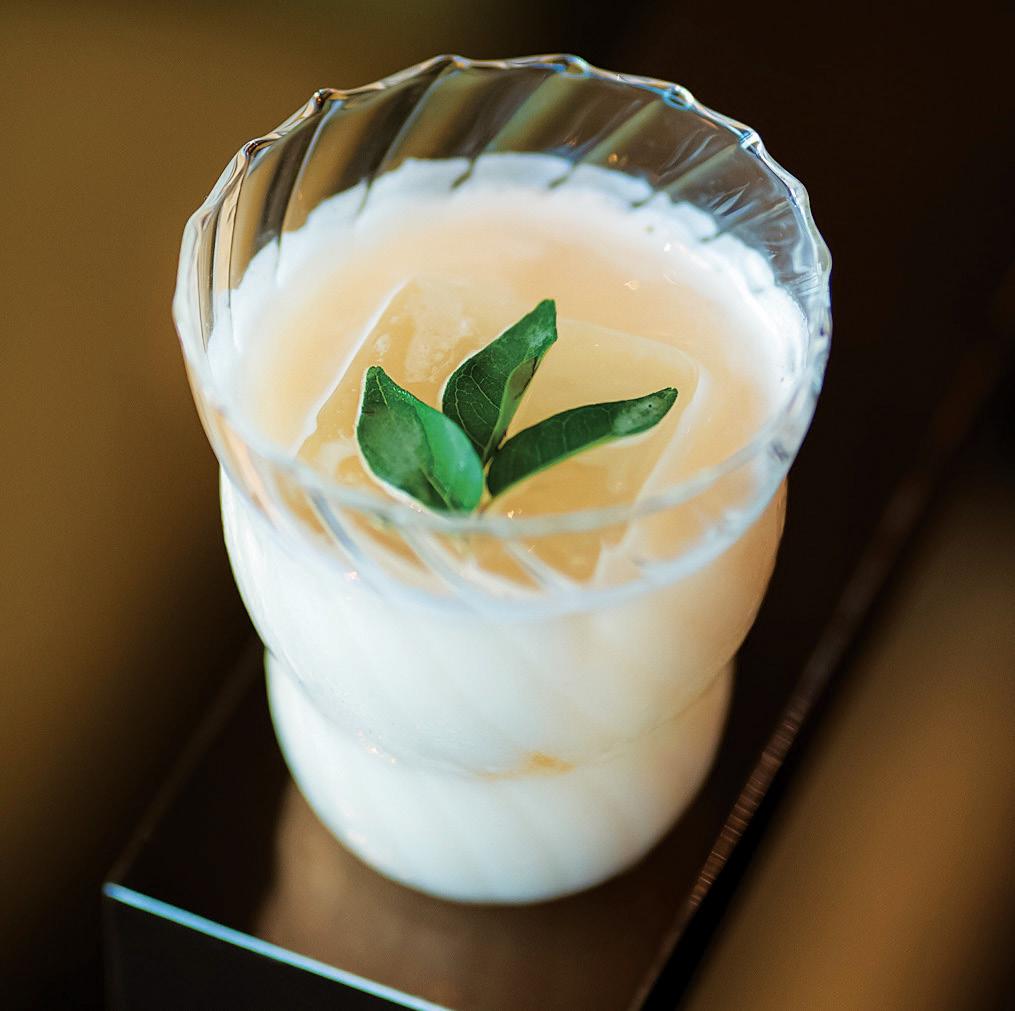
“Collaboration is the key to our beverage program. We work closely with local distilleries, drawing inspiration from seasonal ingredients and trends observed at industry trade shows.”
philosophy and allows us to craft cocktails deeply connected to regional flavors. Examples include our timbru-infused gin (using a local spice), kinnow syrup (made from a local variety of orange), and gal-gal foam (a light, zesty foam made with a regional lemon).
Noel Mendes: There is a greater focus on low-alcohol and sustainable cocktails, reflecting the growing demand for wellness and mindful drinking. Sustainability is a key focus for us, starting with sourcing ingredients responsibly and minimising waste. At AER, we prioritise locally sourced spirits from India over imports, reducing our carbon footprint and supporting local distilleries. By minimising the need for overseas transportation, we help decrease the environmental impact associated with global warming. We will grow fresh herbs in our rooftop garden and create housemade infusions with native Indian spices, adding a distinct regional flavour. In the upcoming Gimlet Garden, we repurpose ingredients— using fruit skins for perfumes, syrups, tinctures, and garnishes— and compost leftover produce to fertilise botanicals at Modernist, our members-only lounge. Our hotel-wide composting program turns food waste into fertiliser for the farm that supplies our produce, completing the sustainable loop and further reducing our environmental impact.
While the biggest weddings grab the most attention, weddings come in every size in India, significantly boosting economies.
SUMAN TARAFDAR
Yep, the peak for travel and hospitality sectors in India is back for its next season—a significant proportion of it riding on weddings. The bigger and the fatter, the better for travel and hospitality seems to be the thought. Estimating the actual size of the space is often conjectural, with figures ranging from $130 billion to even $1 trillion!
A report from Jefferies Group, an American multinational investment bank, indicates the average Indian spends ₹12 lakh, or roughly $15,000, on a wedding, more than the amount spent on
18 years of a child’s education. India’s wedding spend-to-GDP ratio stands at 5x, significantly higher than several other economies, according to the report.
The report also estimates that India hosts about 80 lakh to one crore weddings annually, arguably the largest globally. About half the annual average spend on jewellery happens in this season, along with about 10% of apparel sales.
A survey by the Confederation of All India Traders (CAIT) revealed that approximately 3.5 million weddings were hosted between November 23, 2023, and
December 15, 2023, a 23-day period, generating a substantial economic upturn in the industry. The CAIT Research & Trade Development Society survey projected a flow of around US$ 57.2 billion (₹4,74,000 crore) in wedding-related expenditure and services.
Of course, as the recent big-ticket Ambani jamboree indicated, weddings today encompass a wide array of services such as event planners, entertainment and global cuisines, often as part of destination weddings.

The average wedding spend in India is Rs1.2mn (US$15k) this is over 5x India's GDP per capita of ~US$2.9k.
Source: Confederation of All India Traders (CAIT), Jefferies

The wedding industry generates almost 10 million jobs in India, directly employing individuals. Wedding planners, photographers and videographers, caterers and decorators, make-up artists hairstylists, musicians, entertainment professionals, artisans and craftspeople are involved in creating wedding essentials, which also leads to indirect employment.
Several sectors are directly impacted by the wedding market. This includes hospitality. Estimates indicate that hotel rooms worth $603 million (₹5,000 crore) are booked for weddings in a year. Destination weddings, too, create a boost, especially for the tourism sector. The demand for wedding attire, jewellery, decorations, and other related
Source: The Knot Worldwide, Company Report (2022), Australian Securities and Investments Commission (ASIC), IMF, Jefferies

When compared to other retail/consumption categories, weddings rank second only to food and grocery.
Source: DRHPs, Jefferies
BREAKDOWN OF WEDDING INDUSTRY SPENDS (US$BN)
Weddings are a key driver of discretionary consumption in India, especially for categories such as jewellery, apparel, catering, etc.
TO $25
DECOR
$9 TO $10
APPAREL
$9 TO $10
PHOTOGRAPHY $10 TO $12
A report from Jefferies Group, an American multinational investment bank, indicates the average Indian spends ₹12 lakh, or roughly $15,000, on a wedding, more than the amount spent on 18 years of a child’s education. JEWELLERY
TO $20

GLOBAL COMPARISON OF WEDDING SPEND (US$K) AND WEDDING SPEND TO GDP PER CAPITA RATIO (X)
Source: The Knot Worldwide, Company Report (2022), Australian Securities and Investments Commission (ASIC), IMF, Jefferies
Weddings account for nearly half of jewellery industry spends and >10% share of apparel industry spends.
items fuels the growth of the retail industry. The logistics sector also benefits due to increased demand for transportation services, including shipping weddingrelated goods. This trend creates opportunities for specialised services in event setup. Other sectors also benefit from the above-average spending on wedding-related objects and services.
The Union Ministry of Tourism has unveiled a comprehensive campaign to position India as a prominent global wedding destination. This initiative aims to strategically enhance tourism by promoting the country as an attractive venue for weddings on an international scale.
Source: RBZ Jewellers DRHP, Jefferies


The new enhanced role of the operations team and AI in driving hotel success.
In the ever-evolving landscape of hospitality, does the sales team truly hold the key to a hotel's success? This might sound contentious and could ruffle some feathers, but bear with us.
To delve deeper, we need to first understand what drives hotel room sales. Generally, there are two scenarios: in the first, the hotel's product, services, location, and F&B offerings are so exceptional that they essentially sell themselves, particularly when
the competition is lacking. This hotel will probably be able to sell itself as the demand would be high enough to get the footfalls.
The second scenario is more challenging—here, the market conditions demand an extra push, either because the hotel's product is outdated or simply not as competitive, or because the competition is equally strong, forcing the hotel to fiercely contend for its share of the market. The market would need
a hotel expert to drive business, the operative word being ‘a hotel expert’, and that could be an operations executive/manager.
Traditionally, a sales team has been seen as the driving force behind filling rooms, organising events, and forging partnerships. But, as the industry evolves, this conventional wisdom warrants a closer examination. Let's consider a few key reasons why a dedicated sales team might not be as crucial as once thought:
Who better to sell the hotel than the people who run it? Operations managers have an intimate understanding of the hotel's strengths and weaknesses, guest preferences, and operational intricacies. They can provide authentic, detailed insights to potential clients, which can be more persuasive than a sales pitch. Their direct involvement in day-today operations also means they can quickly adapt offers and services to meet guest needs, ensuring a personalised approach that resonates with today’s travellers.
In a case like this, is sending the sales representative to pitch or close the deal ideal? An operations manager taking the lead could facilitate immediate decision-making, especially when a potential client has detailed or unique requirements. This could reduce the back-and-forth that sometimes occurs between sales and operations teams when questions arise. The sales team has limited operational knowledge like that of room category availability, logistical challenges such as room configurations, staff capacity, service timing, or the feasibility of fulfilling specific requests practically.
Today, a significant portion of hotel bookings is driven by online platforms—OTAs (Online Travel Agencies), metasearch engines, and even direct website bookings. These platforms not only provide global reach but also offer sophisticated targeting and analytics tools that a sales team simply cannot match. With well-optimised digital strategies, hotels can attract and convert guests without the need for a large sales force.
With AI-driven data available, does one really need the sales team to decipher it and decide rates (with the revenue management team, of course) or can the operational team take decisions on the spot?AI can analyse vast amounts of data to identify guest preferences and behaviour. By analysing factors such as search behaviour, booking history, social media interactions, and even location-based data, AI can predict which demographics are most likely to book a stay. This enables hyper-targeted marketing, ensuring the sales team reaches the right audience.
AI can help personalise offers and promotions by understanding individual guest choices, such as favourite room types, dining preferences, or even preferred travel times. Tailored marketing messages can be sent to potential guests at the right time, increasing the chances of conversion. AI can dynamically adjust room rates based on demand, competitor pricing, and guest behaviour. This maximises revenue and attracts the right guests at the right time, creating a balance between filling rooms and optimising price points. AI-powered CRMs can provide the sales team with real-time insights into guest preferences and booking behaviour, allowing for more personalised conversations.
When a sales representative reaches out to a potential guest, they’ll have detailed information at their fingertips, including which amenities or services that are most appealing to a particular guest. AI systems can provide sales teams with actionable recommendations based on guest data. For instance, if a potential guest prefers luxury services, AI can suggest premium packages or upsell opportunities during the sales pitch. This would allow the operations team to deliver a more compelling and relevant offer.
In an era where reviews and word-of-mouth can make or break a hotel's reputation, the focus should be on delivering an exceptional guest experience. A great experience naturally leads to repeat business and positive reviews, which are powerful drivers of new bookings. By investing in training and empowering staff to provide outstanding service, hotels can create brand advocates out of their guests, reducing the reliance on traditional sales efforts.
What would work better—cold calling or delivering exceptional service? Delivering exceptional service often has a far more lasting impact, especially in the hospitality industry where personal experiences matter. While cold calling might help bring in leads, it can feel impersonal and lacks the trust that comes from actually staying at the hotel and experiencing great service. On the other hand, when a guest receives exceptional care, they're more likely to remember it, tell their friends, and come back again.
An operations manager plays a key role in making sure the promises made by the sales team are realistic and achievable. By avoiding over-promising, operations managers help ensure guests aren’t disappointed, which is crucial for maintaining trust. When guests get exactly what they were told to expect—sometimes even more—it builds a sense of reliability and loyalty that no cold call can match. People are more likely to return to a place that delivers on its promises, and word-of-mouth from satisfied guests is one of the most powerful tools a hotel can have.
4.
5. 3.
Maintaining a dedicated sales team can be expensive, especially for smaller or independent hotels. These resources could potentially be better allocated to areas that directly impact guest satisfaction, such as room upgrades, staff training, or technology enhancements. In many cases, these improvements can have a more direct and sustainable impact on occupancy and revenue than sales efforts.
Would re-looking at budgets and allocations for the sales team make sense so that resources could be better used in guest areas?
While corporate accounts and group bookings were once the domain of sales teams, today’s business landscape has shifted. Companies are increasingly looking for flexible, scalable solutions, often facilitated through technology platforms. Operations managers, who understand the full scope of what the hotel can offer, may be better positioned to tailor these solutions, ensuring they meet both the client's needs and the hotel’s operational capabilities.
Would the operations team be in a better position to actually understand the requirements of corporate guests better and meet them?
Modern hotel management systems provide detailed data on guest behaviour, preferences, and trends. This data can be leveraged to create highly targeted marketing campaigns and personalised guest experiences, often with better precision than traditional sales tactics. Operations managers, with their handson approach, are in a unique position to use this data to drive both occupancy and guest satisfaction.
AI is not just the future anymore, it is the present. How well we are able to leverage this tool is what will define our scope of possibilities in the future.
While sales teams have traditionally played a key role in hotel success, the evolving dynamics of the industry suggest that their role might not be as pivotal as before, and the time may have come to rethink the need for a dedicated hotel sales team.
The key question to ask is: why hotels predominantly hire sales executives and managers from within the hospitality industry, rather than tapping into dynamic sales professionals from other sectors such as telecom, insurance, or FMCG—industries known for their aggressive, target-driven sales approach. Salespeople in these fields are conditioned to ‘walk the talk’ and hustle for business, often in high-pressure environments.
Their core competencies lie in closing deals, building client relationships, and consistently driving results. In contrast, hotel sales teams can sometimes become too comfortable, working from the air-conditioned comfort of their offices and luxury hotels, focusing more on relationship management than aggressively pursuing new business. Bringing in fresh talent from outside the industry could inject a sense of urgency, energy, and new sales tactics into the hospitality sector. These professionals from sales-centric industries are often adept at overcoming tough objections, managing high volumes of clients, and thinking outside the box—all skills that could be highly beneficial to hotel sales teams. By broadening the talent pool and embracing a more dynamic sales mentality, hotels could potentially unlock new opportunities and a more aggressive approach to growth.
Here’s a thought to not make the sales team entirely redundant: build a more agile, nimble, or perhaps even smaller sales team that is more in touch with what’s happening on the ground. Creating a roadmap on how divisions can work together to ensure better effectiveness would help understand the gaps and loopholes in the sales teams’ structure and culture. Adding people from other industries could be another way to stir things up a bit! In our humble opinion, currently in hotels, sales managers are mostly capable of selling themselves and not necessarily the hotel.
Manav Thadani, Founder and Chairman at Hotelivate, is a hospitality consultant, hotel owner, restaurant partner, food critic, uncensored speaker and occasional stage performer. Aatreyi Dhar is the Associate Director - Special Projects , Hotelivate. She has extensive experience in hospitality management, including her tenure at Oberoi Hotels and an MBA from Les Roches, Switzerland.
What does the passing of a much-loved/wellappreciated airline mean to its frequent flyers? As Vistara’s almost decadeold journey ends, we look back at an airline consensually agreed to as ‘India’s best’.


Vistara, India’s best airline. Those words are going to be history very soon. Even more amazingly, this wrapping up is a voluntary step—taken by owners Air India and Singapore Airlines (SIA). Incidentally, this ‘best airline’ award is agreed upon by the most important demographic— the passenger. As to how rare it is for the best to be wrapped up without a financial reason to do so—there is no precedence in history!
Vistara’s last flight will be on November 11. Its fate was sealed officially in November 2022, when Tata Group and SIA confirmed the merger of the two airlines. Official merger, anti-trust and bureaucratese over, the airline is set to fly into history. At the time the merger was announced, Vistara was the most preferred domestic airline, anecdotally speaking, while Air India was beset by massive issues, and flew making a loss of ₹11,381 crore in FY’23, widely seen as ‘a cautionary tale of decline’. Yet, the decision was to let the better-performing airline go.

AI is on an ambitious five-year turnaround plan, hugely capital intensive, and CEO Campbell Wilson has already revealed extensive plans, detailing livery, cabin designs, crew uniforms, meals, brand refresh, new customer services, et al.



Vistara is not leaving without a legacy though. I can look back on the almost decade-long run with largely fond memories. It was easily the airline of choice for most Indians, almost from its inception. I was there in August 2014 when the airline's name and logo were revealed. I was fortunate enough to experience its flights from an early stage, and still remember my first experience of the modern cabins, resplendent in purple and gold. I remember flying with Phee Teik Yeoh, the inaugural CEO on Vistara’s first flight to Goa. Seated on 1A, with him on the adjoining seat, I asked him why there were no screens on what was otherwise an unprecedented level of cabins in the Indian domestic aviation space. His reply was futuristic—that flyers would prefer to stream on their own devices, which has turned out to be true, while the airline saved millions.
The experience of the premium economy cabins was novel, as were freebies such as free Starbucks coffee. The inflight meals, especially in the early years, were fantastic. The cabin crew seemed better groomed and confident enough to suggest which meal option was better—there used to be multiple choices in the initial years. The pilots were well-spoken, often sharing more about the flight path than one was used to, especially on the airline’s first route—DEL-BOM. The inflight entertainment app worked great and was a much better choice than the competition. Its on-time performance has remained the best for the better part of the decade. It remained largely in the red financially, though the promise of profitability long seemed possible. Conceived as a premium airline for the business traveller, it could never charge the rates it should have as a full-service carrier, even as its services were far more extensive than competition.
Vistara ended its first year with just about 2% of market share by number of domestic passengers flown. It is ending with nearly 9% of the domestic market, making it the second largest airline, only after Indigo.

Vistara was an early adopter of multisensory techniques to enhance the flying experience.
BrandMusiq’s Rajeev Raja, who designed Vistara's signature sound, says: “The name came from Sanskrit. While it had a strong Indian soul, Singapore Airlines gave it a global aura. So, the sound we had to create was the global citizen with an Indian soul— the exploring nature of the global citizen, with no boundaries while travelling across the world.
“Virtually, it was Taj hospitality in the air. When we put all this together, the avatar and rasa revealed themselves; the caring of hospitality with the daring, the liberty of travel. The music had to convey that. The caring aspect came from the Indian female voice who delivered the basic melody. The rest of the track had a lot of world music elements—cajon, jazz, piano, and some digital elements to give modernity. It was a clever use of harmony to indicate the elevation of the flight soaring into the air. The 'raa ra raa raa' subtly connected with Vista-raa.” Yet another aspect of the airline that will be missed.

It had an initial order of 13 planes, and the arrival of each made news. Now it has 70 aircraft (53 Airbus A320neo, 4 Airbus A321LR, 6 Airbus A321neo and 7 Boeing 7879). Even though it has merged with Air India, there are multiple routes on which it has a larger service than AI, including India’s busiest, Delhi-Mumbai. Of the average of 55 flights that fly between two of India’s largest cities, Indigo has 20, Vistara has 17 and Air India has 12. As of January this year, the airline flew to 50 destinations in 12 countries. Even though it was never part of Star Alliance, which both AI and SIA are, it has numerous codeshare and interline agreements with most of the leading airlines of the world.
The airline was the first to introduce premium economy cabins in India.
It was, and remains, the only airline in India to have a three-cabin configuration.
In January 2015, Vistara was the first airline to operate domestic services out of the new Terminal 2 at Mumbai's Chhatrapati Shivaji Maharaj International Airport.
It was the first airline in India to transition to an all-new fleet of Airbus ‘neo’ family for its narrow-body operations, on average remaining the airline with the youngest aircraft.
Under the new National Civil Aviation Policy of 2016, which removed the five-year rule for flying internationally, Vistara was the first airline to benefit from the changed policy when it began its international services in August 2019.
Its lounge at Delhi Airport became the first to be next to the departure gates
Vistara was the first domestic airline to induct the Boeing 787-9 a.k.a. Dreamliner as well as the A321LR.
Its homage to Indian aviation pioneer JRD Tata through its livery on VT-ATV, an A32neo, was unique.
It was the first Indian airline to offer flatbeds on narrowbody aircraft–on offer in its A321neo, flying to mediumhaul international routes.
Conceived as a premium airline for the business traveller, it could never charge the rates it should have as a full-service carrier, even as its services were far more extensive than competition.

So, what will remain of Vistara’s legacy in Air India? Not much, chorus avgeeks mournfully. AI is on an ambitious five-year turnaround plan, hugely capital intensive, and CEO Campbell Wilson has already revealed extensive plans, detailing livery, cabin designs, crew uniforms, meals, brand refresh, new customer services, et al. Tata Group CEO Natarajan Chandrasekaran’s mandate is clear, the need ‘to build a world-class airline’, which he underscored when the new AI logo was revealed in August 2023. No mention of Vistara was made at the event.
Vistara’s CEO Vinod Kannan has been quoted saying, “What has been acknowledged by Campbell (Wilson) and the Air India team is how they can bring Air India up to the same standard (as Vistara), and that is what they are working on. That is what we hope will happen with the integration”.
Not many flyers are as sanguine about AI being Vistara’s standards. Early tests will come when the operational mergers happen—ticketing, flights, loyalty points, branded cards, lounge access, etc. While no layoffs are expected—indeed AI has been on a hiring spree, the transfer and merger of ‘soft skills’ will be tested by flyers. The only experience AI has of the merger is when it was merged with the larger Indian Airlines by the Ministry of Aviation, a process that was marked by long-standing bitterness. Perhaps the Tatas will manage this challenging process better.
Many Indian airlines have already flown into history, from the early Damania Airways and Modiluft to Kingfisher, and more recently, Jet Airways and Goair (both are comatose at the moment). Sahara Airlines and Deccan Air were merged, only for the parents to disappear as well. The departure of Vistara feels different. As I flew for the last time from Mumbai to Delhi on UK996 recently, it was perhaps for the first time that I was reluctant to exit the plane at all! Scratch that, I absolutely was. I took not just the magazine, but just about everything I could—down to the napkin and the coffee stirrer! Thankfully, YouTube ads still offer booking offers on Vistara, well after the September 3 deadline!
The name Vistara is derived from the Sanskrit vistaar or a limitless expanse, according to the airline. The realities of aviation have brought an end to this expanse for now. We shall soon have to accept planes that once proudly sported the Vistara name fly about nameless, such as former AirAsia India aircraft.
Vistara flights (9 January 2015 - 11 November 2024). RIP. You shall be missed. And remembered. And benchmarked with for the future.
BY DEEPALI NANDWANI

A slice of the inflight food business is dominated by celebrity chefs. This really tiny sliver of inflight dining is one of the most inventive even if it serves diners at an altitude of 30,000 feet. This elevated dining experience has attracted some of the best chefs. Singapore Airlines boasts a culinary panel of seven worldrenowned chefs, including Masterchef Italia judge Carlo Cracco and French Grandmaster Georges Blanc, whose restaurants collectively hold 12 Michelin stars. Passengers flying from Singapore to India can even savour Indian chef Sanjeev Kapoor’s Shahi Thali. Air France also offers a taste of Michelin-starred excellence with meals from 10 acclaimed chefs, including AnnSophie Pic. This exclusive club of airlines is transforming air travel into a gourmet adventure.
Goa lays claim to being home to India’s first Agave bar. Barfly, the buzzing fun bar in Assagao, Goa’s villa and restaurant stretch, is dedicated to serving agave-based spirits such as tequila and mescal. Simply called Mr. Agave, the bar goes beyond serving traditional agavebased cocktails. It offers artisanal, handcrafted drinks that reference the heritage and craft of Mexican spirits. The bar is designed to create an immersive experience around agave spirits, much like a Mezcaleria or tequila bars of Mexico, and is part of the broader interest in niche spirits, craft cocktails, and authentic drinking experiences in India.
It is a well-known fact that saffron, grown in Kashmir and some other parts of the world, is the most expensive spice. But did you know that this ‘red gold’ is also a hardy crop that, most likely, will weather climate change? It can withstand extremely cold temperatures but dislikes warm, humid conditions. Modern chefs are using the spice in the most inventive ways in their menus. Britain’s famous chef Heston Blumenthal uses it as a key ingredient in a fantastical ‘Nitro-poached Aperitif’ where its delicate aroma mingles with the sweetness of vanilla. Across the continent, in a Michelinstarred restaurant in Portugal, Nuno Mendes pairs saffron’s earthy notes with the smokiness of eel and the briny freshness of sea urchin. In India, Manish Mehrotra had reimaged the traditional Indian sweets at Indian Accent as Saffron Milk Pudding, topped with rose petal jaggery brittle.
A quirky fact about Khajuraho, a UNESCO World Heritage Site in Madhya Pradesh, is that its famous temples, adorned with intricate erotic sculptures, make up only 10% of the total carvings. While the site is widely known for its erotic depictions, the majority of carvings at Khajuraho celebrate daily life, spirituality, and mythological scenes, showcasing the skilled craftsmanship of the artisans and the cultural diversity of the time.

PRESENTED BY

